GAIA Astrometry Mission
Non-EO
ESA
Operational (extended)
ASTRIUM
Quick facts
Overview
| Mission type | Non-EO |
| Agency | ESA, ASTRIUM |
| Mission status | Operational (extended) |
| Launch date | 19 Dec 2013 |
Gaia Astrometry Mission
Spacecraft Launch Mission Status Payload Module Ground Segment Big Data Archive References
Gaia (mother Earth in Greek mythology) is an ESA cornerstone space astrometric mission, part of the Horizon 2000 Plus long-term scientific program, with the goal to compile a 3D space catalog of > 1000 million stars, or roughly 1% of the stars in our home galaxy, the Milky Way. Gaia will monitor each of its target stars about 70 times to a magnitude of G=20 over a period of 5 years. It will precisely chart their positions, distances, movements, and changes in brightness. It is expected to discover hundreds of thousands of new celestial objects, such as extra-solar planets and brown dwarfs, and observe hundreds of thousands of asteroids within our own Solar System. The mission will also study about 500,000 distant quasars and will provide stringent new tests of Albert Einstein’s General Theory of Relativity. 1) 2) 3) 4) 5)
Cataloguing the night sky is an essential part of astronomy. Before astronomers can investigate a celestial object, they must know where to find it. Without this knowledge, astronomers would wander helplessly in what Galileo once termed a ‘dark labyrinth’.
During the satellite’s expected lifetime of five years, Gaia will observe each star about 70 times, each time recording its brightness, colour and, most importantly, its position. The precise measurement of a celestial object’s position is known as astrometry, and since humans first started studying the sky, astronomers have devoted much of their time to this art. However, Gaia will do so with extraordinary precision, far beyond the dreams of those ancient astronomers.
By comparing Gaia’s series of precise observations, today’s astronomers will soon be able to make precise measurements of the apparent movement of a star across the heavens, enabling them to determine its distance and motion through space. The resulting database will allow astronomers to trace the history of the Milky Way.
In the course of charting the sky, Gaia’s highly superior instruments are expected to uncover vast numbers of previously unknown celestial objects, as well as studying normal stars. Its expected haul includes asteroids in our Solar System, icy bodies in the outer Solar System, failed stars, infant stars, planets around other stars, far-distant stellar explosions, black holes in the process of feeding and giant black holes at the centers of other galaxies.
The primary mission objectives are:
• Measure the positions and velocity of approximately one billion stars in our Galaxy
• Determine their brightness, temperature, composition and motion through space
• Create a three-dimensional map of the Galaxy.
Additional discoveries expected:
- hundreds of thousands of asteroids and comets within our Solar System
- seven thousand planets beyond our Solar System
- tens of thousands of ‘failed’ stars, called brown dwarfs
- twenty thousand exploding stars, called supernovae
- hundreds of thousands of distant active galaxies, called quasars.
The Gaia objective is to provide a very accurate dynamical 3D map of our Galaxy by using global astrometry from space, complemented with multi-colour multi-epoch photometric measurements. The aim is to produce a catalog complete for star magnitudes up to 20, which corresponds to more than one billion stars or about 1% of the stars of our Galaxy. The instrument sensitivity is such that distances beyond 20-100 kiloparsec (kpc) will be covered, therefore including the Galaxy bulge (8.5 kpc) and spiral arms. The measurements will not be limited to the Milky Way stars. These include the structure, dynamics and stellar population of the Magellanic Clouds, the space motions of Local Group Galaxies and studies of supernovae, galactic nuclei and quasars, the latter being used for materialising the inertial frame for Gaia measurements.
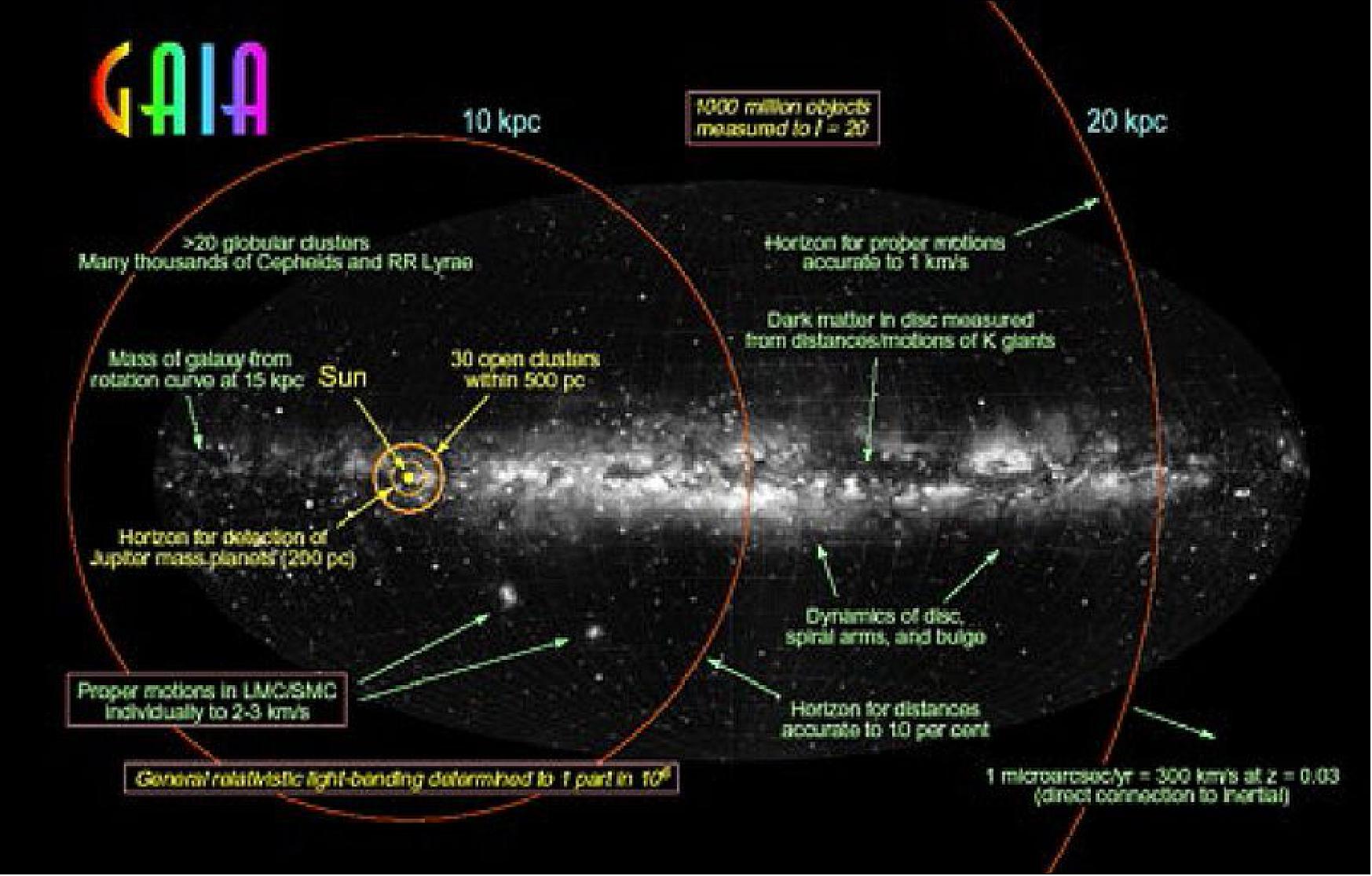
Background
Gaia is ESA's second space mission dedicated to astrometry. It builds on the legacy of the successful Hipparcos mission (1989-1993). 7) Like Hipparcos, Gaia's observation strategy is based on detecting stellar positions in two fields of view separated by a 'basic angle', which for Gaia is 106.5º. This strategy allows astronomers to establish a coherent reference frame over the entire sky, yielding highly accurate measurements of stellar positions.
After a detailed concept and technology study during 1998–2000, Gaia was selected as a confirmed mission within ESA’s scientific program in October 2000. It was confirmed by ESA’s Science Program Committee following a re-evaluation of the science program in June 2002, and reconfirmed following another re-evaluation of the program in November 2003. The project entered Phase-B2/C/D in February 2006. As of the summer 2012, Gaia is in Phase-D (Qualification and Production) and will be launched in the second half of 2013. 8) 9) 10)
• In June 2013, ESA's billion-star surveyor, Gaia, has completed final preparations in Europe and is ready to depart for its launch site in French Guiana. The Gaia spacecraft arrived in Cayenne, French Guiana, on August 23, 2013 on board the Antonov 124 aircraft.
• On Oct. 23, 2013, ESA postponed the launch of the Gaia mission. The decision was taken due to a technical issue that was identified in another satellite already in orbit. The issue concerns components used in two transponders on Gaia that generate ‘timing signals’ for downlinking the science telemetry. To avoid potential problems, they will be replaced.
The transponders were removed from Gaia at Kourou and returned to Europe, where the potentially faulty components were replaced and verified. After the replacements have been made, the transponders will be refitted to Gaia and a final verification test made. As a consequence of these precautionary measures, it will not be possible to launch Gaia within the window that includes the previously targeted launch date of 20 November. The next available launch window is 17 December to 5 January 2014. 11)
• Update Oct. 20, 2013: The upcoming launch manifest of Arianespace has now been established. Gaia is scheduled for launch on 20 December.
• Update Nov. 22, 2013: The checks on the Gaia satellite are proceeding well, enabling the launch to take place on December 19, 2013 (Ref. 11).
Some Astrometry Basics
The precise measurement of a celestial object’s position is known as astrometry, and since humans first started studying the sky, astronomers have devoted much of their time to this art. However, Gaia will do so with extraordinary precision, far beyond the dreams of those ancient astronomers (Ref. 21). 12)
By comparing Gaia’s series of precise observations, today’s astronomers will soon be able to make precise measurements of the apparent movement of a star across the heavens, enabling them to determine its distance and motion through space. The resulting database will allow astronomers to trace the history of the Milky Way.
In the course of charting the sky, Gaia’s highly superior instruments are expected to uncover vast numbers of previously unknown celestial objects, as well as studying normal stars. Its expected haul includes asteroids in our Solar System, icy bodies in the outer Solar System, failed stars, infant stars, planets around other stars, far-distant stellar explosions, black holes in the process of feeding and giant black holes at the centers of other galaxies. Gaia will be a discovery machine.
Stars as Individuals and Collectives
To understand fully the physics of a star, its distance from Earth must be known. This is more difficult than it sounds because stars are so remote. Even the closest one is 40 trillion km away, and we cannot send spacecraft out to them to measure as they go. Nor can we bounce radar signals off them, which is the method used to measure distances within the Solar System. Instead, astronomers have developed other techniques for measuring and estimating distances.
The most reliable and only direct way to measure the distance of a star is by determining its 'parallax'. By obtaining extremely precise measurements of the positions of stars, Gaia will yield the parallax for one billion stars; more than 99% of these have never had their distances measured accurately. Gaia will also deliver accurate measurements of other important stellar parameters, including the brightness, temperature, composition and mass. The observations will cover many different types of stars and many different stages of stellar evolution.
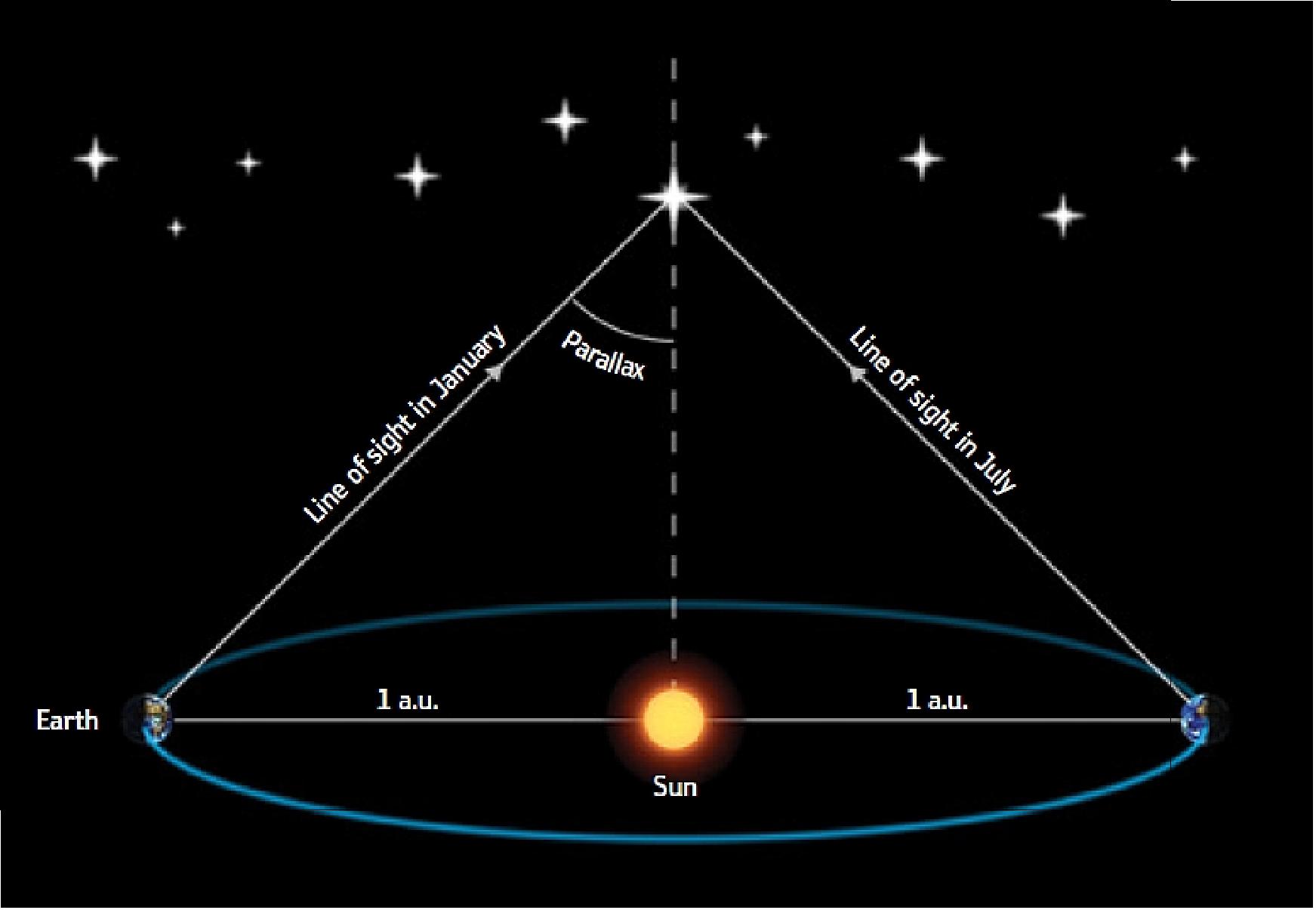
The Principles of Gaia
At its heart, Gaia is a space telescope – or rather, two space telescopes that work as one. These two telescopes use ten mirrors of various sizes and surface shapes to collect, focus and direct light to Gaia’s instruments for detection. The main instrument, an astrometer, precisely determines the positions of stars in the sky, while the photometer and spectrometer spread their light out into spectra for analysis.
Gaia’s telescopes point at two different portions of the sky, separated by a constant 106.5º. Each has a large primary mirror with a collecting area of about 0.7 m2. On Earth we are used to round telescope mirrors, but Gaia’s will be rectangular to make the most efficient use of the limited space within the spacecraft. These are not large mirrors by modern astronomical standards, but Gaia’s great advantage is that it will be observing from space, where there is no atmospheric disturbance to blur the images. A smaller telescope in space can yield more accurate results than a large telescope on Earth.
Gaia is just 3.5 m across, so three curved mirrors and three flat ones are used to focus and repeatedly fold the light beam over a total path of 35 m before the light hits the sensitive, custom-made detectors. Together, Gaia’s telescopes and detectors will be powerful enough to detect stars up to 400,000 times fainter than those visible to the naked eye.
Gaia uses the global astrometry concept demonstrated by Hipparcos. The principle is to link stars with large angular distances in a network where each star is connected to a large number of other stars in every direction. The condition of closure of the network ensures the reduction of the position errors of all stars. This is achieved by the simultaneous observation of two fields of views separated by a very stable basic angle. The spacecraft is slowly rotating at a constant angular rate of 1º/min around a spin axis perpendicular to both fields of view, which describe a great circle on the sky in 6 hours. The spacecraft rotation axis makes an angle of 45º with the Sun direction (Figure 3). A slow precession around the Sun-to-Earth direction, with a 63.12 days period, enables to repeat the observation of sky objects with 86 transits on average over the 5 years of mission.
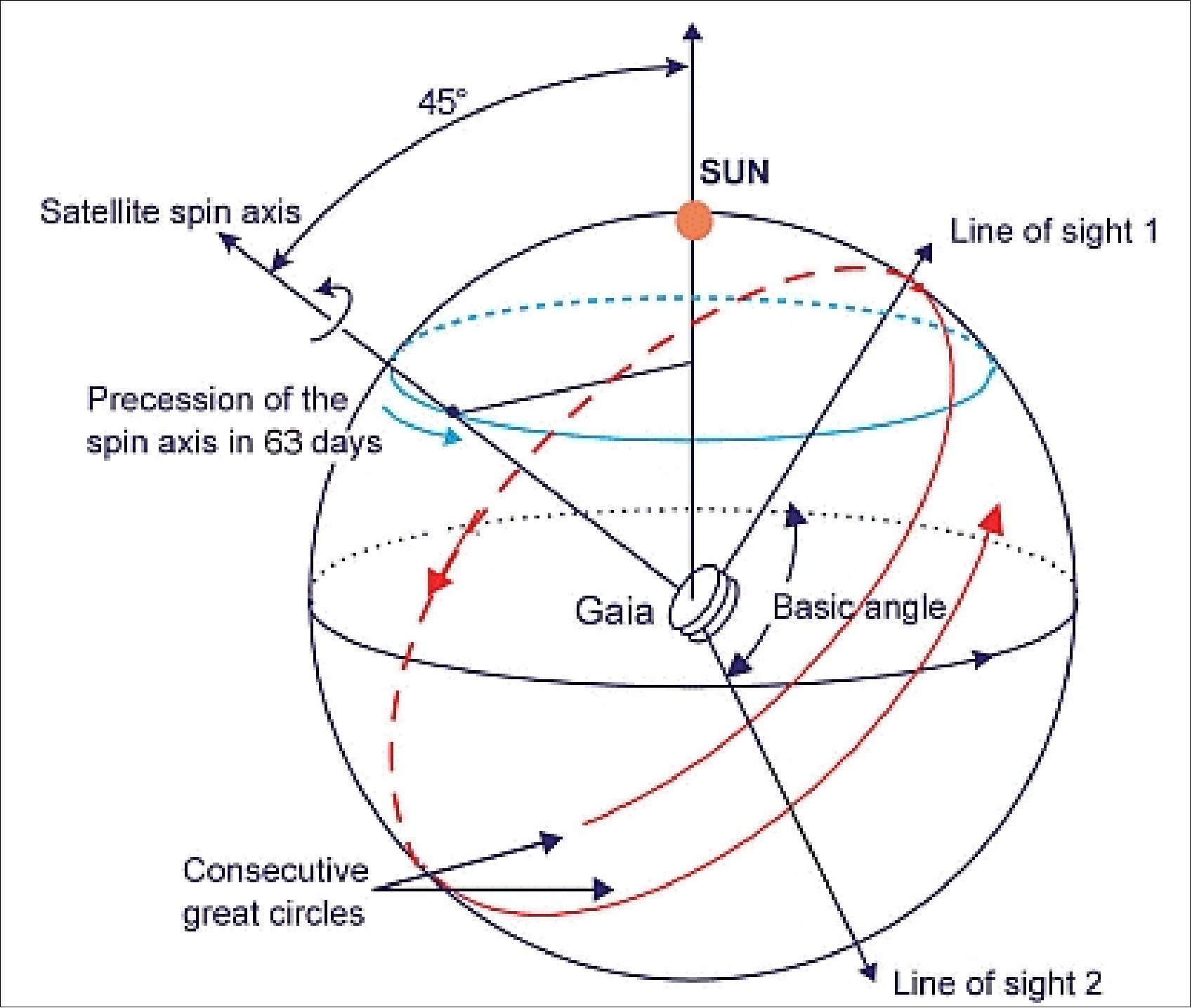
The resulting performance will enable a breakthrough in the astrometry field, as well regarding star position and velocity performance as for the number of objects observed.
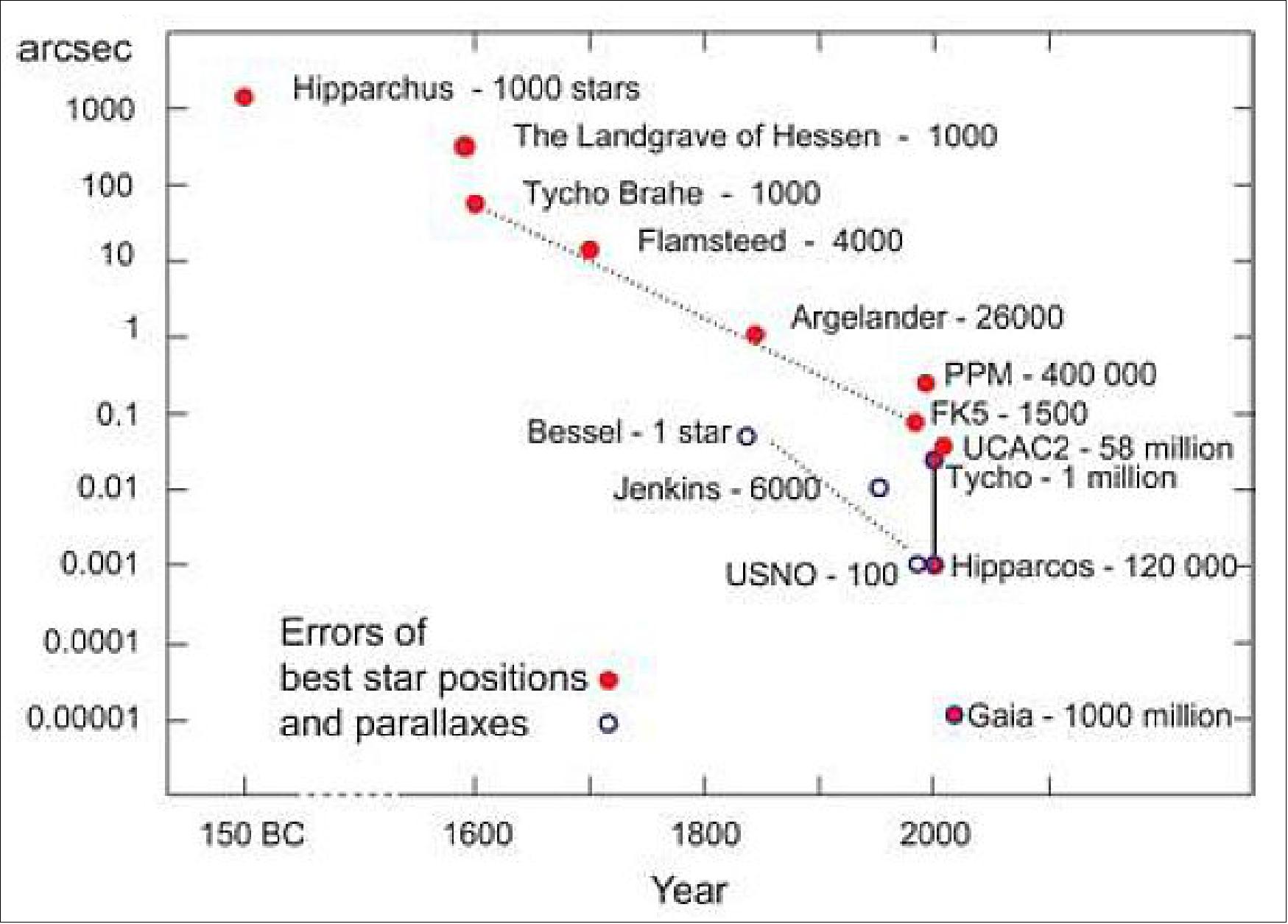
Spacecraft
Gaia is an exceptionally complex space observatory. ESA awarded Airbus Defence and Space (former Astrium SAS,Toulouse, France) the prime contract in May 2006 to develop and build the spacecraft. Together with the German and British branches of Astrium, more than 50 industrial subcontractor companies from across Europe are involved in building this discovery machine. The Gaia DPAC (Data Processing and Analysis Consortium) will process the raw data to be published in the largest stellar catalog ever made. 13) 14) 15) 16) 17) 18) 19) 20)
The Gaia spacecraft is composed of two sections: the Payload Module and the Service Module. The Payload Module is housed inside a protective dome and contains the two telescopes and the three science instruments. They are all mounted on a torus made of a ceramic material (silicon carbide). The extraordinary measurement accuracy required from Gaia calls for an extremely stable Payload Module that will barely move or deform once in space; this is achieved thanks to the extensive use of this material. 21)
Underneath the Payload Module, the Service Module contains electronic units to run the instruments, as well as the propulsion system, communications units and other essential components. These components are mounted on CFRP (CarbonFiber Reinforced Plastic) panels in a conical framework.
Finally, beneath the Service Module, a large sunshield keeps the spacecraft in shadow, maintaining the Payload Module at an almost constant temperature of around -110ºC, to allow the instruments to take their precise and sensitive readings. The sunshield measures about 10 m across, too large for the launch vehicle fairing, so it comprises a dozen folding panels that will be deployed after launch. Some of the solar array panels that are needed to generate power are fixed on the sunshield, with the rest on the bottom of the spacecraft.
The Gaia spacecraft configuration is driven by the required very high thermo-mechanical stability of the entire spacecraft. A low disturbance cold gas micro-propulsion is used for fine attitude control. The astrometric instrument is used for precise rate sensing in fine pointing operating mode.
Spacecraft launch mass | ~2034 kg (dry mass = 1392 kg) |
Spacecraft power | 1.91 kW (EOL) |
Spacecraft dimensions | Height = 3.5 m, deployed diameter = 10 m |
Mission duration | 5 years |
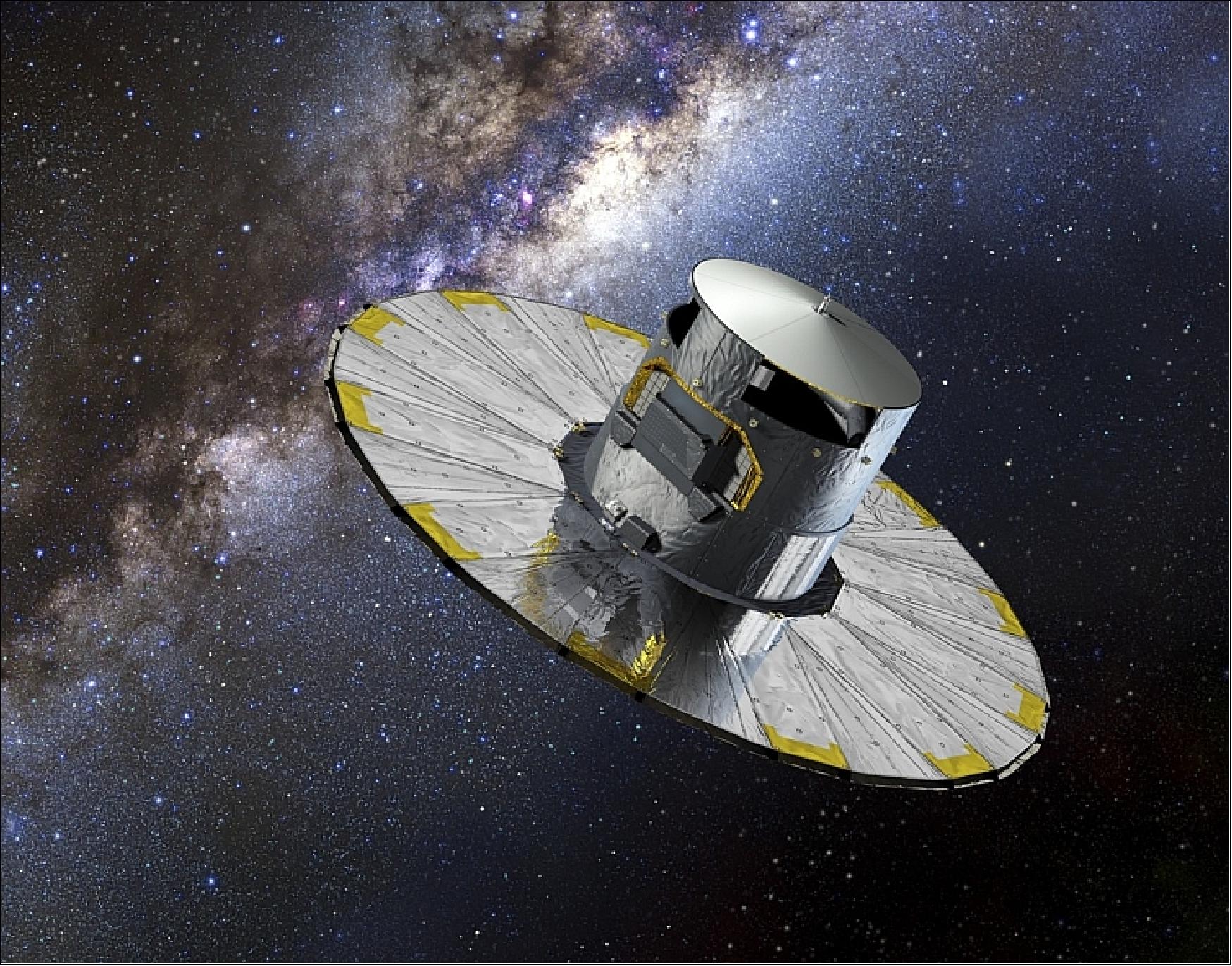
SVM (Service Module)
The SVM is generally referred to as 'the platform'. The SVM in turn is comprised of MSM (Mechanical Service Module) and an ESM (Electrical Service Module). 22) 23) 24)
MSM (Mechanical Service Module): The spacecraft main structure is of hexagonal conical shape. It is a sandwich panel structure with CFRP (Carbon Fiber Reinforced Plastic) face sheets, and a central cone supporting the propellant tanks. The MSM houses instruments needed for the basic control and operation of the satellite; this includes all mechanical, structural and thermal elements that support the instrument payload and spacecraft electronics. It also includes the chemical & micro propulsion systems, the deployable sunshield with solar arrays, the payload thermal tent and harness. The module consists of a central tube that is about 1.17 m long and hosts six radial panels to create a hexagonal spacecraft shape.
The service module also houses the communication subsystem, central computer and data handling subsystem, the high rate data telemetry, attitude control and star trackers. For telemetry and telecommand, low gain antenna uplink and downlink with a few kbit/s capacity are employed. The high gain antenna used for the science telemetry downlink will be used during each ground station visibility period of an average of about 8 hours per day.
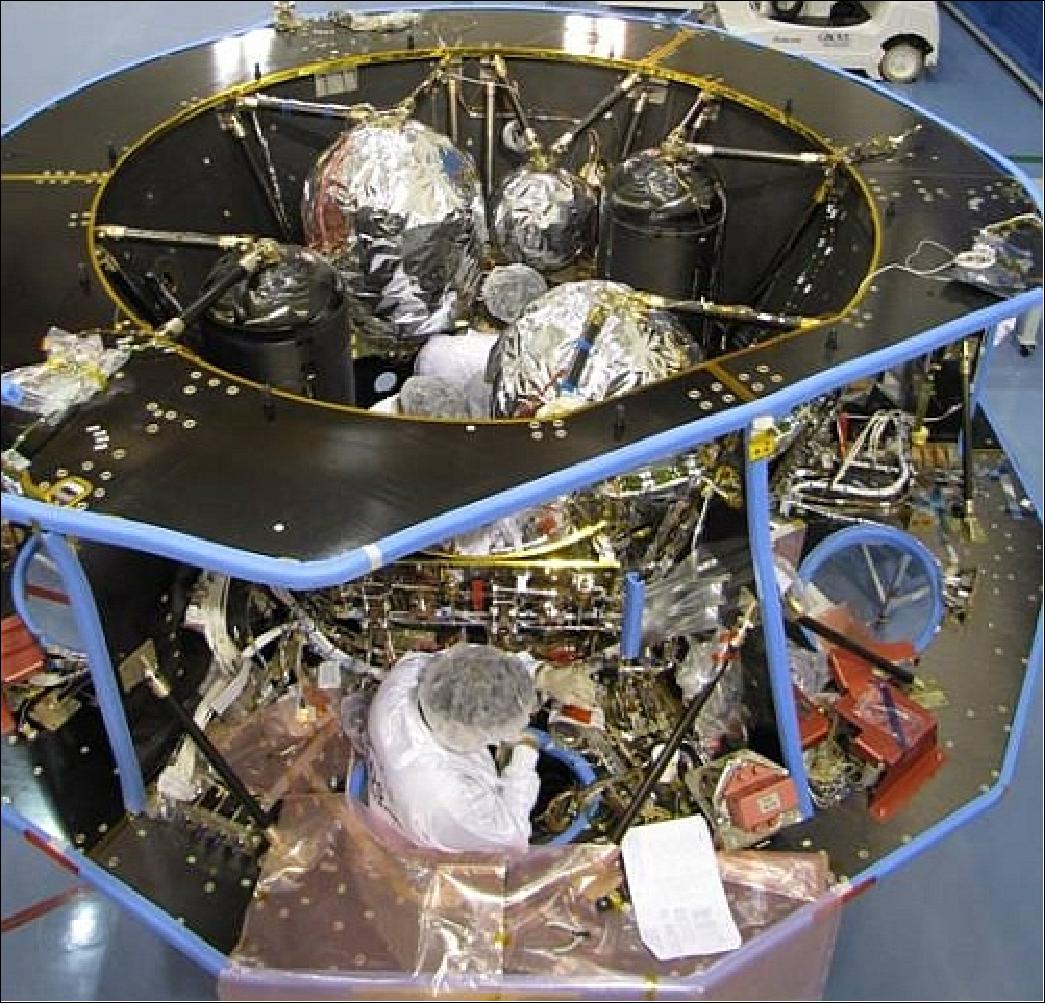
ESM (Electrical Service Module): The ESM design is driven by the science performance (attitude control laws with the hybridisation of star tracker and payload measurements, high rate data telemetry, and regulated power bus for thermal stability). It houses the AOCS units, the communication subsystem, central computer and data handling subsystem, and the power subsystem.
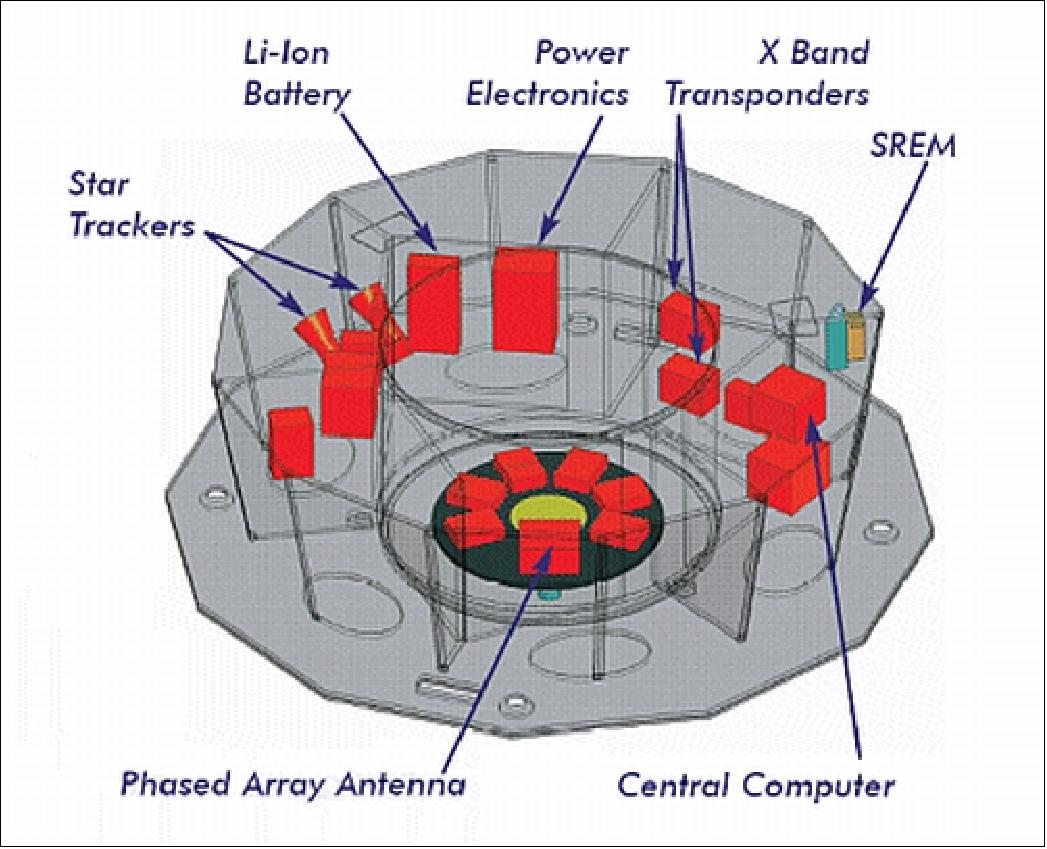
AOCS (Attitude and Orbit Control Subsystem). The AOCS subsystem is characterised by:
- High precision 3-axis control
- The ASTRO (Astrometric) instrument is used for precise rate sensing during the fine pointing operational mode
- A high precision gyroscope is used for quick and efficient transitions during the fine pointing operational mode. Three FOGs (Fiber Optics Gyroscopes) use the interference of light to detect mechanical rotation. Each unit contains four closed-loop gyroscope channels to provide built-in redundancy.
- Rugged flight-proven initial acquisition and safe modes
- Three sun acquisition sensors plus one gyroscope provide spin-axis stabilisation during the L2 transfer phase of the mission
- One large field of view star sensor plus use of the main instrument SM (Sky Mapper) for the 3-axis controlled operational phase.
Gaia AOCS architecture is based on a fully redundant set of equipment. Moving parts on board are strictly minimised (e.g. no reaction wheels, no mechanically steerable antenna). The data is downlinked through a novel electromagnetically steerable phased array antenna and attitude control is provided by a micro propulsion system that has its first flight use with Gaia. An atomic clock is used for precise time-stamping.
Two Autonomous Star Trackers are used in cold redundancy three FSS (Fine Sun Sensors) are used in hot redundancy through triple majority voting. Three Gyro packages provide coarse rate measurements where each gyro package comprises two fully independent co-aligned channels (i.e. a fiber optic gyroscope sensor plus associated electronics per channel), with the channels being used in cold redundancy. As mentioned above, the payload module provides very precise rate measurements when the spacecraft is operated in fine pointing science modes. 25)
For actuators, a bi-propellant Chemical Propulsion System (2 x 8 10 N thrusters used in cold redundancy) is used for orbit maintenance and attitude control in coarse AOCS modes (circa 350 kg MON + MMH).
The Micro-propulsion System (2 x 6 proportional micro-thrusters) can provide a range of 0 - 1000 µN at a resolution of 0.1 µN. The individual thrusters are driven by the micro-propulsion electronic, which is internally redundant and used in cold redundancy (circa 57 kg of GN2). The nominal science AOCS mode uses the cold gas micro-propulsion system.
C&DMS (Command & Data Management Subsystem). The C&DMS is characterised by:
- An ERC-32 based central computer and distinct input/output units for efficient software development
- Two segregated MIL-STD-1553 B data buses: one for the payload module and one for the service module
- SpaceWire data links for high-speed payload data
- FDIR architecture aiming at preserving payload integrity, with built-in autonomy for increased availability.
The PDHU (Payload Data Handling Unit) is, among other things, the 'hard-disk' of Gaia, responsible for temporary storage of science data received from the telescope before transmission back to Earth. It will receive thousands of compressed images per second from the observing system; this data will be sorted and stored. The individual star data objects will be prioritised based on the magnitude of the star. A complex file management system allows deletion of low-priority data in the event of data rates or volumes that exceed the capacity of the storage or transmission systems.
The solid-state storage subsystem of the PDHU has a capacity of 960 GB which, while not impressive by terrestrial standards, is extremely large for a space system. It uses a total of 240 SDRAM modules, each with a capacity of 4 GB, which populate six memory boards. The PDHU controller board is responsible for communication with the other spacecraft subsystems, file system management and the management of telemetry and telecommands. 26) 27)
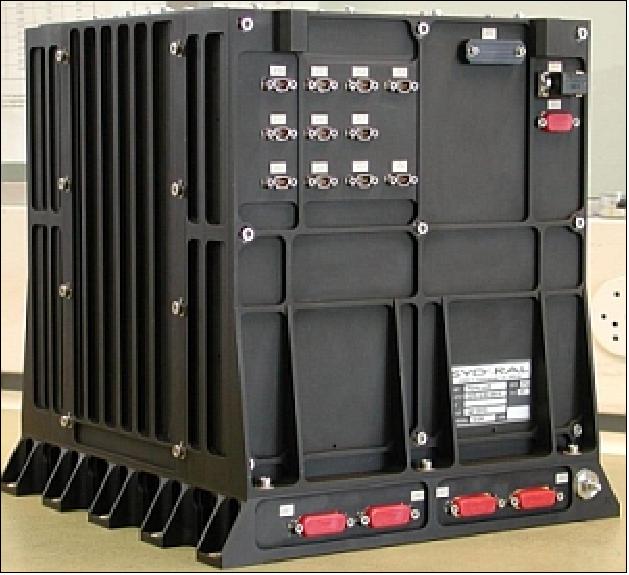
The PDHU communicates with the gigapixel focal plane over seven redundant 40 Mbit/s SpaceWire channels to acquire the scientific data coming from the seven VPUs (Video Processing Units) of the camera. The unit's controller sorts the incoming data according to star magnitude and manages deletion of low priority data should this become necessary. It sends data for transmission to Earth under the control of the CDMU (Command and Data Management Unit). The PDHU communicates with the CDMU via a MIL-STD-1553 data bus and delivers the science data over two 10 Mbit/s PacketWire channels.- The PDHU consumes only 26 W, has a mass of 14 kg, and occupies a volume of 2.3 liter.
EPS (Electrical Power Subsystem): The spacecraft is equipped with a 12.8 m2 high-efficiency triple-junction GaAs (Gallium-Arsenide) cell solar array, of which 7.3 m2 is in the form of a fixed solar array and 5.5 m2 is covered by 6 panels mechanically linked to deployable sunshield assembly.
For the launch, the deployable sunshield is folded against the payload module. After separation from the launch vehicle, it is deployed around the fixed solar array, in the same plane. During LEOP (Launch and Early Operations Phase), power is supplied by a 60 Ah mass-efficient Lithium-ion battery.
Optimum power supply during all phases of the mission is ensured by a PCDU (Power Control and Distribution Unit) with maximum power point tracking. The PCDU performs power management by generating a 28 V primary power bus that supplies power to all spacecraft subsystems. It also controls the battery state of charge and generates pyrotechnic commands as well as heater actuation as commanded by the C&DMS (Command & Data Management Subsystem).
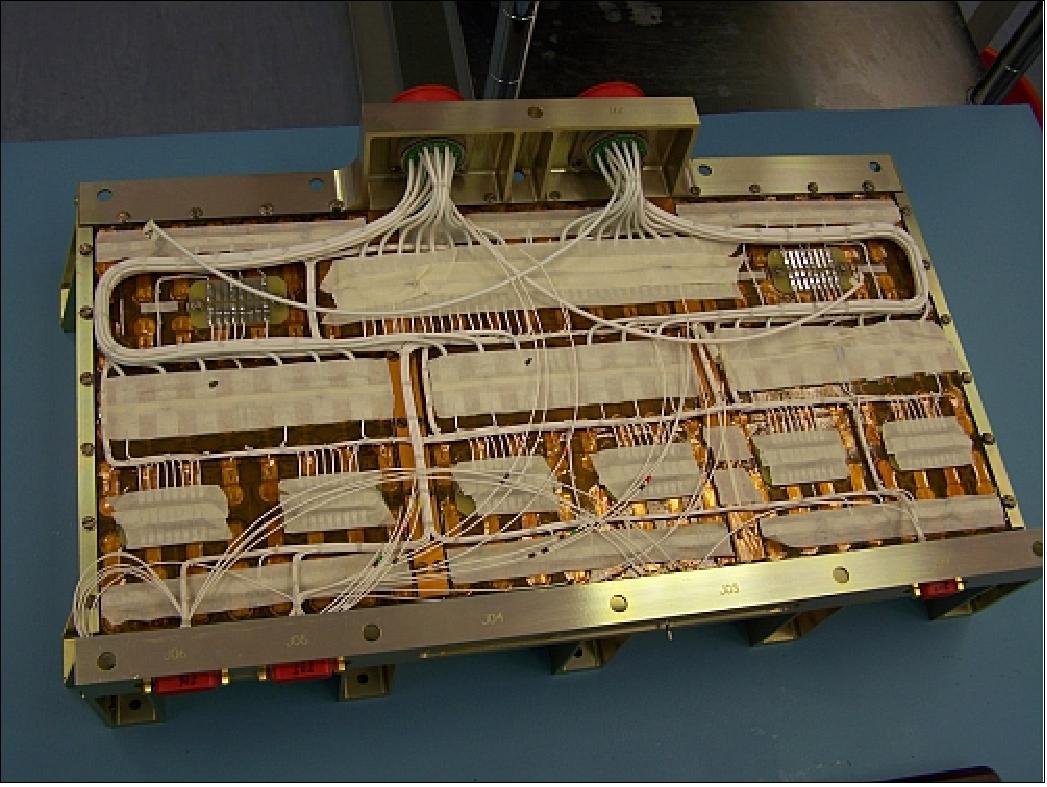
Propulsion: After injection into the L2 transfer orbit by the Soyuz-Fregat launcher, a chemical bi-propellant propulsion system (8 x 10 N) is used for the transfer phase. It will cover attitude acquisition, spin control, mid-course corrections, L2 orbit injection, and safe mode.
After arriving at L2, one redundant set of micro-propulsion thrusters will control the spin and precession motion of the spacecraft. Regular orbit maintenance will be performed by using the chemical propulsion thrusters. - The spacecraft uses a cold gas micropropulsion system for fine attitude control.
CPS (Chemical Propulsion Subsystem): CPS is a bi-propellant system using two tanks of Herschel/Planck heritage filled with with a total of ~400 kg of propellant featuring a blowdown ratio of 4:3. Use of monomethylhydrazine as fuel and nitrogen tetroxide as oxidiser. The 10 N thrusters are manufactured by Astrium consisting of a platinum alloy combustion chamber and nozzle that tolerates the operational temperature of 1,500°C. The thruster can be operated in a thrust range of 6 to 12.5 N with a nominal thrust of 10 N which generates a specific impulse of 291 seconds.
MPS (Micro Propulsion Subsystem): The MPS is being used for fine attitude pointing and spin rate management. A total of 12 cold gas thrusters are installed on the spacecraft being grouped in three clusters each featuring four cold gas thrusters. The thruster system uses high-pressure nitrogen propellant to provide very small impulses with a thrust range of 1 - 500 µN. The system uses two nitrogen tanks, each containing 28.5 kg of N2, stored at a pressure of 310 bar (Ref. 19). The CG-MPS (Cold Gas-Micro Propulsion Subsystem) was developed by TAS-I and Selex ES S.p.A., Italy. 28)
RF communications: All communication with the Gaia spacecraft is done using the X-band. For TT&C (Tracking Telemetry and Command), a low gain antenna uplink and downlink with a few kbit/s capacity and an omnidirectional coverage are employed. The science telemetry X-band downlink is based on a set of electronically-scanned phased array antennae accommodated on the service module bottom panel. This high gain antenna is used during each ground station visibility period of about 8 hours per day.
The X-band payload downlink rate is 10 Mbit/s from L2. To achieve this, Gaia uses a specially designed on-board phased array antenna to beam the payload data to Earth (a conventional steerable antenna would disturbed the very precise measurements).
Gaia is equipped with a total of three communication antennas – two LGAs (Low Gain Antennas) and a single X-band Medium Gain Phased Array Antenna. One LGA is located pointing in the +X direction while the other points to –X being located on the Thermal Tent and the base of the spacecraft, respectively. The two LGAs build an omni-direction communications system for housekeeping telemetry downlink and command uplink with data rates of a few kbit/s.
The MGA (Medium Gain Antenna) is located on the base of the Payload Module, protruding the DSA(Deployable Sunshield Assembly) . This directional antenna can achieve data rates of up to 10 Mbit/s for science data and telemetry downlink and telecommand reception.
Demodulation of the uplink signal is completed by the transponder units before the data flow is passed on to the CDMU (Command & Data Management Unit). The downlink data is encoded by the CDMU and modulated in X-band within the transponders before being amplified by the SSPA (Solid State Power Amplifier). The signal is combined in the phased array of the active antenna in order to orient the beam towards the Earth.
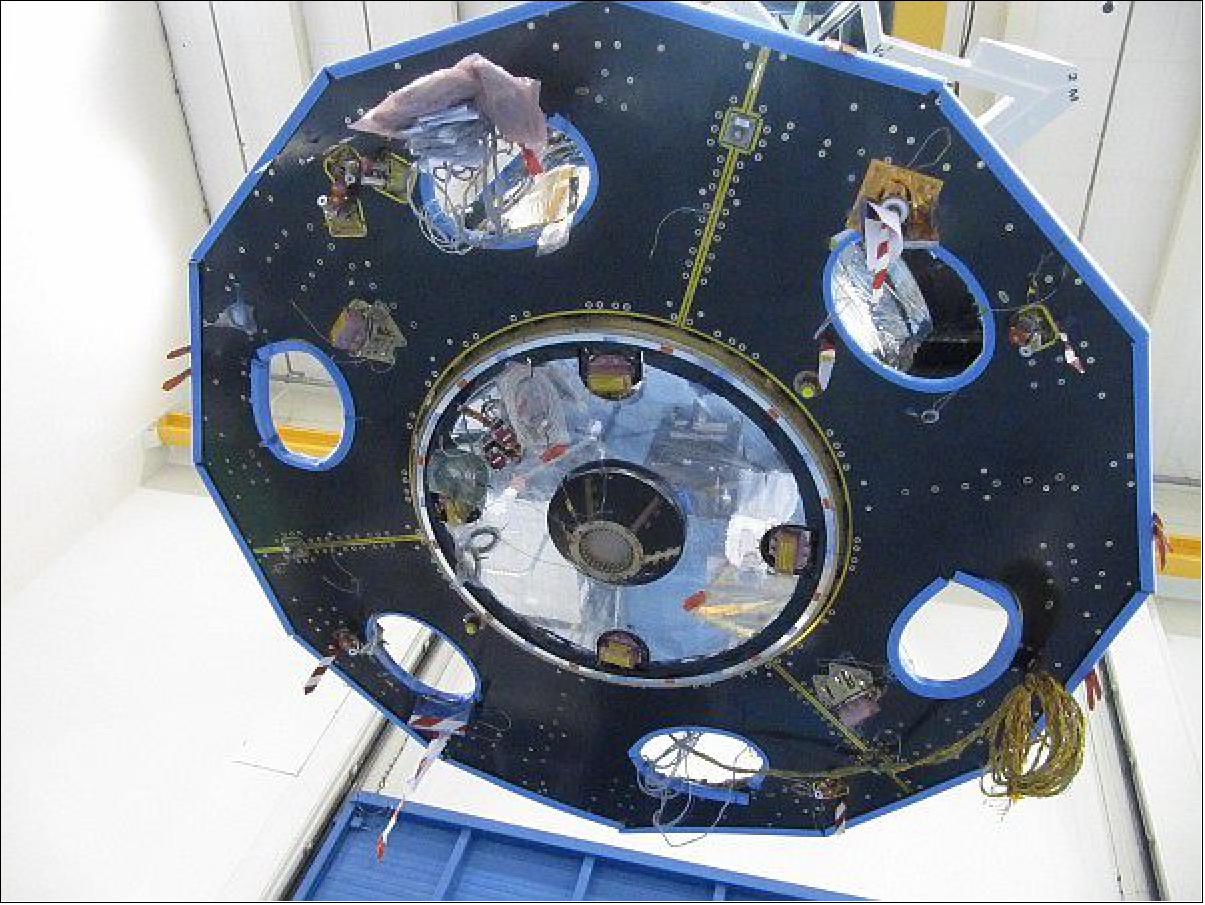
CCSDS Image Data Compression ASIC: In order to transmit all the data generated on board, a particularly challenging compression factor averaging 2.8 was necessary. Unfortunately the standard suite of algorithms was not able to reach this target, because of the peculiarities of Gaia imagery, which include ‘outliers’, such as bright stars and planets, and which are marred by the momentary ‘hot pixels’ due to cosmic rays in deep space. Instead, with the support of ESA compression experts, industry developed an ad hoc solution, enabling all Gaia mission data to reach their home planet. 29)
CWICOM (CCSDS Wavelet Image COMpression ASIC) is a very high-performance image compression ASIC that implements the CCSDS 122.0 wavelet-based image compression standard, to output compressed data according to the CCSDS output source packet protocol standard. This integrated circuit was developed by Airbus DS through an ESA contract.
CWICOM offers dynamic, large compressed-rate range and high-speed image compression potentially relevant for compression of any 2D image with bi-dimensional data correlation (such as a hyperspectral data cube). Its highly optimised internal architecture allows lossless and lossy image compression at very high data rates (up to 60 Mpixels/s) without any external memory by taking advantage of its on-chip memory – almost 5 Mbit of embedded internal memory).
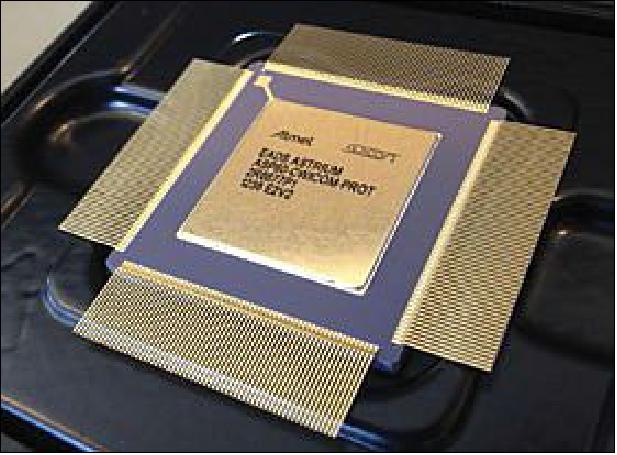
CWICOM is implemented using the largest matrix of the Atmel ATC18RHA ASIC family, and is provided within a standard surface mount package (CQFP 256). CWICOM offers a low-power, cost-effective and highly integrated solution for any image compression application, performing CCSDS image compression treatments without requiring any external memory. The simplicity of such a standalone implementation is achieved thanks to a very efficient internal embedded memory organisation that removes any need for extra memory chip procurement and the potential obsolescence threatened by being bound to a specific external memory interface.
Change in Data Compression Implementation
In order to transmit all the data generated on board, a particularly challenging compression factor averaging 2.8 was necessary. Unfortunately the standard suite of algorithms [which includes CCSDS standards, including the 122.0 implemented by CWICOM] was not able to reach this target, because of the peculiarities of Gaia imagery, which include ‘outliers’, such as bright stars and planets, and which are marred by the momentary ‘hot pixels’ due to cosmic rays in deep space. Instead, with the support of ESA compression experts, industry developed an ad hoc solution,enabling all Gaia mission data to reach their home planet.
Instead of CWICOM, Gaia applies a tailored data compression algorithm (using a heavily tailored pre-processing stage followed by a variant of the Rice coder), using a software implementation running on VPUs (Video Processing Units). The GOCA (Gaia Optimum Compression Algorithm) project was entrusted by ESA to GTD System & Software Engineering (project prime) and IEEC (Institut d'Estudis Espacials de Catalunya), scientific partner), aimed in providing a deep understanding of the Gaia compression problem and offering a complete data compression system, both at an algorithm and implementation level. The main objectives of GOCA not only encompassed the review and evaluation of the already proposed compression scheme but the design of new algorithms for the mission. 30) 31) 32)
The CCDs in the focal plane are commanded by video-processing units (VPUs). Gaia has seven identical VPUs, each one dealing with a dedicated row of CCDs. Each CCD row, contains in order, two SM CCDs (one for each telescope), 9 AF CCDs, 1 BP CCD, 1 RP CCD, and 3 RVS CCDs (the latter only for four of the seven CCD rows). The VPUs run seven identical instances of the video-processing algorithms (VPAs), not necessarily with exactly the same parameter settings though. This (mix of some hardware and mostly) software is responsible for object detection (after local background subtraction), object windowing (see below), window conflict resolution, data binning, data prioritisation, science-packet generation, data compression, etc.) 33)
TCS (Thermal Control Subsystem): A deployable sunshield with optimal thermoelastic behavior, made of multi-layer insulation sheets, is attached to the service module and folded against the payload module for the launch. After separation of the Gaia spacecraft from the launch vehicle, the Sun shield is deployed around the fixed solar array, in the same plane. - A thermal tent covers the payload, offering extra protection against micrometeoroids and radiation.
The very high stability thermal control is mostly passive and is achieved through optical surface reflector material, multilayer insulation sheets on the outer faces of the service module, and a black painted cavity, supplemented by heaters where required. Thermal stability is guaranteed by a constant solar aspect angle and the avoidance (as far as possible) of any equipment switch-ON/OFF cycles during nominal operation.
DSA (Deployable Sunshield Assembly): The bottom floor of the SVM is a dodecagonal-shaped panel to comply with the 12 frames of the DSA The main structure consists of carbon-fiber reinforced plastic face sheets.
DSA is folded up during launch and is deployed early in the flight. It is required to shade the payload unit and protect it from direct sunlight that could compromise instrument accuracy. Keeping the instrument at a constant temperature prevents expansion and contraction during temperature variations which would alter the instrument geometry ever so slightly with a large effect on data quality. The DSA is 10 m in diameter.
The DSA is an umbrella-type structure that consists of MLI (Multilayer Insulation) as the primary shield material and six rigid deployment booms as well as six secondary stiffeners. These booms have a single articulation on the base of the Service Module for easy deployment in the radial direction by a spring system. Spacing cables link the booms to the others to ensure a synchronised deployment sequence. The booms and strings are located on the cold side of the cover to limit thermoelastic flexing.
Attached to the DSA are six rectangular solar panels (with triple-junction solar GaAs cells) that are constantly facing the sun once the shield is deployed. They provide 1910 W of EOL (End of Life) power.
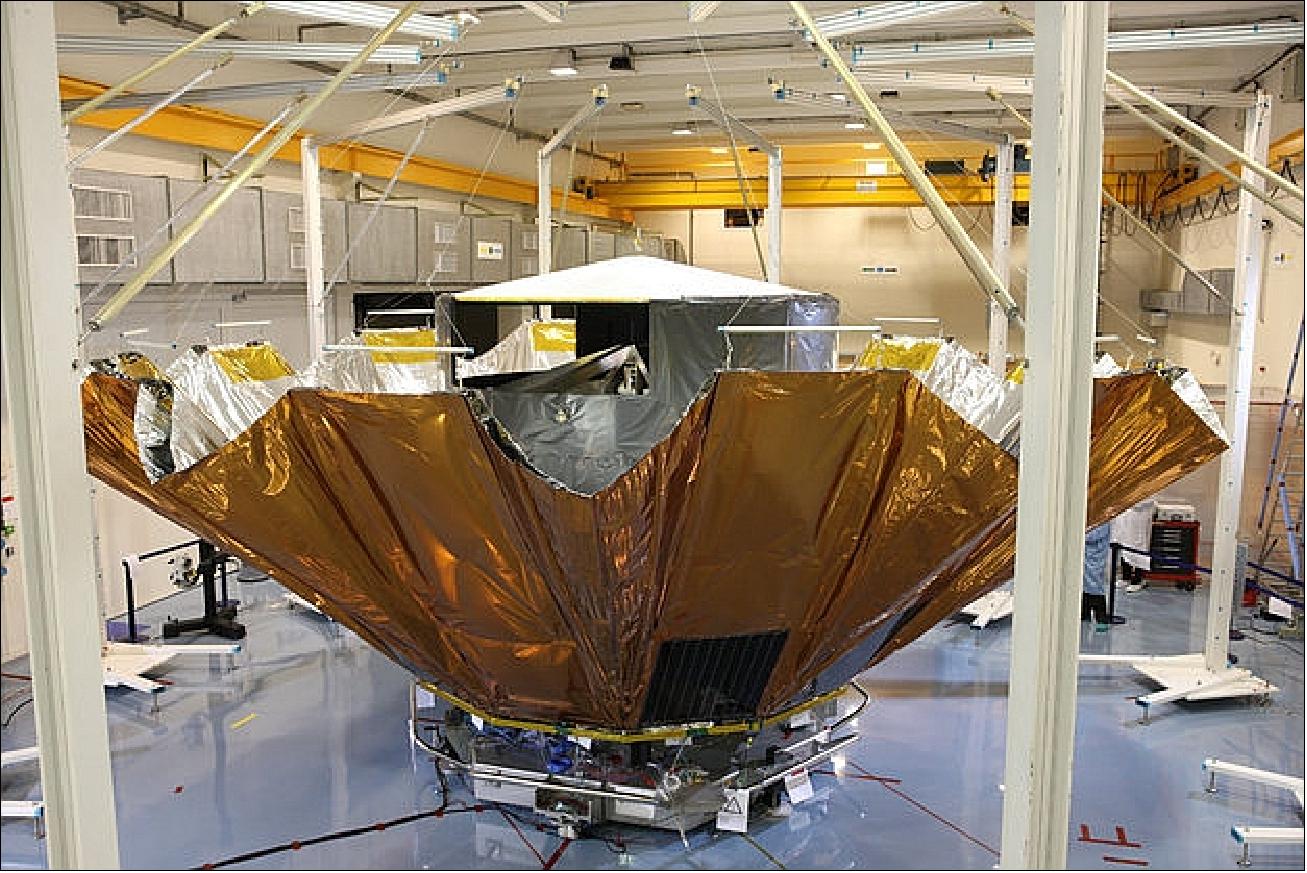
Legend to Figure 12: The DSA during deployment testing at Astrium Toulouse. Since the DSA will operate in microgravity, it is not designed to support its own weight in the one-g environment at Earth's surface. During deployment testing, the DSA panels are attached to a system of support cables and counterweights that bears their weight, preventing damage and providing a realistic test environment. The flight model thermal tent is visible inside the deploying sunshield and the mechanically representative dummy payload can be seen through the aperture in the tent.
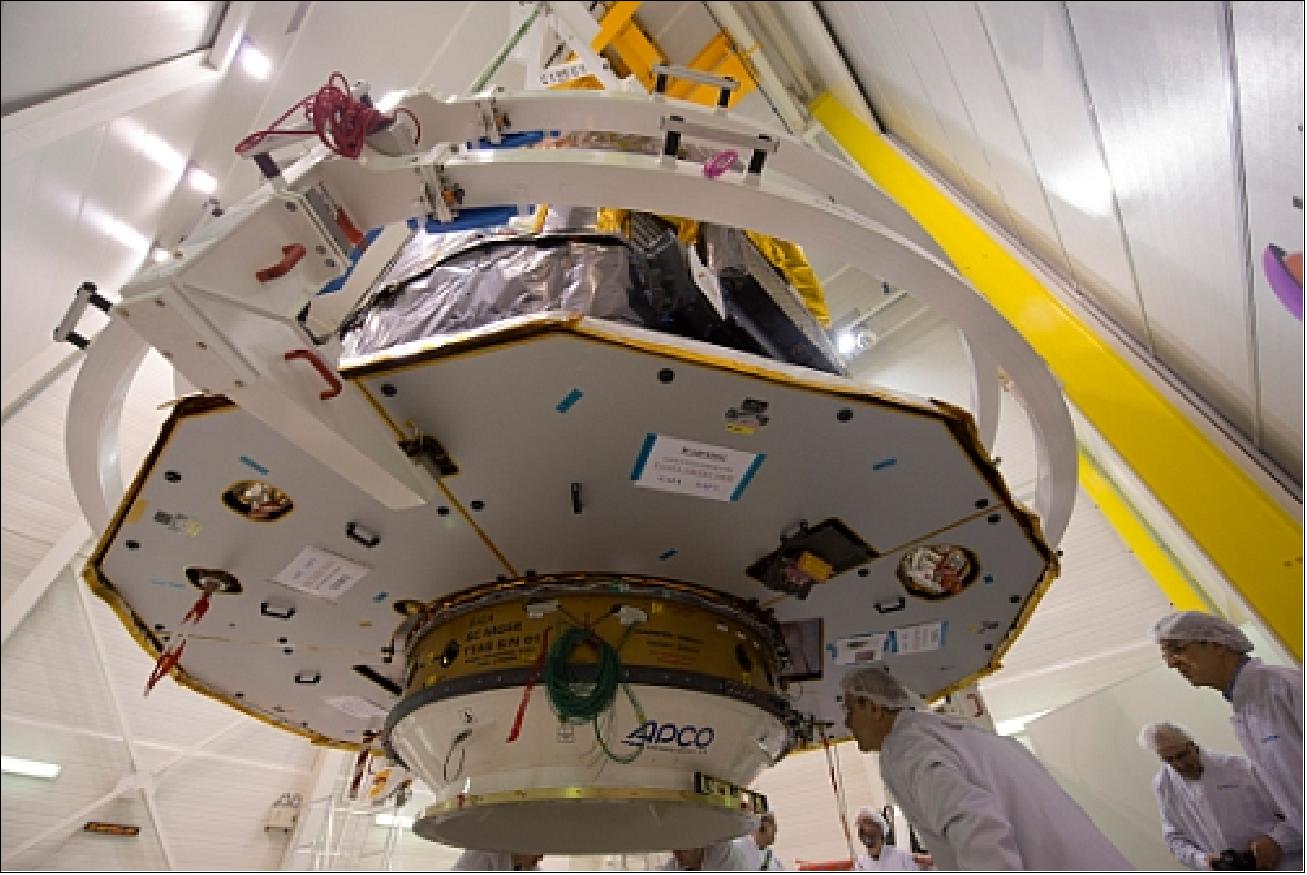
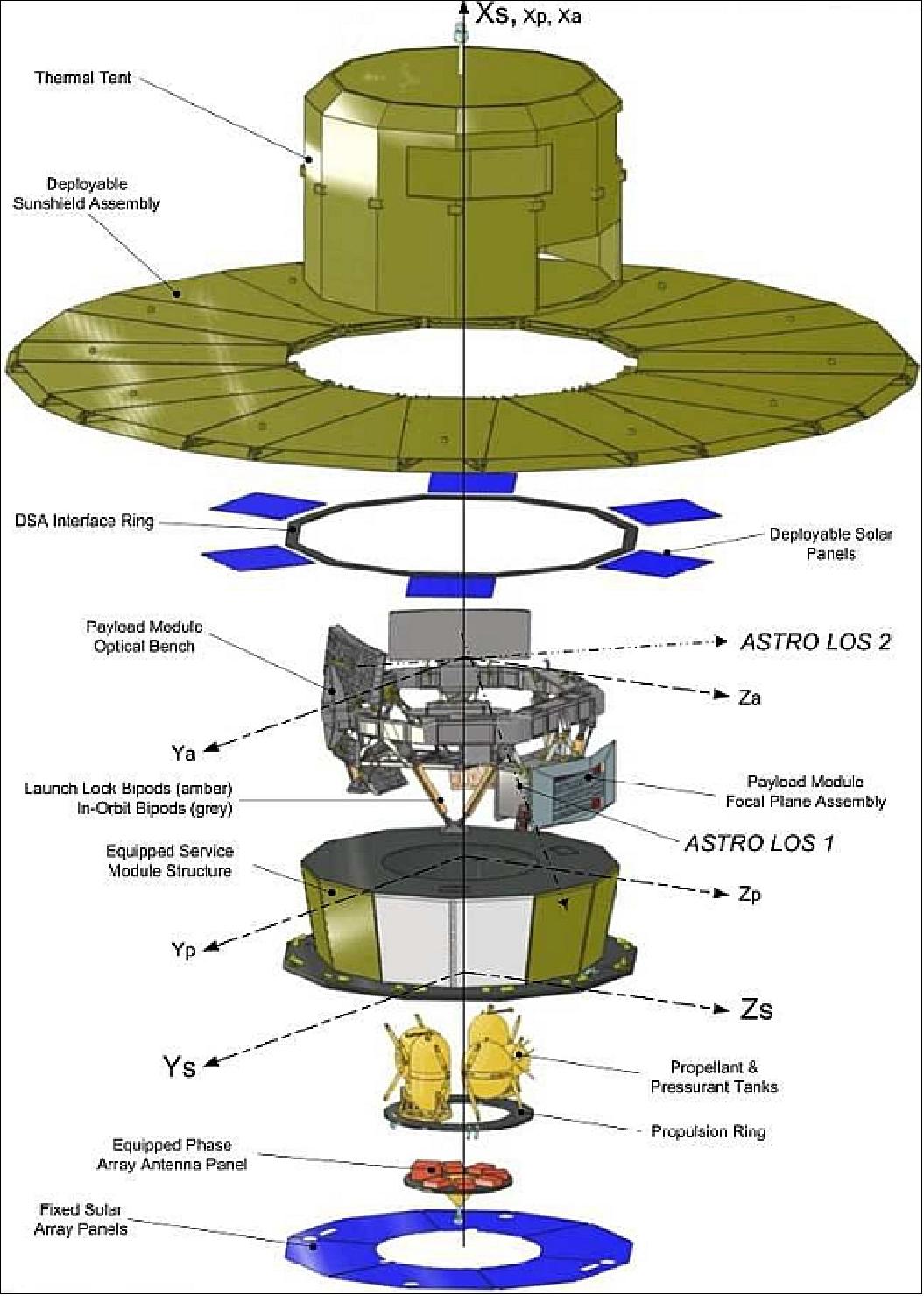
Propulsion systems | - 8 x 10 N bipropellant thrusters for coarse attitude control, orbit injection and trajectory corrections |
Command and data management system | - ERC 32 based central computer with embedded solid state mass memory, complemented by a distinct input / output management unit |
3-axes AOCS (Attitude and Orbit Control Subsystem) | - Payload instrument used for precise rate sensing in science mode |
TT&C (Telemetry, Tracking and Command Subsystem) | - All X-band system |
EPS (Electrical Power Subsystem) | - 60 Ah Li-ion battery |
Payload data handling | - 7 Video Processing Units in parallel, each provided with 1 GIPS (Giga Instruction/s) processing capability |
TCS (Thermal Control Subsystem) | - Fully passive thermal control |
Structure | - All Silicium Carbide instrument: structure & mirrors |
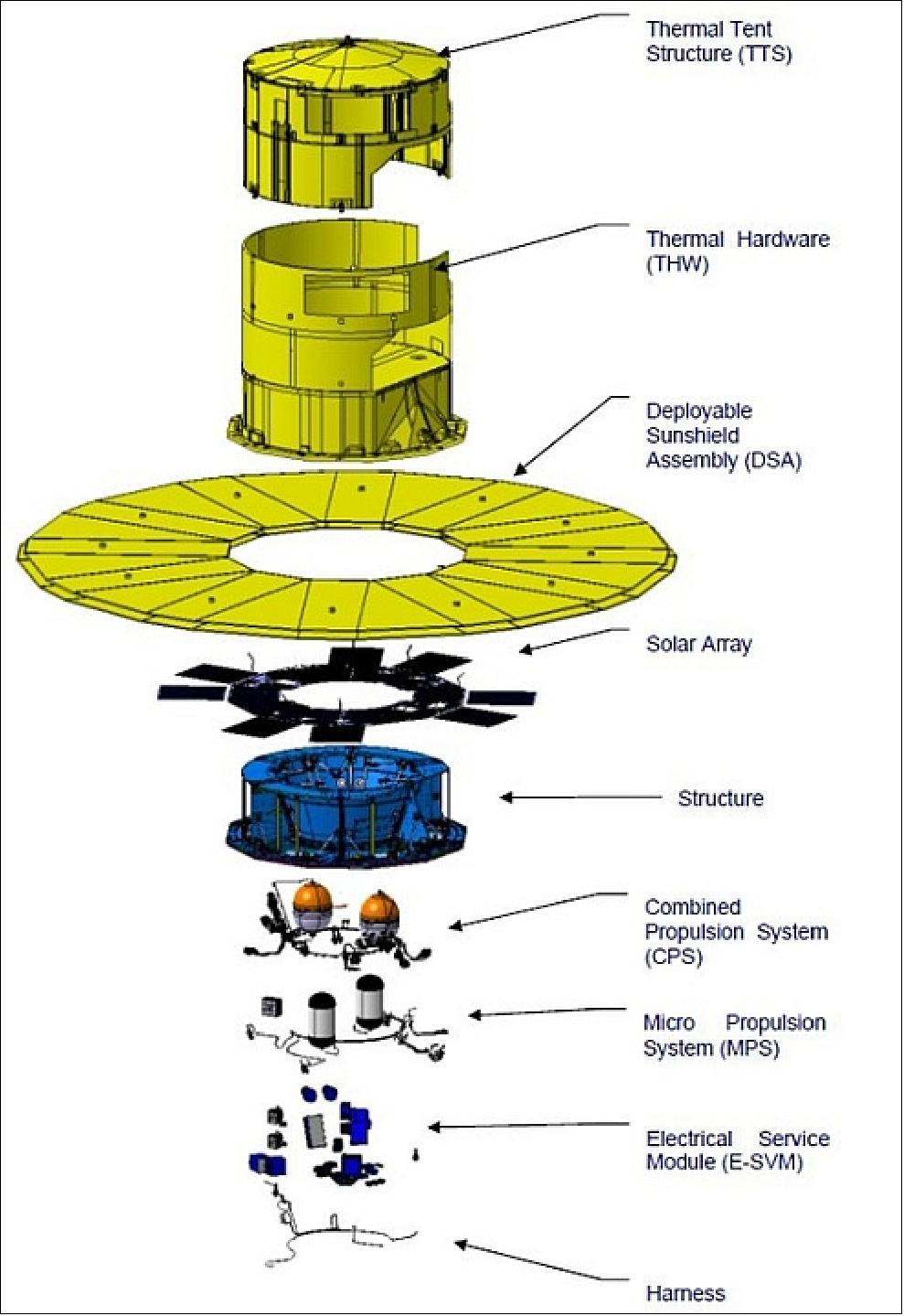
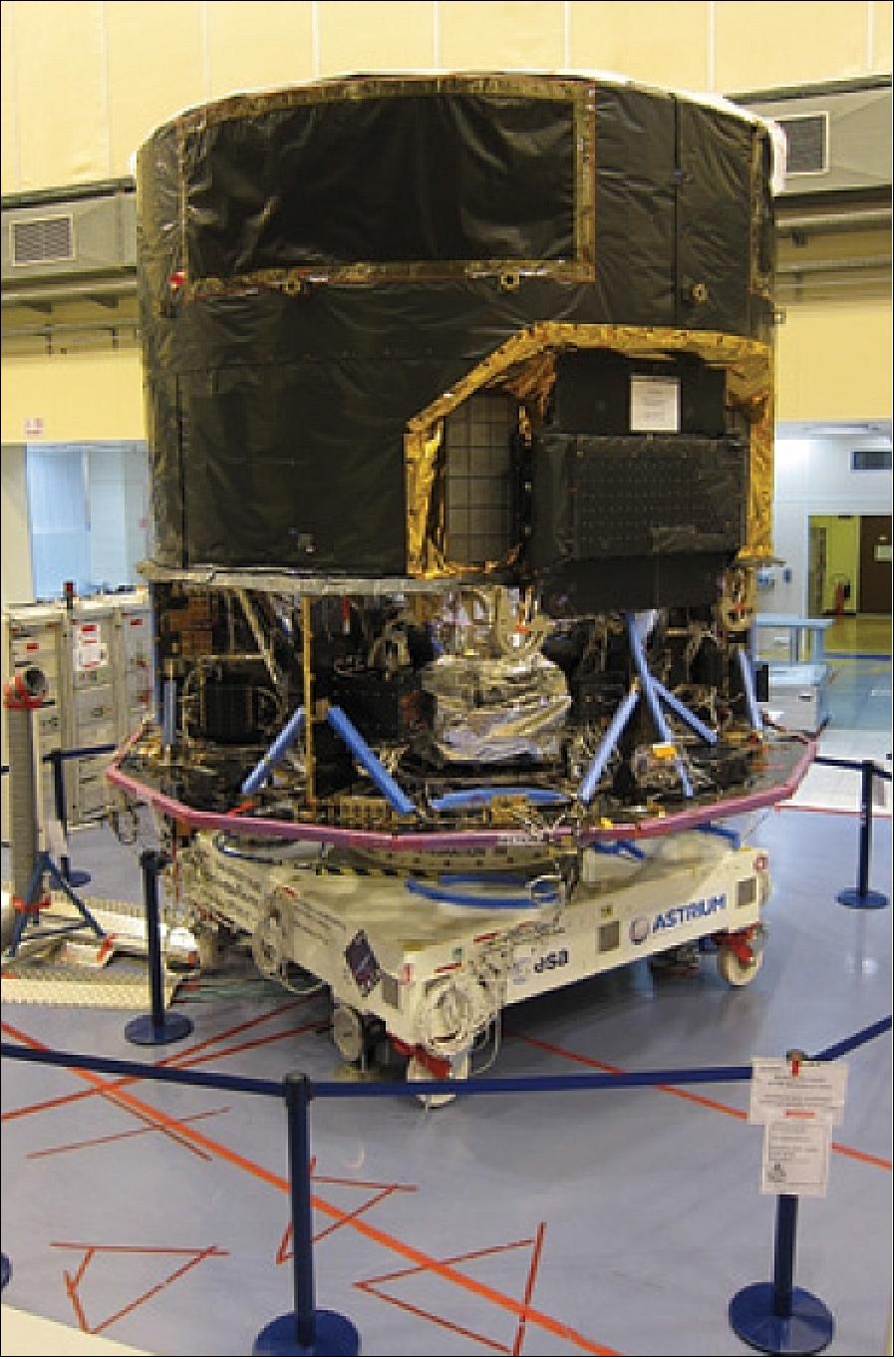
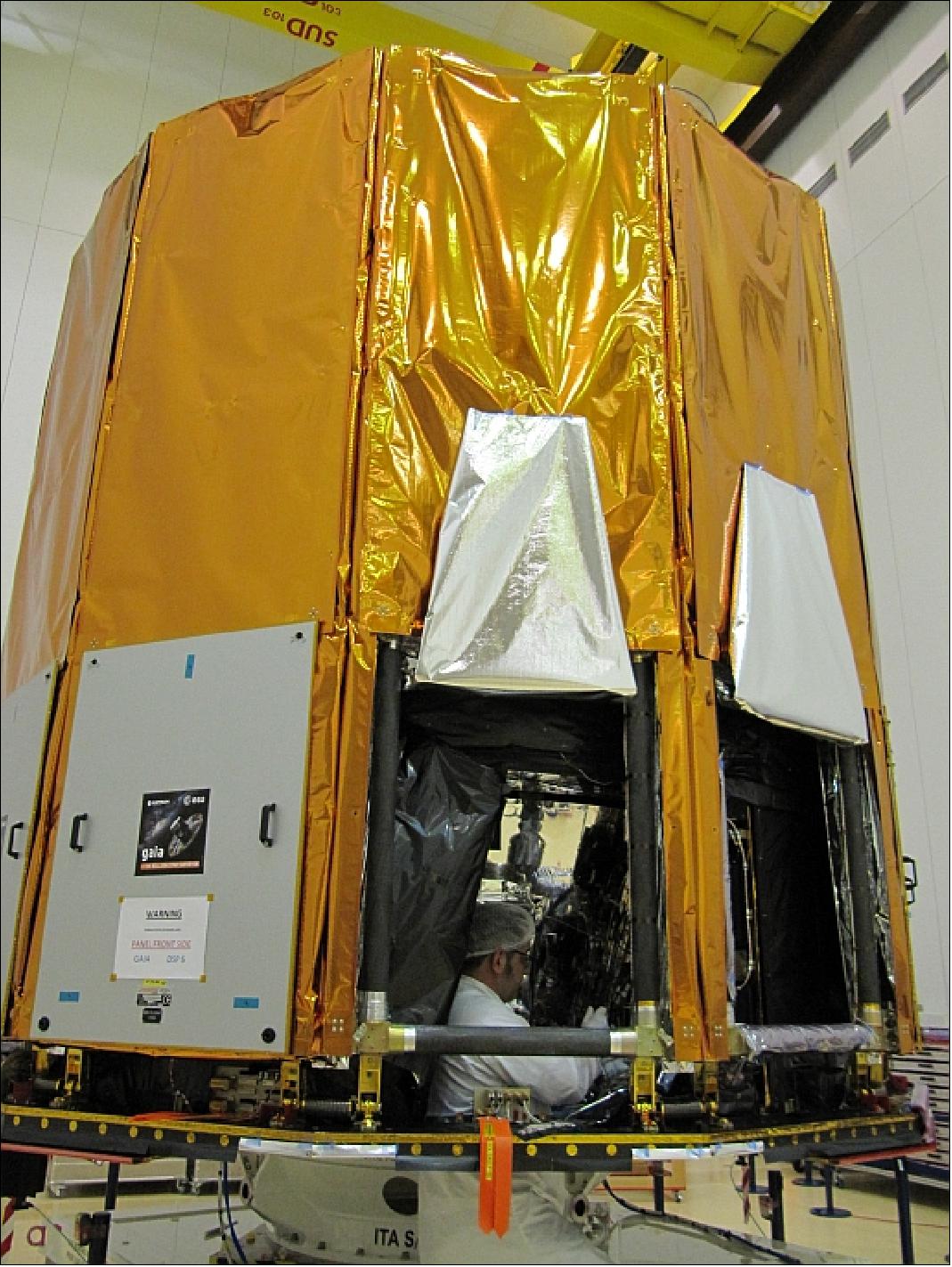
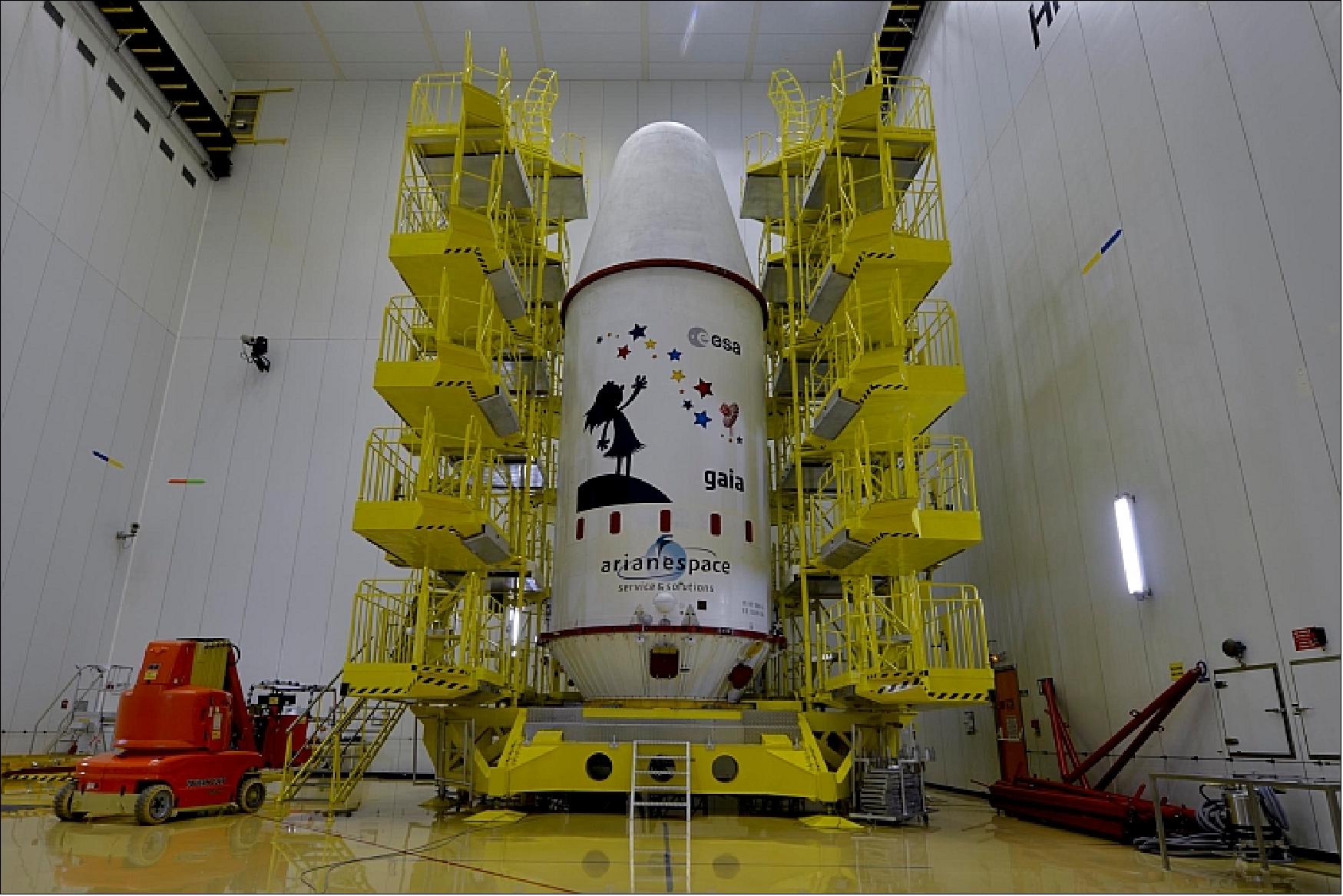
Launch
The Gaia spacecraft was launched on December 19, 2013 (09:12:19 UTC) from Kourou by Arianespace, Europe’s Spaceport in French Guiana. The launch vehicle was a Soyuz-STB with a Fregat-MT upper stage The launch is designated as Soyuz flight VS06. 35) 36) 37)
- About ten minutes later, after separation of the first three stages, the Fregat upper stage ignited, delivering Gaia into a temporary parking orbit at an altitude of 175 km.
- A second firing of the Fregat 11 minutes later took Gaia into its transfer orbit, followed by separation from the upper stage 42 minutes after liftoff. Ground telemetry and attitude control were established by controllers at ESOC (European Space Operation Centre) in Darmstadt, Germany, and the spacecraft began activating its systems.
- The sunshield, which keeps Gaia at its working temperature and carries solar cells to power the satellite, was deployed in a 10 minute automatic sequence, completed around 88 minutes after launch. Gaia is now en route towards L2 (Ref. 35).
Orbit: Large Lissajous orbits around L2 (Lagrangian Point 2), about 1.5 million km from Earth. L2 offers a stable thermal environment because the sunshield will protect Gaia from the Sun, Earth and Moon simultaneously, allowing the satellite to keep cool and enjoy a clear view of the Universe from the other side. In addition, L2 provides a moderate radiation environment, which benefits the longevity of the instrument detectors.
• The critical LEOP (Launch and Early Orbit Phase) will last approximately four days. In this phase, Gaia will perform the first activations – transmitter switch ON, priming of the chemical thrusters, first attitude control and finding of the sun position – followed by the sun shield deployment. Engineers on ground will perform orbit determination, then prepare and execute the critical 'Day 2' maneuver to inject Gaia into its final transfer trajectory toward the L2 Lagrange point (Ref. 94).
• LEOP will be followed by the transfer cruise phase, lasting up to 30 days, an L2 orbit injection maneuver, then the in-orbit commissioning phase, during which all operations to prepare for the routine operational phase are performed. In particular, the scientific FPA (Focal Plane Assembly) and related avionics will be thoroughly tested and calibrated. The commissioning phase is expected to last four months.
• The insertion into the final 300,000 x 200,000 km Lissajous orbit around L2 was performed one month after launch.
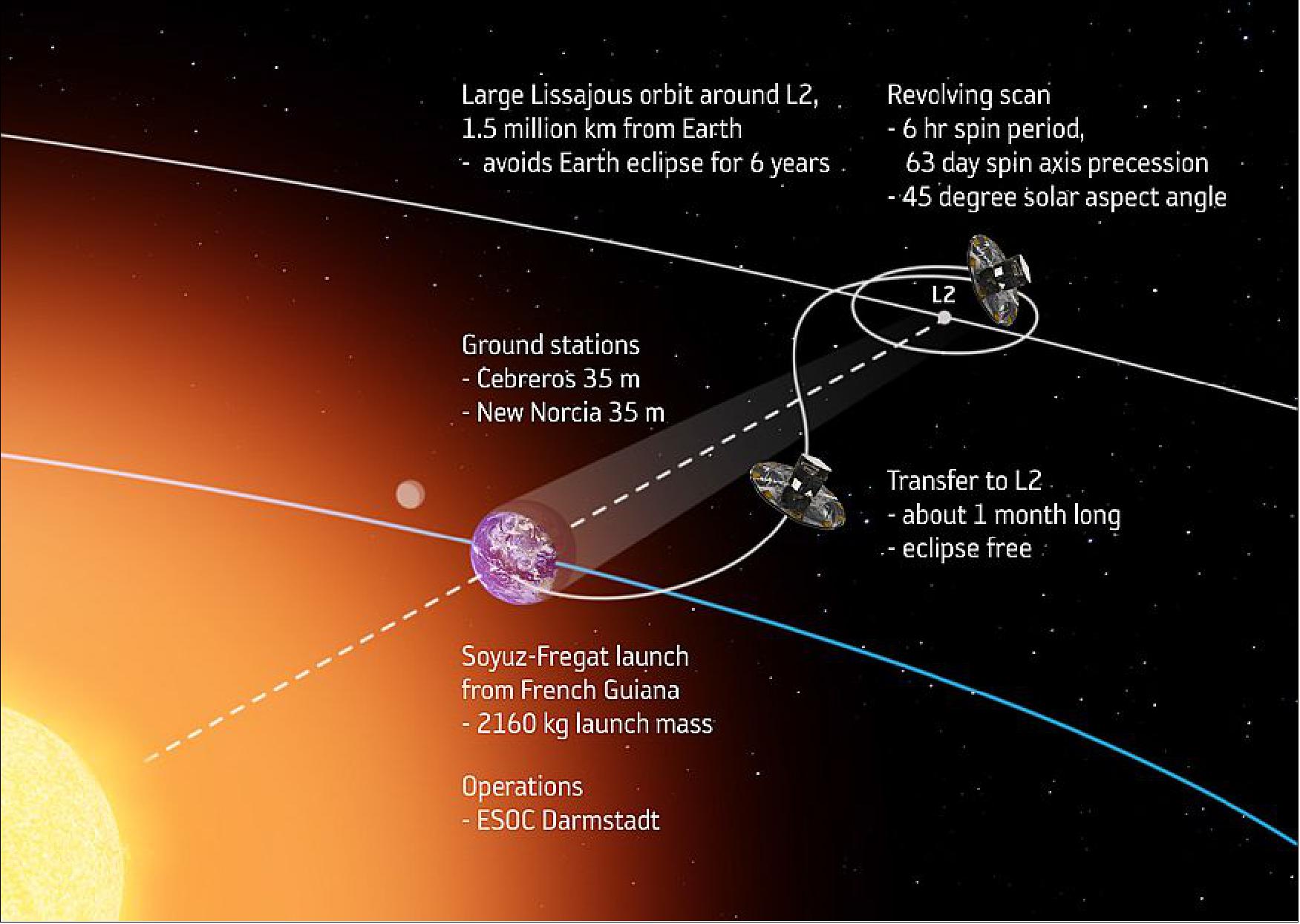
Note: As of 3 March 2020, the previously single large Gaia file has been split into two files, to make the file handling manageable for all parties concerned, in particular for the user community.
• This article covers the Gaia mission and its imagery in the period 2020, in addition to some of the mission milestones.
• Gaia status and imagery in the period 2019-2013
Mission Status
• June 13, 2022: Since its launch in 2013 ESA’s Gaia observatory has been mapping the Milky Way from Lagrange point 2, creating one of the most complete multi-dimensional map of the Milky Way. At this point two full sets of data had been released, the first set in 2016 and a second one in 2018. These data releases contained stellar positions, distances, motions across the sky, and colour information, among others. On 13 June 2022, a third data set was released. 38)
• June 13, 2022: The ESA’s Gaia mission released significant amounts of data about this galaxy. Astronomers describe strange ‘starquakes’, stellar DNA, asymmetric motions and other insights in this most detailed Milky Way survey (as of 2022). 39) Gaia is ESA’s mission to create the most accurate and complete multi-dimensional map of the Milky Way. This allows astronomers to reconstruct this galaxy’s structure and past evolution over billions of years, and to better understand the lifecycle of stars (see video of Figure 20). Gaia’s data release 3 contains new and improved details for almost two billion stars in this galaxy. The catalogue includes new information including chemical compositions, stellar temperatures, colours, masses, ages, and the speed at which stars move towards or away from Earth (radial velocity). Much of this information was revealed by the newly released spectroscopy data, a technique in which the starlight is split into its constituent colours (like a rainbow). The data also includes special subsets of stars, like those that change brightness over time. Also new in this data set is the largest catalogue yet of binary stars, thousands of Solar System objects such as asteroids and moons of planets, and millions of galaxies and quasars outside the Milky Way.
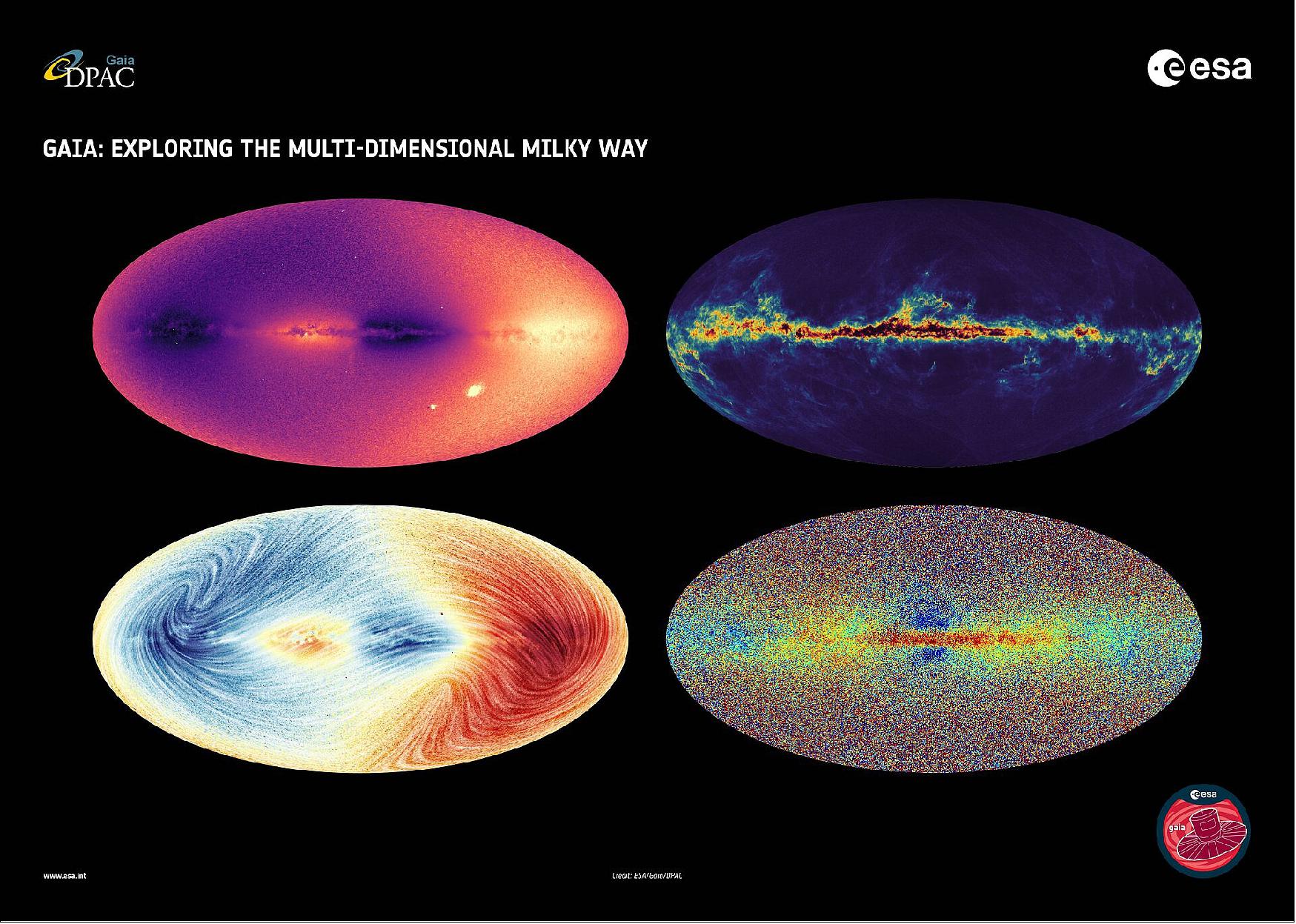
- ESA’s Gaia data release 3 shows the speed at which more than 30 million objects in the Milky Way (mostly stars) move towards or away from Earth. Those maps provide essential clues to the physical mechanisms of the formation of stars and galaxies. What stars are made of can indicate their birthplace and their journey afterwards, and therefore about the history of the Milky Way. When stars die, they release these metals into the gas and dust between the stars called the interstellar medium, out of which new stars form. Therefore, a star’s chemical composition is a bit like its DNA, providing crucial information about its origin. With Gaia, it's now clear that some stars in this galaxy are made of primordial material, while others like the Sun are made of matter enriched by previous generations of stars. Stars that are closer to the centre and plane of this galaxy are richer in metals than stars at larger distances.
- One of the most surprising discoveries coming out of the new data was that Gaia is able to detect starquakes – tiny motions on the surface of a star – that change the shapes of stars, something the observatory was not originally built for. Previously, Gaia already found radial oscillations that cause stars to swell and shrink periodically, while keeping their spherical shape. But Gaia has now also spotted other vibrations that are more like large-scale tsunamis. These nonradial oscillations change the global shape of a star and are therefore harder to detect. Gaia found strong nonradial starquakes in thousands of stars. Gaia also revealed such vibrations in stars that have seldom been seen before. These stars should not have any quakes according to the current theory, while Gaia did detect them at their surface.
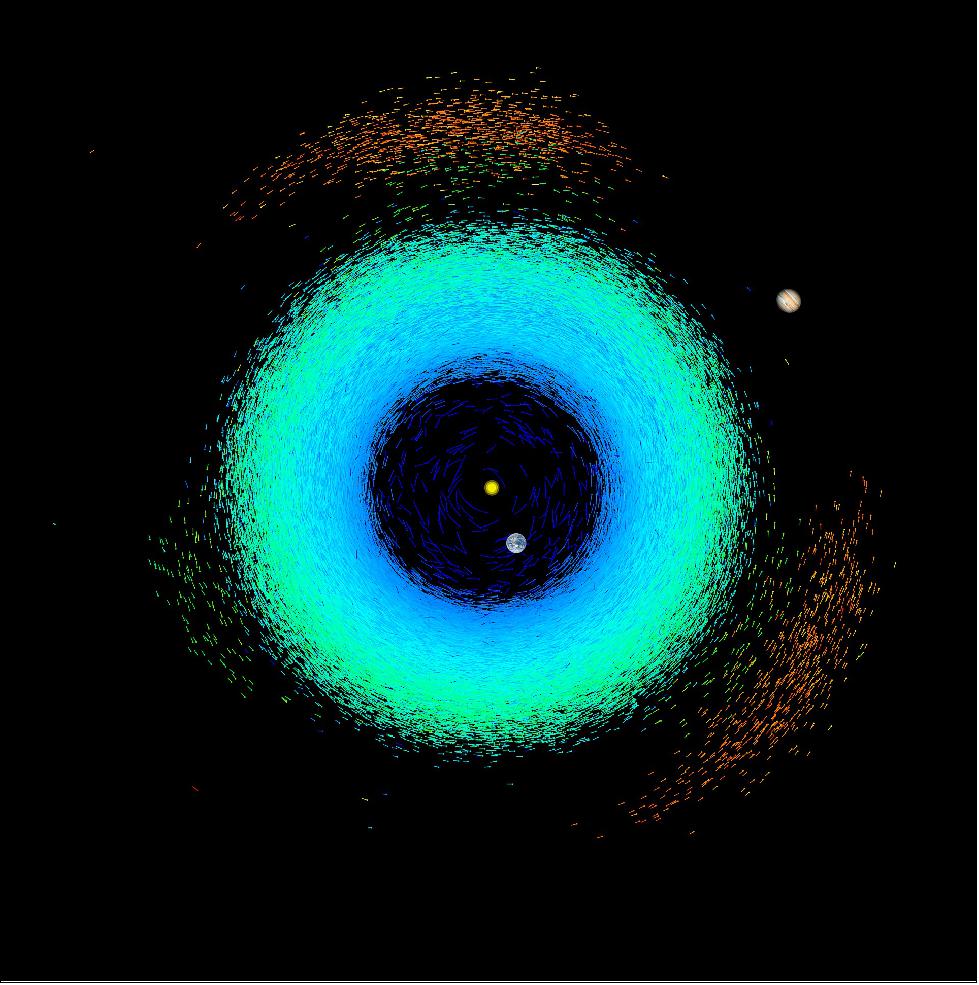
• May 13, 2022: ESA’s Gaia space telescope greatly increased its understanding of the Milky Way. It scans the sky to measure the position, movement, distance, and characteristics of billions of stars. 40)
• March 23, 2022: Using data from ESA’s Gaia mission, astronomers have shown that a part of the Milky Way known as the ‘thick disc’ began forming 13 billion years ago, around 2 billion years earlier than expected, and just 0.8 billion years after the Big Bang. 41) A team from the Max-Planck Institute for Astronomy used brightness and positional data from Gaia’s Early Data Release 3 (EDR3) dataset and combined it with measurements of the stars’ chemical compositions, as given by data from China’s Large Sky Area Multi-Object Fiber Spectroscopic Telescope (LAMOST) for roughly 250,000 stars to derive their ages.
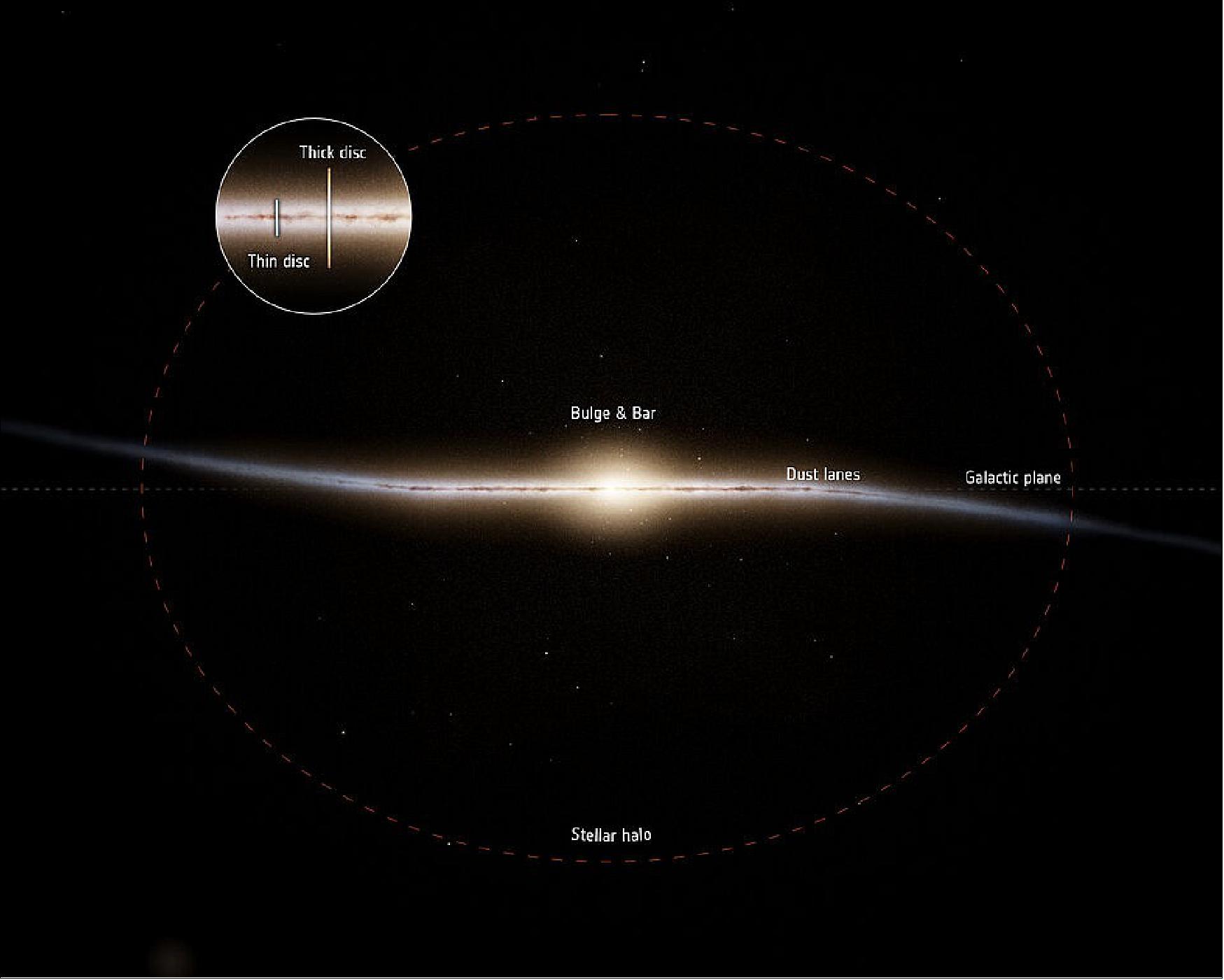
- They chose to look at sub giant stars. The star itself is transforming into a red giant star. Because the sub giant phase is a relatively brief evolutionary phase in a star’s life, it permits its age to be determined with great accuracy, but it’s still a tricky calculation. The age of a star is one of the most difficult parameters to determine. The other chemical elements, known collectively as metals to astronomers, are made inside stars, and exploded back into space at the end of a star’s life, where they can be incorporated into the next generation of stars. Before Gaia, astronomers were routinely working with uncertainties of 20-40 percent, which could result in the determined ages being imprecise by a billion years or more. The LAMOST data gives the metallicity.
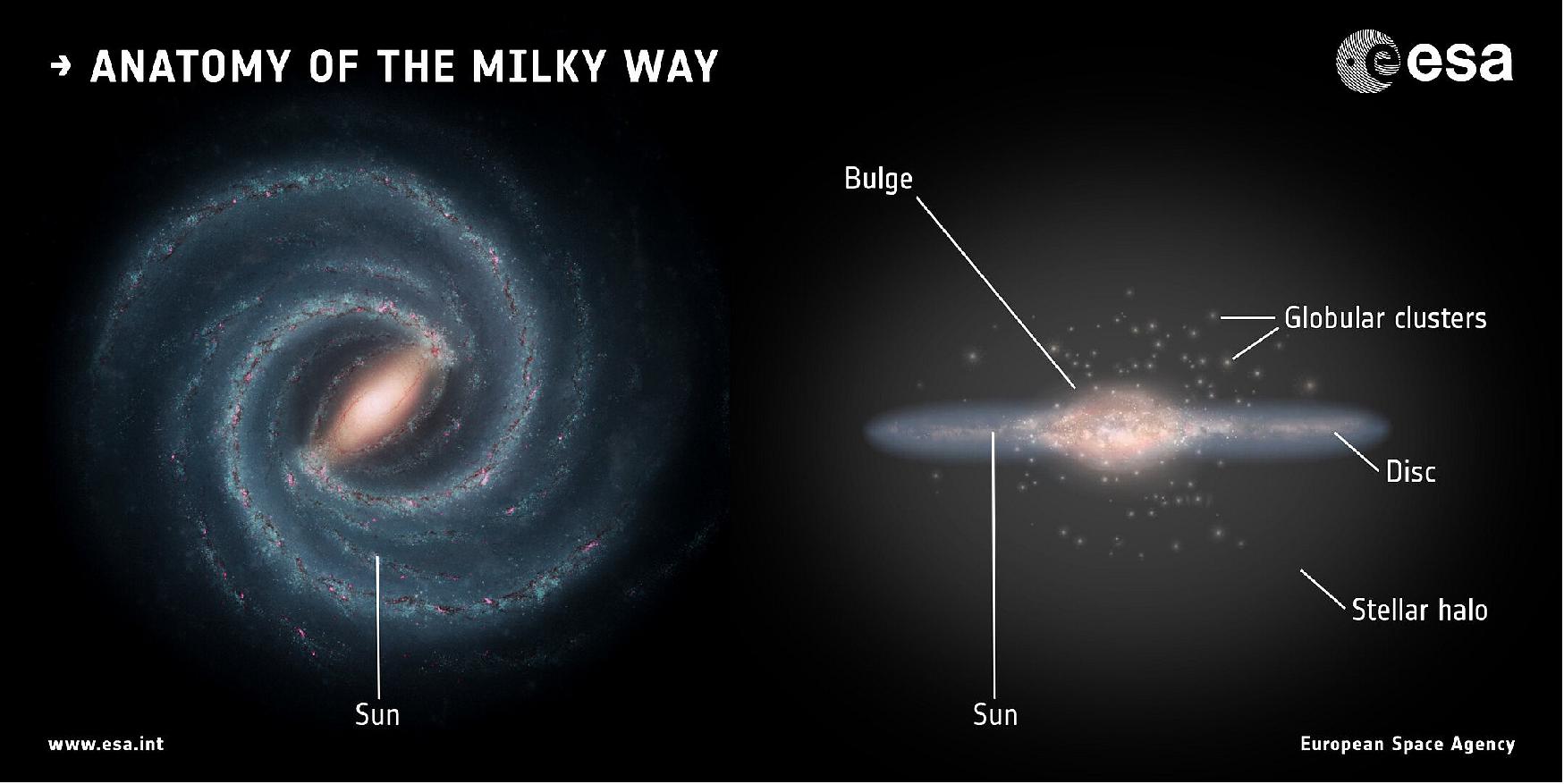
- The disc is composed of two parts: the thin disc and the thick disc. The thick disc is more than double the height of the thin disc but smaller in radius, containing only a few percent of the Milky Way’s stars in the solar neighbourhood. By identifying sub giant stars in these different regions, the researchers were able to build a timeline of the Milky Way’s formation – and that’s when they got a surprise. The stellar ages clearly revealed that the formation of the Milky Way fell into two distinct phases.
• March 16, 2022: The NASA/ESA/CSA James Webb Space Telescope was photographed by ESA’s Gaia observatory. 43)
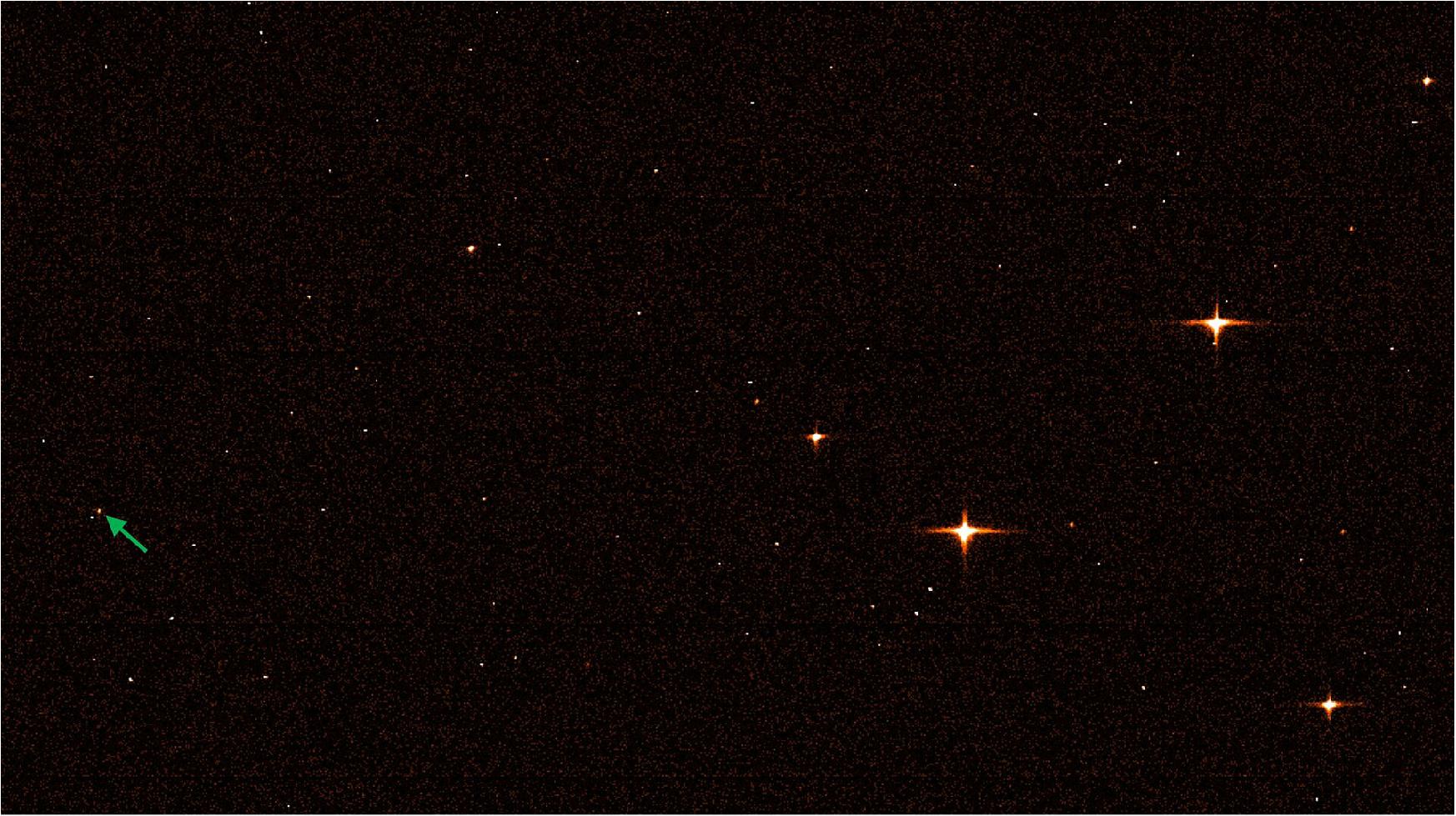
- Both spacecraft are located in orbits around the Lagrange point 2 (L2), 1.5 million km from Earth in the direction away from the Sun. Gaia arrived there in 2014, and Webb in January 2022. On 18 February 2022, the two spacecraft were 1 million km apart, with an edge-on view of Gaia towards Webb’s huge sunshield. Very little reflected sunlight came Gaia’s way, and Webb therefore appears as a tiny, faint spec of light in Gaia’s two telescopes without any details visible. A few weeks before Webb’s arrival at L2, Gaia experts Uli Bastian of Heidelberg University (Germany) and Francois Mignard of Nice Observatory (France) realised that during Gaia’s continuous scanning of the entire sky, its new neighbour at L2 should occasionally cross Gaia’s fields of view. Gaia is not designed to take real pictures of celestial objects. Instead, it collects very precise measurements of their positions, motions, distances, and colours. However, one part of the instruments on board takes a sort of sky images. It is the ‘finder scope’ of Gaia, also called the sky mapper.
- Every six hours, Gaia’s sky mapper scans a narrow 360-degree strip around the entire celestial sphere. The successive strips are slightly tilted with respect to each other, so that every few months the entire sky is covered – touching everything that’s there and that’s bright enough to be seen by Gaia. The sky mapper was originally planned for technical servicing purposes, but during the mission it has also found some scientific uses. After Webb had reached its destination at L2, the Gaia scientists calculated when the first opportunity would arise for Gaia to spot Webb, which turned out to be 18 February 2022. The astronomers had to wait a few more days for Juanma Martin-Fleitas, ESA’s Gaia calibration engineer, to identify Webb in the sky mapper images.
• February 17, 2022: The Milky Way, began forming around 12 billion years ago. Since then, it has been growing in both mass and size through a sequence of mergers with other galaxies. 44) This process has not quite finished, and by using data from ESA’s Gaia spacecraft, astronomers can see it taking place. This in turn allows to reconstruct the history of this galaxy, revealing the ‘family tree’ of smaller galaxies that has helped make the Milky Way what it is today.
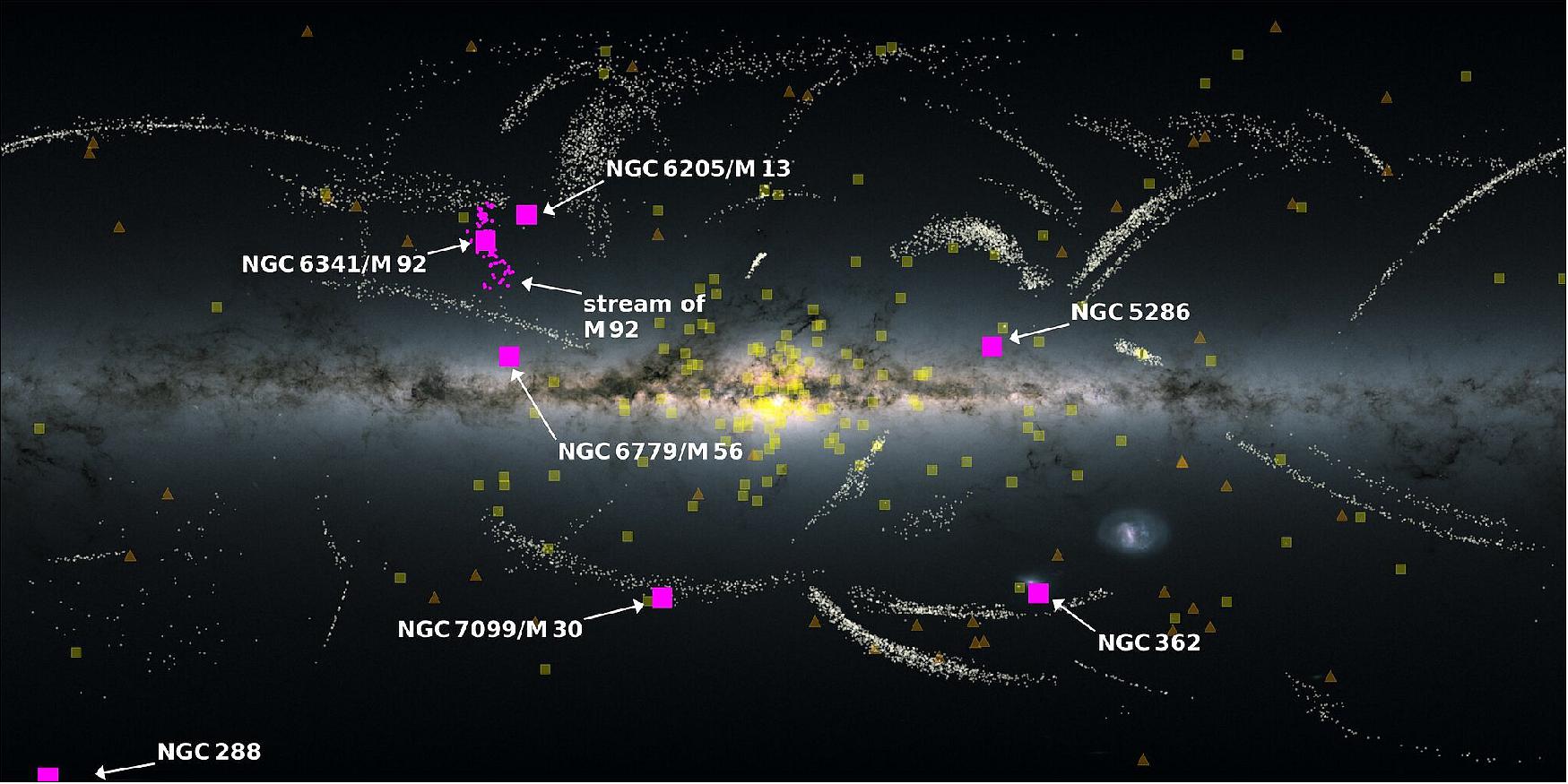
- Some work on this subject came from the Max-Planck-Institut für Astronomie, Heidelberg, Germany, and colleagues. They analysed data based on Gaia’s early third data release (EDR3) looking for the remains of smaller galaxies merging with this one. These can be found in the so-called halo of the Milky Way, which surrounds the disc of younger stars and central bulge of older stars that comprise the more luminous parts of the Milky Way. When a foreign galaxy falls into the Milky Way, great gravitational forces known as tidal forces pull it apart. If this process goes slowly, the stars from the merging galaxy will form a vast stellar stream that can be easily distinguished in the halo. If the process goes quickly, the merging galaxy’s stars will be more scattered throughout the halo and no clear signature will be visible.
- In total, they studied 170 globular clusters, 41 stellar streams and 46 satellites of the Milky Way. Based upon the way the Pontus galaxy has been pulled apart by the Milky Way, Researchers estimated that it probably fell into the Milky Way some eight to ten billion years ago. As a result, the Milky Way has not yet been able to completely disrupt it. Piece by piece, astronomers are fitting together the merger history of the Galaxy, and Gaia data is proving invaluable. 45)
• January 3, 2022: If it’s large enough, a cold cloud of molecules can collapse and fragment under its own gravity to give birth to a litter of thousands of new stars: an open cluster. The stars’ mutual gravity is strong enough to hold the cluster together as it orbits its galactic host, but the attraction is too weak to keep cluster members from eventually straying, either on their own or as result of a dynamically disruptive event. 46)
- Galileo Galilei and other early telescope-wielding astronomers identified open clusters as improbable congregations of similar stars. Now clusters can be automatically cataloged by algorithms that trawl through astrometric data. Close clusters are rare. And when they do occur, they tend to be of similar ages, which suggests that they formed from the same giant molecular cloud. But the members of one pair, IC 4665 (shown here) and Collinder 350, have ages that differ by more than 500 million years. IC 4665 and Collinder 350 appear to be merging. Whether IC 4665 and Collinder 350 will coalesce or separate after passing through each other remains to be determined. The question pertains to how an observed spread in the ages and chemical composition of a cluster are accounted for. If coalescence is a possibility, distinct episodes of star formation need not be invoked. 47)
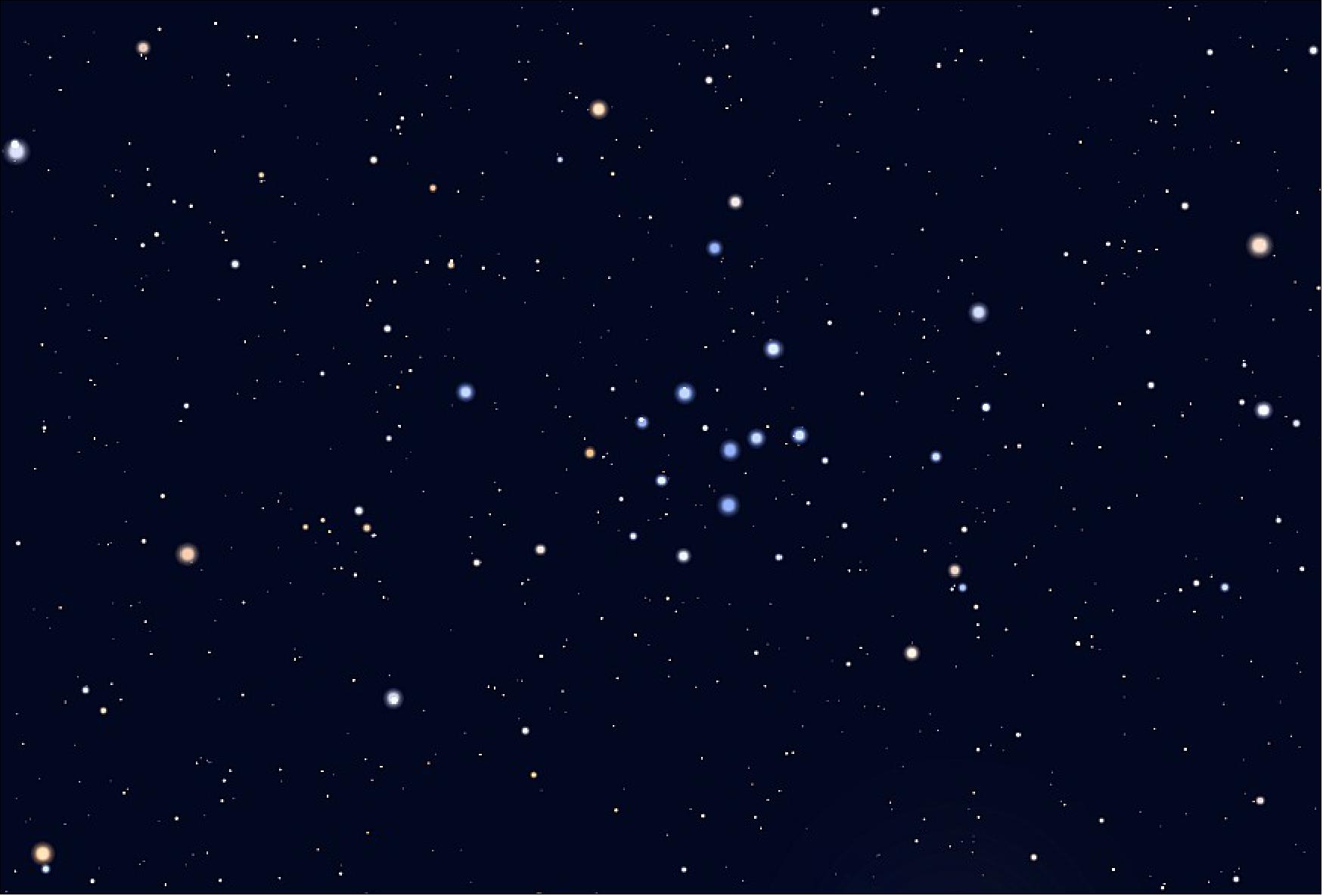
• December 1, 2021: Astronomers at The University of Texas at Austin’s McDonald Observatory have discovered an unusually massive black hole at the heart of one of the Milky Way’s dwarf satellite galaxies, called Leo I. Almost as massive as the black hole in the Milky Way, the finding could redefine understanding of how all galaxies — the building blocks of the universe — evolve. The work was published in a then recent issue of The Astrophysical Journal. 48)
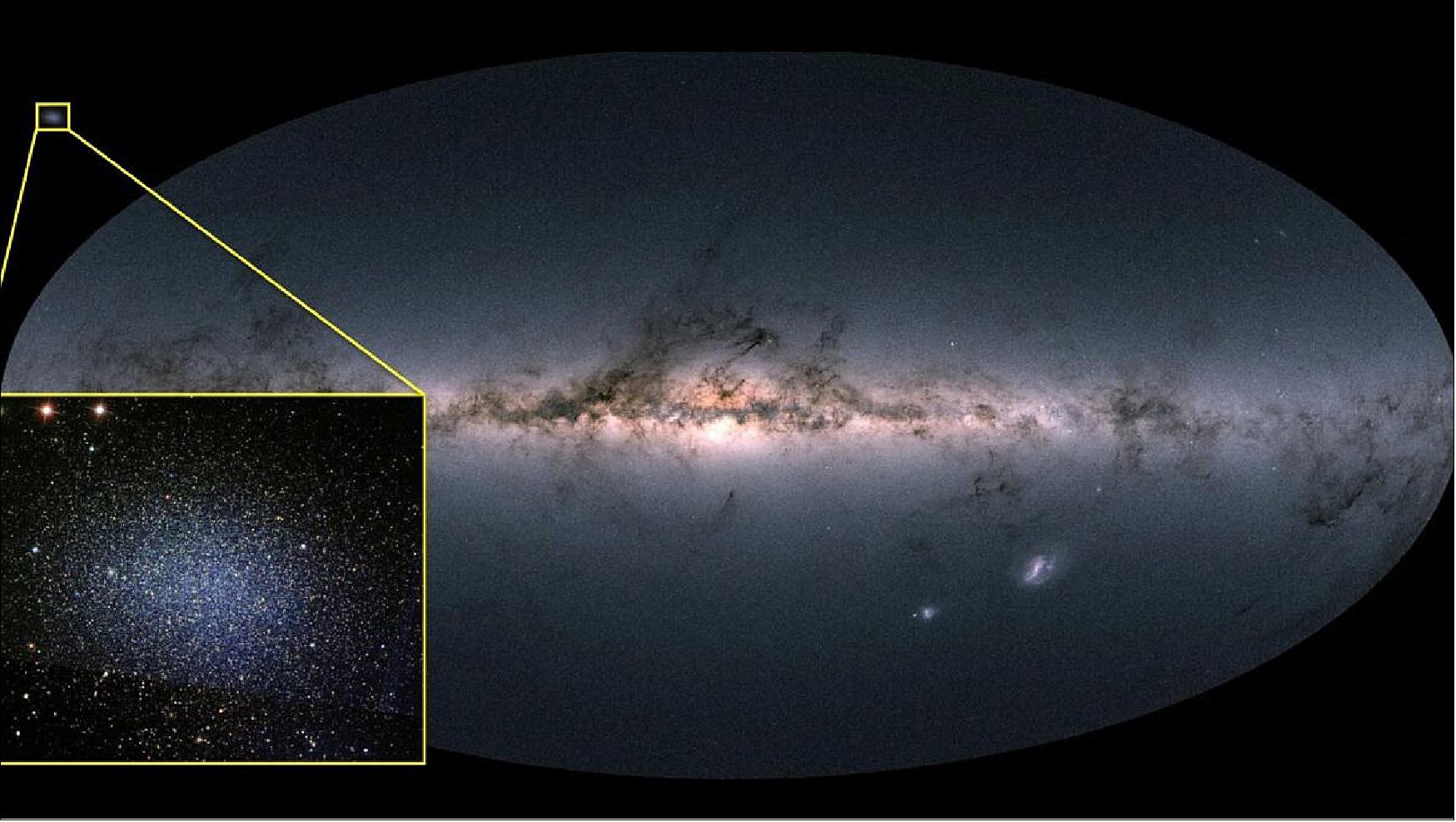
- Unlike most dwarf galaxies orbiting the Milky Way, Leo I does not contain much dark matter. Researchers measured Leo I’s dark matter profile — that is, how the density of dark matter changes from the outer edges of the galaxy all the way into its centre. In particular, the team wanted to know whether dark matter density increases toward the galaxy’s centre. This, in turn, decreased the inferred amount of matter enclosed within their orbits. The new data is concentrated in the central region and is unaffected by this bias. The amount of inferred matter enclosed within the stars’ orbits skyrocketed. The result is all the more important as astronomers have used galaxies such as Leo I, called “dwarf spheroidal galaxies,” to understand how dark matter is distributed within galaxies.
• November 24, 2021: A dwarf galaxy is a collection of between thousand and several billion stars. For decades it has been widely believed that the dwarf galaxies that surround the Milky Way are satellites, meaning that they are caught in orbit around this galaxy, and have been present for many billions of years. The Gaia data calculated the movements of 40 dwarf galaxies around the Milky Way. They did this by computing a set of quantities known as the three-dimensional velocities for each galaxy and then using those to calculate the galaxy’s orbital energy and the angular (rotational) momentum.
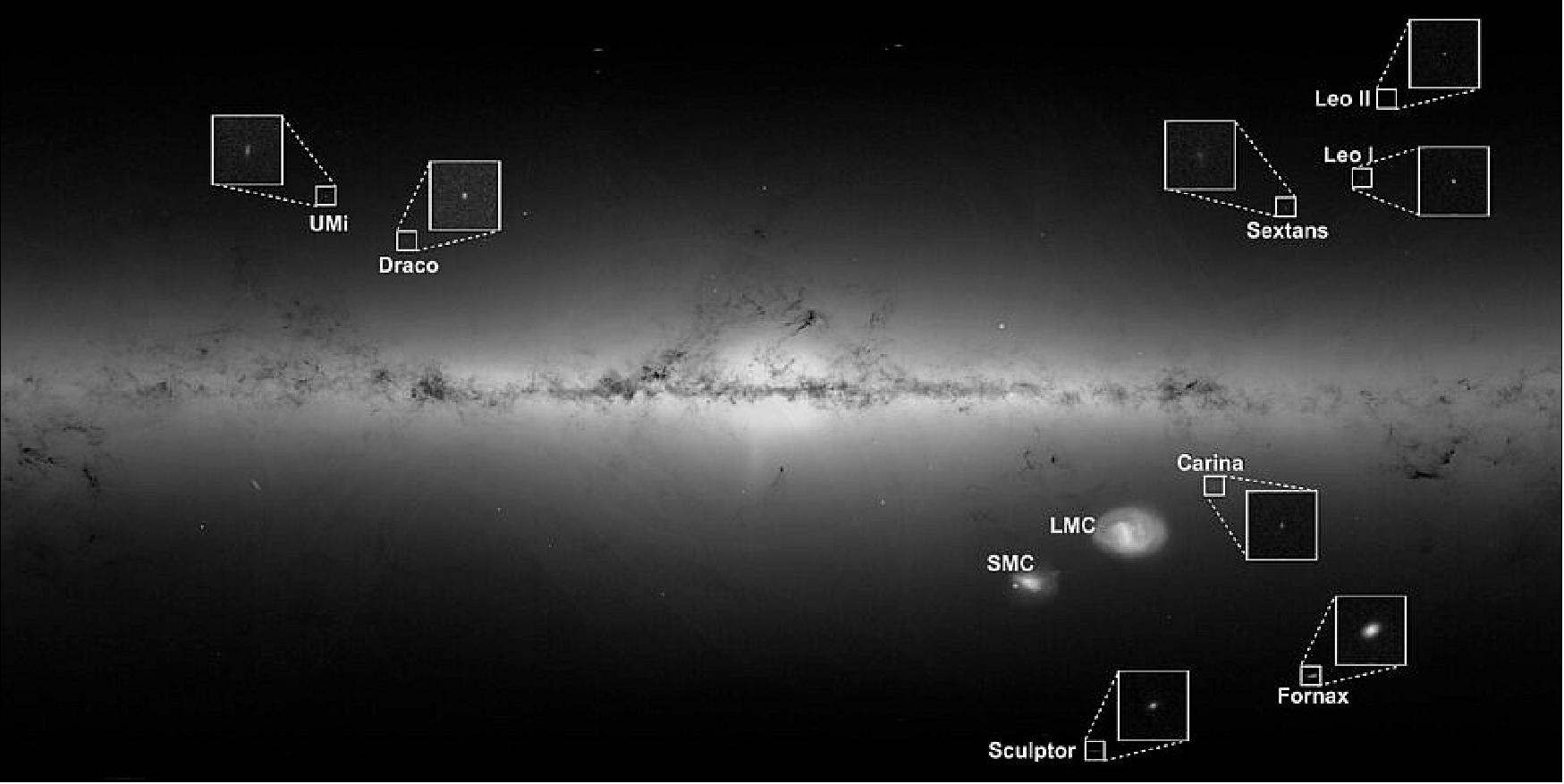
- They found that these galaxies were moving much faster than the giant stars and star clusters that are known to be orbiting the Milky Way. So fast, that they couldn’t be in orbit yet around the Milky Way, where interactions with this galaxy and its contents would have sapped their orbital energy and angular momentum. This galaxy has cannibalised a number of dwarf galaxies in its past. For example, 8-10 billion years ago, a dwarf galaxy called Gaia-Enceladus was absorbed by the Milky Way. Its stars can be identified in Gaia data because of the eccentric orbits and range of energies they possess. More recently, 4-5 billion years ago, the Sagittarius dwarf galaxy was captured by the Milky Way and is currently in the process of being pulled to pieces and assimilated. The energy of its stars is higher than those of Gaia-Enceladus, indicating the shorter time that they have been subject to the Milky Way’s influence.
- In the case of the dwarf galaxies in the new study, which represents the majority of the dwarf galaxies around the Milky Way, their energies are even higher. This strongly suggests that they have only arrived in the vicinity in the last few billion years. The discovery mirrors one made about the Large Magellanic Cloud (LMC). The LMC was also thought to be a satellite galaxy of the Milky Way until the 2000s, when astronomers measured its velocity and found that it was travelling too fast to be gravitationally bound. Instead of a companion, LMC visited for the first time. The same is true for most of the dwarf galaxies too. Estimates vary by a factor of two. The discovery of the dwarf galaxy energies is significant because it forces re-evaluation of the nature of the dwarf galaxies themselves. As a dwarf galaxy orbits, the Milky Way’s gravitational pull will try to wrench it apart. Dark matter is the mysterious substance that astronomers think exists in the universe to provide the extra gravity to hold individual galaxies together. And so, in the traditional view that the Milky Way’s dwarfs were satellite galaxies that had been in orbit for many billions of years, it was assumed that they must be dominated by dark matter to balance the Milky Way’s tidal force and keep them intact.51)
• June 7, 2021: Tightly packed clusters of stars are visible as smudges in the night sky. Clusters are stellar nurseries where thousands of stars are born from clouds of gas and dust and then disperse across the Milky Way.
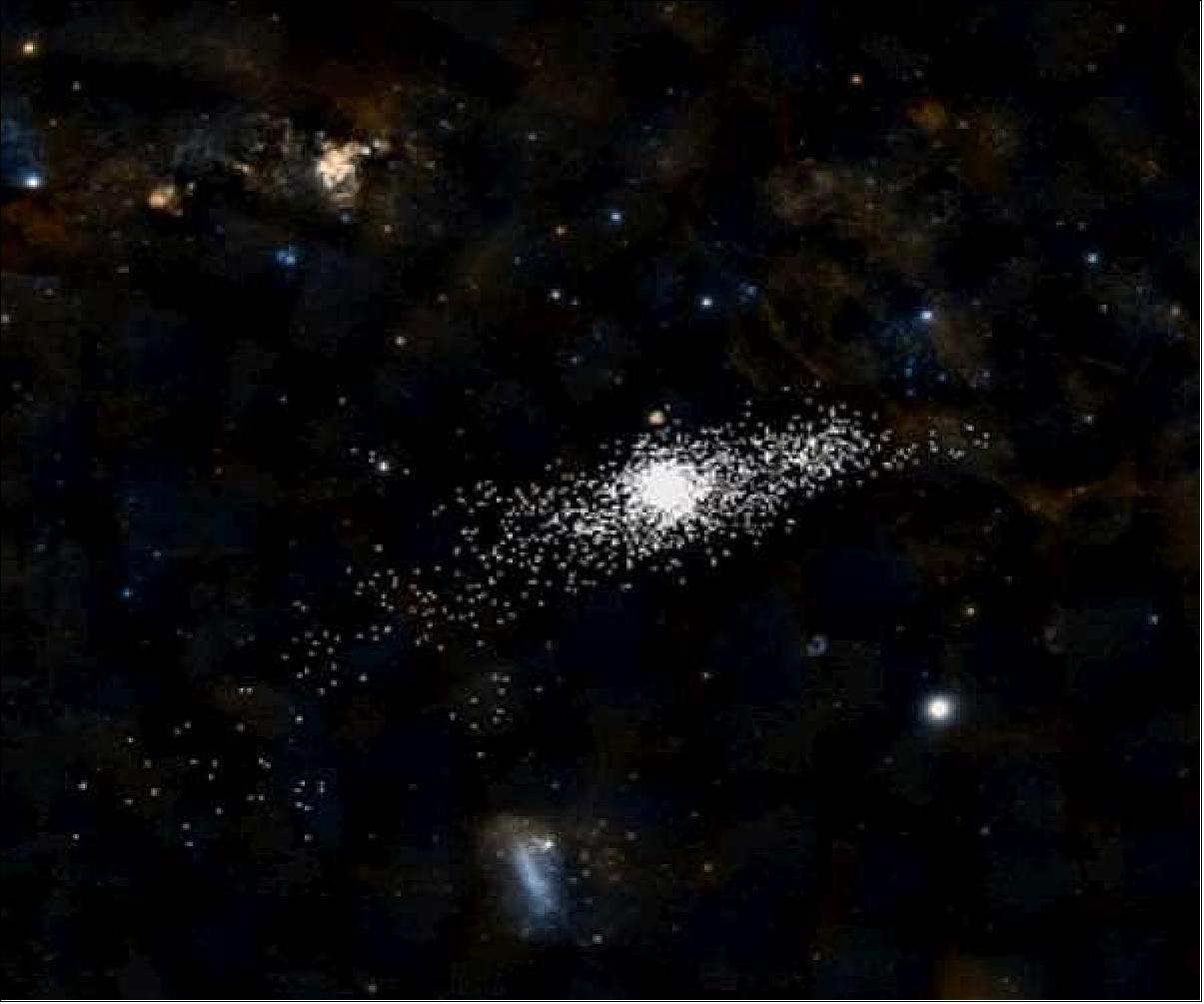
- For centuries, scientists have speculated about whether these clusters always form tight clumps like the Pleiades, spread over only a few dozen lightyears. Then, two years prior, a machine-learning algorithm using data from the Gaia satellite identified that many far-flung stars are moving at the same speed and direction and could therefore be part of the same open cluster—but as more of a stream or a string than a clump. One of these streams of stars, NGC 2516, also known as the Southern Beehive, extends at least 1,600 light-years—500 parsecs—from tip to tip. To an Earth-based stargazer, that would look as big as 40 full moons, side by side, stretching across the sky. The researchers demonstrated that many stars with similar masses are all spinning at (or very near) the same rate, confirming that they were born in the same stellar nursery. The sun, which at the age of 4.6 billion years old is in its sedate middle age, rotates once every 27 days. The stars Bouma measured in NGC 2516 are rotating 10 times faster than the sun, because they are so much younger. Those stars are only about 150 million years old. 53)
• April 21, 2021: Astronomers using data from NASA and ESA (European Space Agency) telescopes have released a new all-sky map of the outermost region of this galaxy. Known as the galactic halo, this area lies outside the swirling spiral arms that form the Milky Way’s recognisable central disk and is sparsely populated with stars. Though the halo may appear mostly empty, it is also predicted to contain a massive reservoir of dark matter, a mysterious and invisible substance thought to make up the bulk of all the mass in the universe. 54)
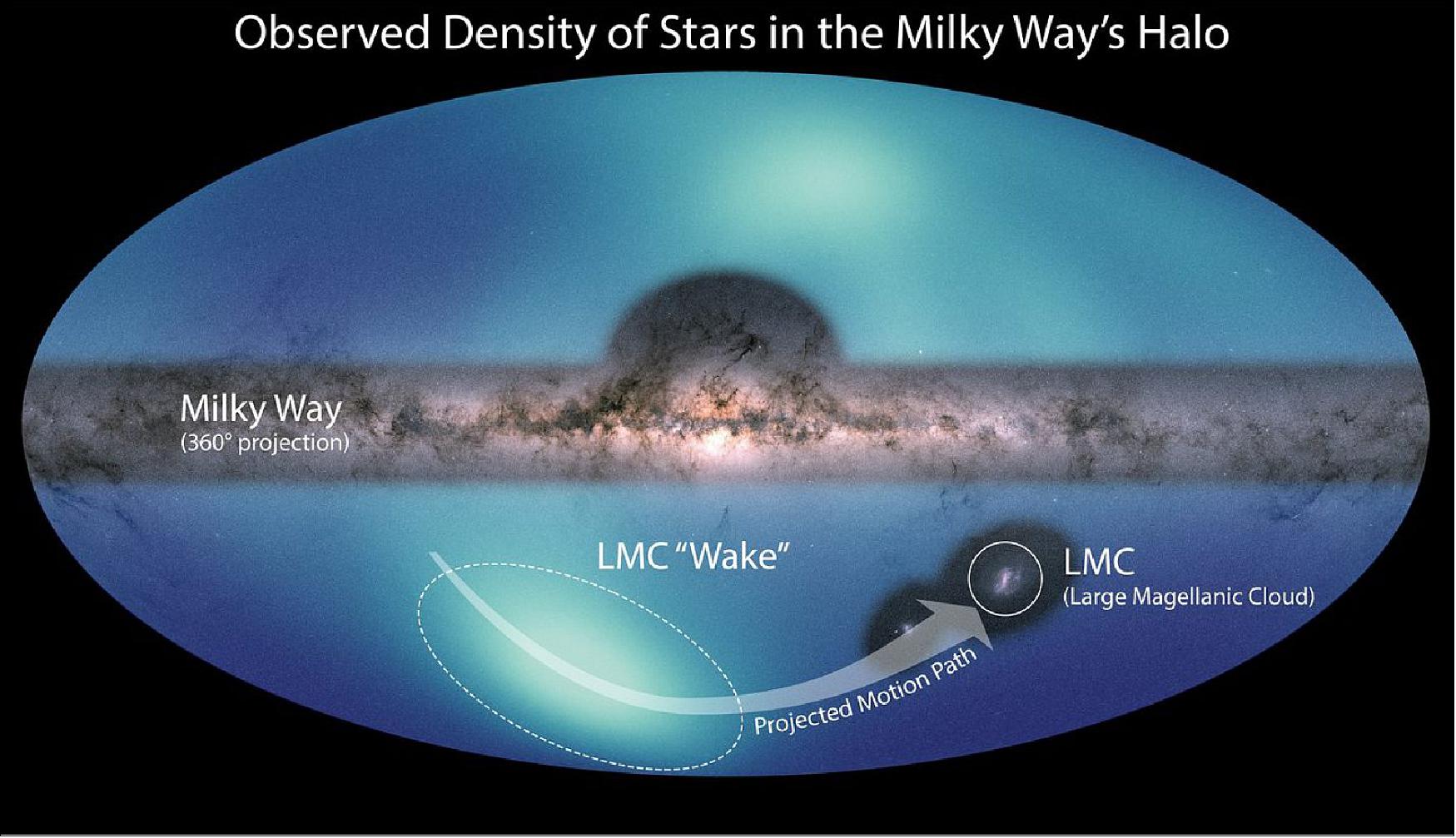
- Known as the galactic halo, this area lies outside the swirling spiral arms that form the Milky Way’s recognisable central disk and is sparsely populated with stars. Though the halo may appear mostly empty, it is also predicted to contain a massive reservoir of dark matter, an invisible substance thought to make up the bulk of all the mass in the universe. The data for the new map comes from ESA’s Gaia mission and NASA’s NEOWISE (Near Earth Object Wide Field Infrared Survey Explorer) mission, which operated from 2009 to 2013 under the moniker WISE. The study made use of data collected by the spacecraft between 2009 and 2018. The new map revealed how a small galaxy called the Large Magellanic Cloud (LMC) – so named because it is the larger of two dwarf galaxies orbiting the Milky Way – sailed through the Milky Way’s galactic halo, its gravity creating a wake in the stars behind it. The LMC is located about 160,000 light-years from Earth and is less than one-quarter the mass of the Milky Way.
- Though the inner portions of the halo have been mapped with a high level of accuracy, this is the first map to provide a similar picture of the halo’s outer regions, where the wake is found – about 200,000 light-years to 325,000 light-years from the galactic centre. Previous studies have hinted at the wake’s existence, but the all-sky map confirms its presence and offers a detailed view of its shape, size, and location. This disturbance in the halo also provided astronomers with an opportunity to study something they can’t observe directly: dark matter. Although there are multiple theories about the nature of dark matter, all of them indicate that it should be present in the Milky Way’s halo. The wake observed in the new star map is thought to be the outline of this dark matter wake; the stars are like leaves on the surface of this invisible ocean, their position shifting with the dark matter. The interaction between the dark matter and the Large Magellanic Cloud has big implications for this galaxy. As the LMC orbits the Milky Way, the dark matter’s gravity drags on the LMC and slows it down.55)
• March 24, 2021: Data from ESA’s Gaia star mapping satellite have revealed evidence that the nearest star cluster to the Sun is being disrupted by the gravitational influence of a massive but unseen structure in this galaxy. 56)
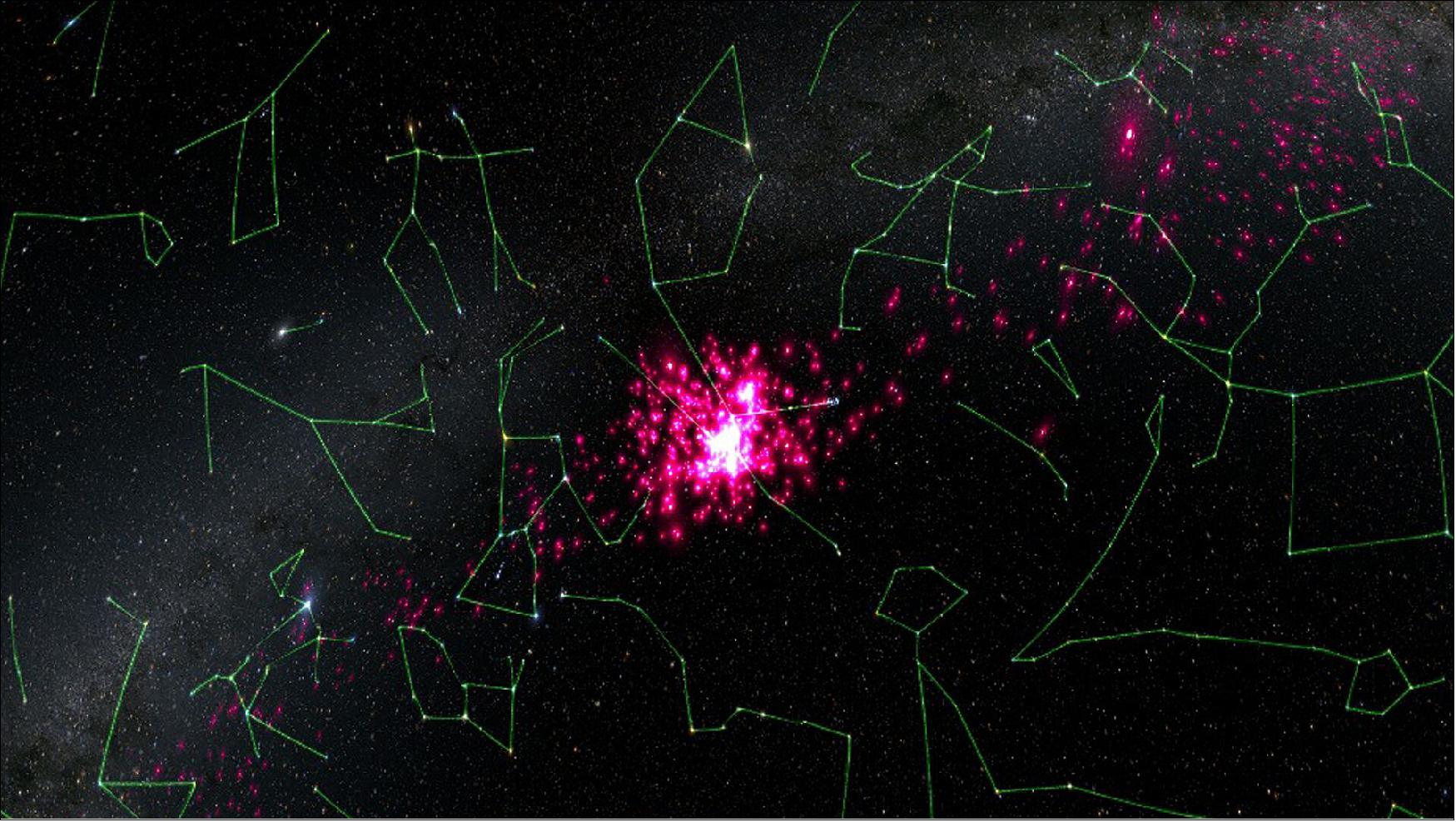
- If true, this might provide evidence for a suspected population of ‘dark matter sub-halos’. These invisible clouds of particles are thought to be relics from the formation of the Milky Way, and are now spread across the galaxy, making up an invisible substructure that exerts a noticeable gravitational influence on anything that drifts too close. The team chose the Hyades as their target because it is the nearest star cluster to the Sun. It is located just over 153 light years away, and is easily visible to skywatchers in both northern and southern hemispheres as a conspicuous ‘V’ shape of bright stars that marks the head of the bull in the constellation of Taurus. Beyond the easily visible bright stars, telescopes reveal a hundred or so fainter ones contained in a spherical region of space, roughly 60 light years across. A star cluster will naturally lose stars because as those stars move within the cluster they tug at each other gravitationally. This constant tugging slightly changes the stars’ velocities, moving some to the edges of the cluster. From there, the stars can be swept out by the gravitational pull of the galaxy, forming two long tails.
- One tail trails the star cluster, the other pulls out ahead of it. They are known as tidal tails, and have been widely studied in colliding galaxies but no one had ever seen them from a nearby open star cluster, until very recently. Previous attempts by other teams had met with only limited success because the researchers had only looked for stars that closely matched the movement of the star cluster. This excluded members that left earlier in its 600–700 million year history and so are now travelling on different orbits. But the real surprise was that the trailing tidal tail seemed to be missing stars. This indicates that something much more brutal is taking place than the star cluster gently ‘dissolving’. The object could be a dark matter sub-halo. These are naturally occurring clumps of dark matter that are thought to help shape the galaxy during its formation. This new work shows how Gaia is helping astronomers map out this invisible dark matter framework of the galaxy.57)
• December 03, 2020: The motion of stars in the outskirts of this galaxy hints at significant changes in the history of the Milky Way. This and other equally fascinating results come from a set of papers that demonstrate the quality of ESA’s Gaia Early third Data Release (EDR3), which was made public December 03, 2020. 58)
- Gaia EDR3 included: 1,811,709,771 sources with positions to provide the best ever sky map; 1,467,744,818 sources with parallax and proper motion to reveal their distances and motions; 1,806,254,432 sources with the measurement of their brightness in white light; 1,542,033,472 sources with the brightness of the objects in blue lightl; 1,554,997,939 sources with the brightness of the objects in red light (a comparison of the blue and the red light provides information of the temperature of the object); 1,614,173 extragalactic sources to provide a reference frame for measuring ‘absolute’ positions and motions. Gaia EDR3 contained detailed information on more than 1.8 billion sources, detected by the Gaia spacecraft. This represents an increase of more than 100 million sources over the previous data release (Gaia DR2), which was made public in April 2018. Gaia EDR3 also contained colour information for around 1.5 billion sources, an increase of about 200 million sources over Gaia DR2. As well as including more sources, the general accuracy and precision of the measurements has also improved.
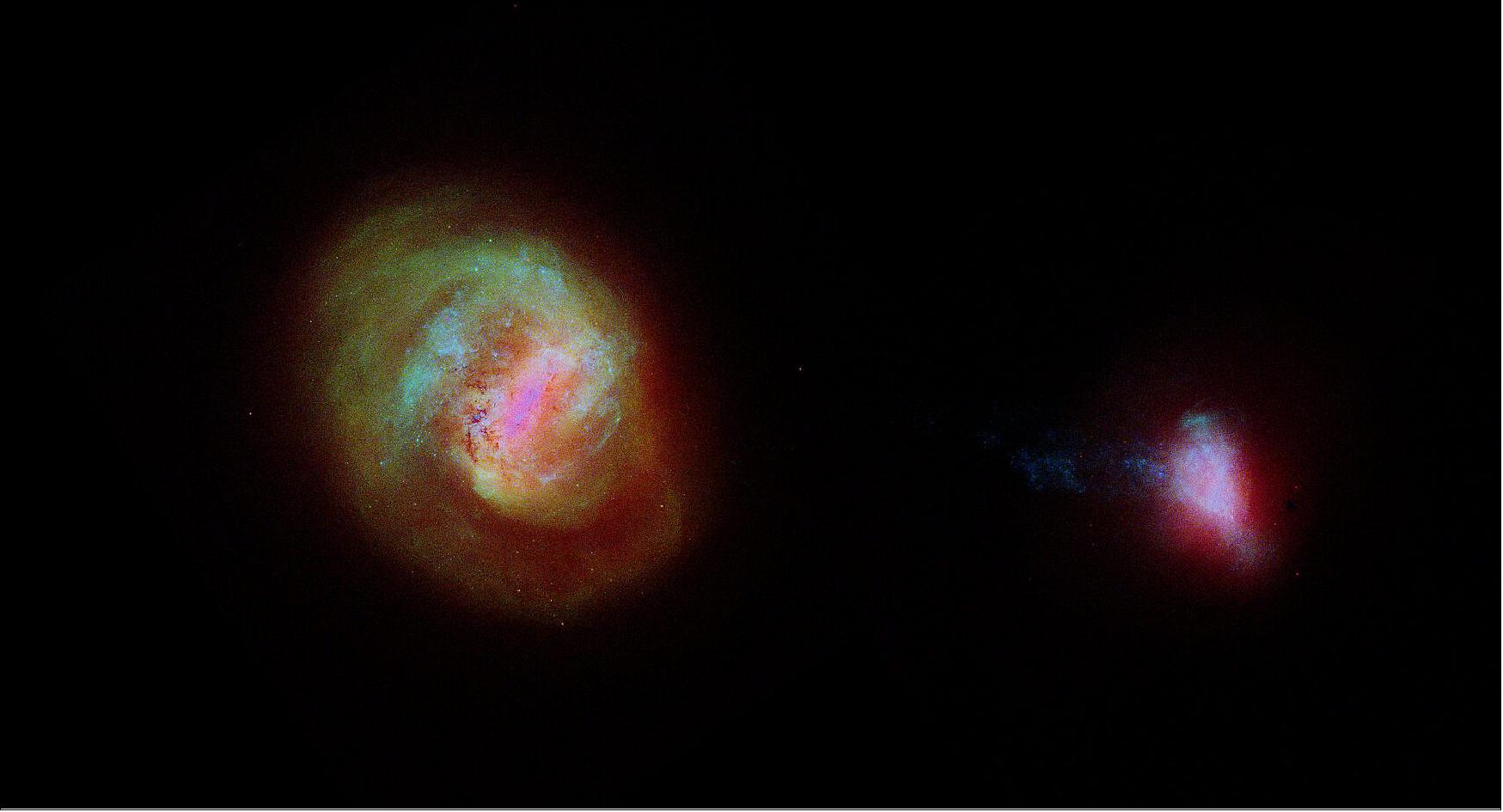
- The new Gaia data allowed astronomers to trace the various populations of older and younger stars out towards the very edge of this galaxy – the galactic anticenter. The new data enabled analysis of the relics of the 10 billion-year-old ancient disc and so determine its smaller extent compared to the Milky Way’s current disc size. The new data from these outer regions also strengthen the evidence for another major event in the more recent past of the galaxy. The data show that in the outer regions of the disc there is a component of slow-moving stars above the plane of this galaxy that are heading downwards towards the plane, and a component of fast-moving stars below the plane that are moving upwards.
• October 15, 2020: The closest and brightest star clusters to Earth, like the Pleiades, are readily visible to the naked eye and are prominent members of the night sky, where they appear as tight concentrations of stars. 60) 61) ESA's GAIA allowed astronomers at the University of Vienna have now discovered that star clusters are only the tip of the iceberg of a much larger and often distinctly elongated distribution of stars. To find the lost star siblings, the research team developed a new method that uses machine learning to trace groups of stars which were born together and move jointly across the sky. The team analysed 10 star clusters and identified thousands of siblings far away from the center of the compact clusters, yet clearly belonging to the same family. An explanation for the origin of these coronae remains uncertain, yet the team is confident that their findings will redefine star clusters and aid understanding of their history and evolution across cosmic time.
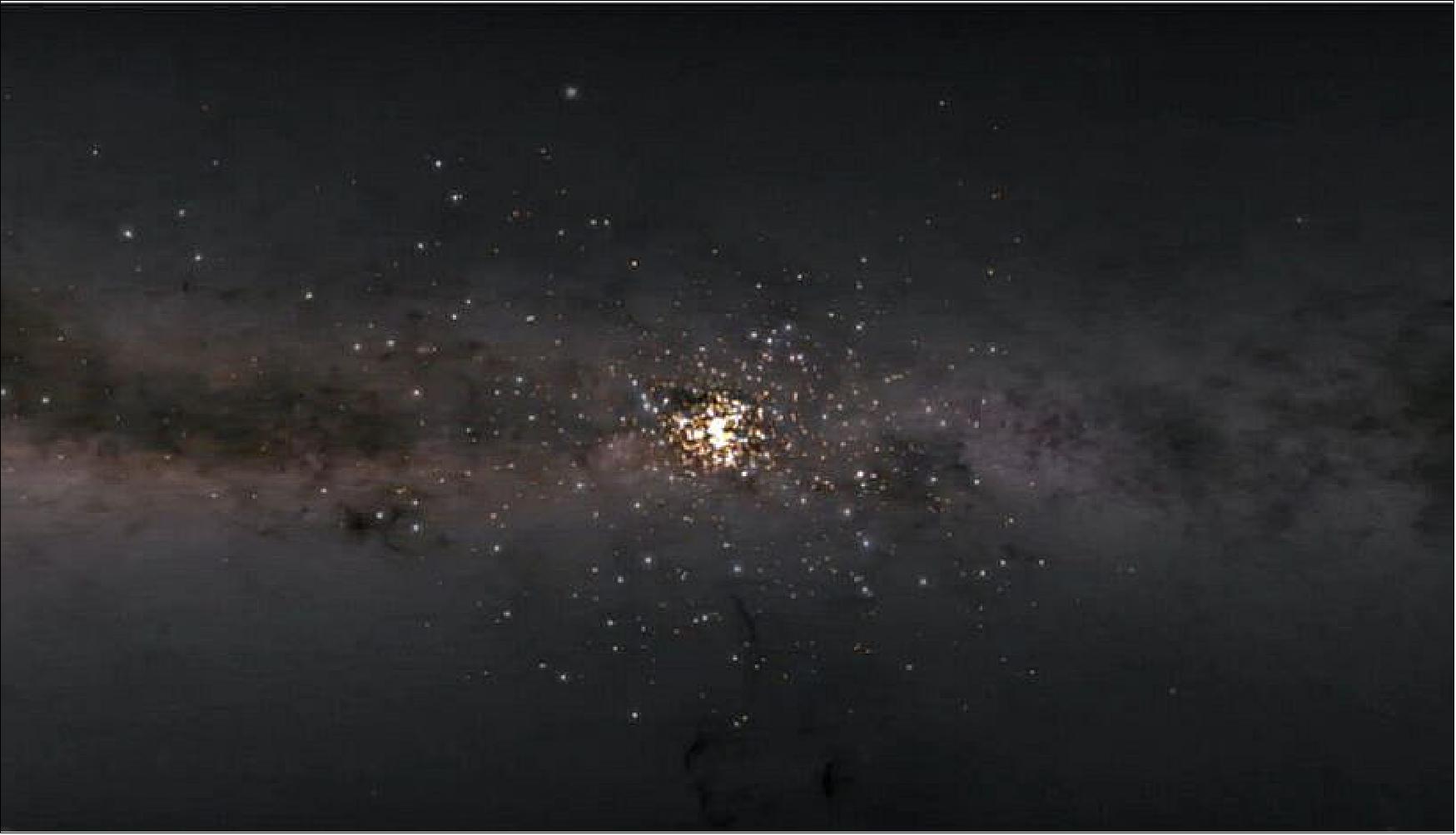
• July 1, 2020: By accurately mapping the stars, ESA's Gaia is helping researchers track down lost asteroids. 63) Gaia charts the galaxy by repeatedly scanning the entire sky. Over the course of its planned mission, it observed each of its more than one billion target stars around 70 times to study how their position and brightness change over time.
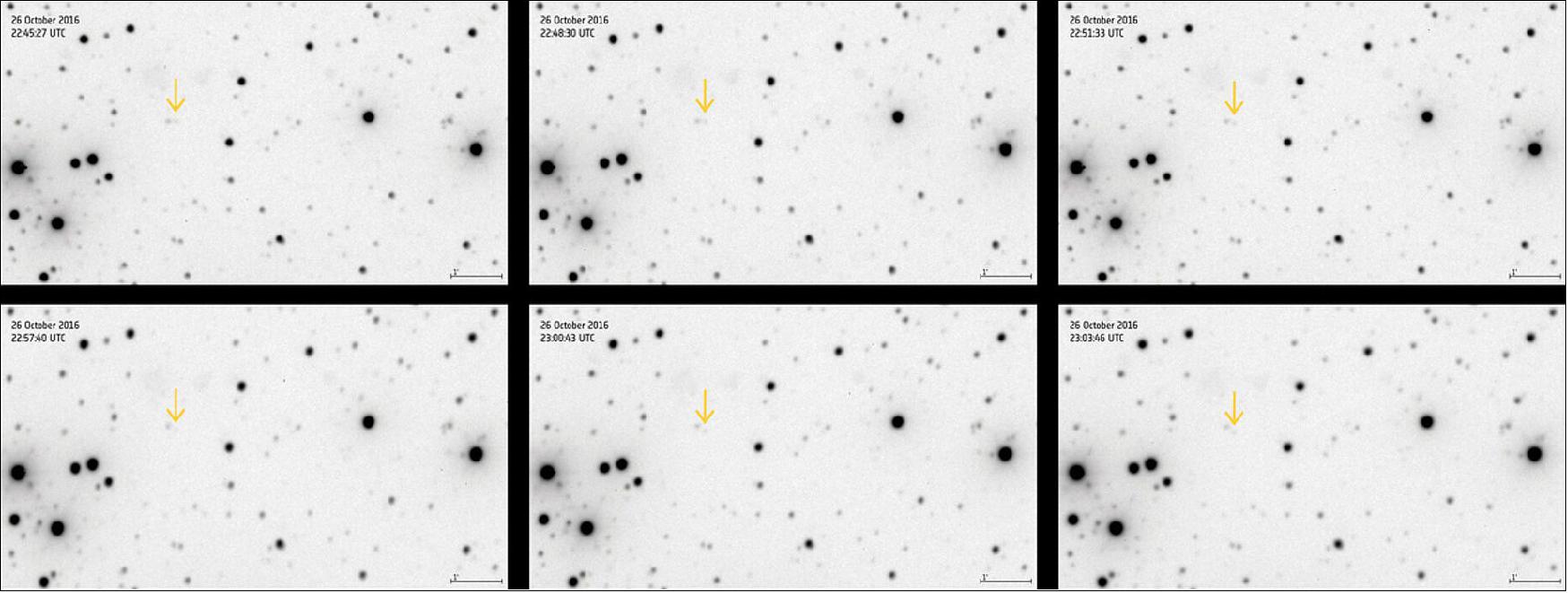
- To move across Gaia’s field of view so quickly, these objects must be located much closer to Earth. By checking the positions of these objects against the catalogues of known Solar System bodies, many of these objects turn out to be known asteroids. However, Gaia’s highly accurate measurements of the positions of stars provide an indirect benefit for asteroid tracking. In collaboration with the European Southern Observatory (ESO), the team took part in an observation campaign targeting 2012 TC4, a small asteroid that was due to pass by the Earth. Where it would appear in the sky at the time of the upcoming campaign was not well known. This same technique was then and is being applied to asteroids that were never lost, allowing researchers to use data from Gaia to determine their trajectories and physical properties more accurately than ever before. This is helped them update asteroid population models and deepen understanding of how asteroid orbits develop, for example, by measuring subtle dynamical effects that play a key role in pushing small asteroids into orbits that could see them collide with Earth.
- Gaia orbits around the second Lagrange point, L2, of the Sun-Earth system. This location keeps the Sun, Earth and Moon all behind Gaia, allowing it to observe a large portion of the sky without their interference. It is also in an even thermal radiation environment and experiences a stable temperature. However, Gaia must not fall entirely into Earth's shadow, as the spacecraft still depends on solar power. As the orbit around the L2 point is unstable, small disturbances can build up and see the spacecraft heading for an eclipse. Gaia's flight control team at ESA's ESOC mission control center in Darmstadt are responsible for making corrections to the spacecraft's trajectory to keep it in the correct orbit and out of Earth's shadow. On 16 July 2019, the team successfully performed a crucial eclipse avoidance maneuver, moving Gaia into the extended phase of its mission and allowing it to keep scanning the sky for several more years.
• June 5, 2020: A team of Sheffield scientists studied groups of young stars in the Milky Way to see if these groups were typical compared to theories and previous observations in other star-forming regions in space, and to study if the populations of stars in these groups affected the likelihood of finding forming Earth-like planets. 64)
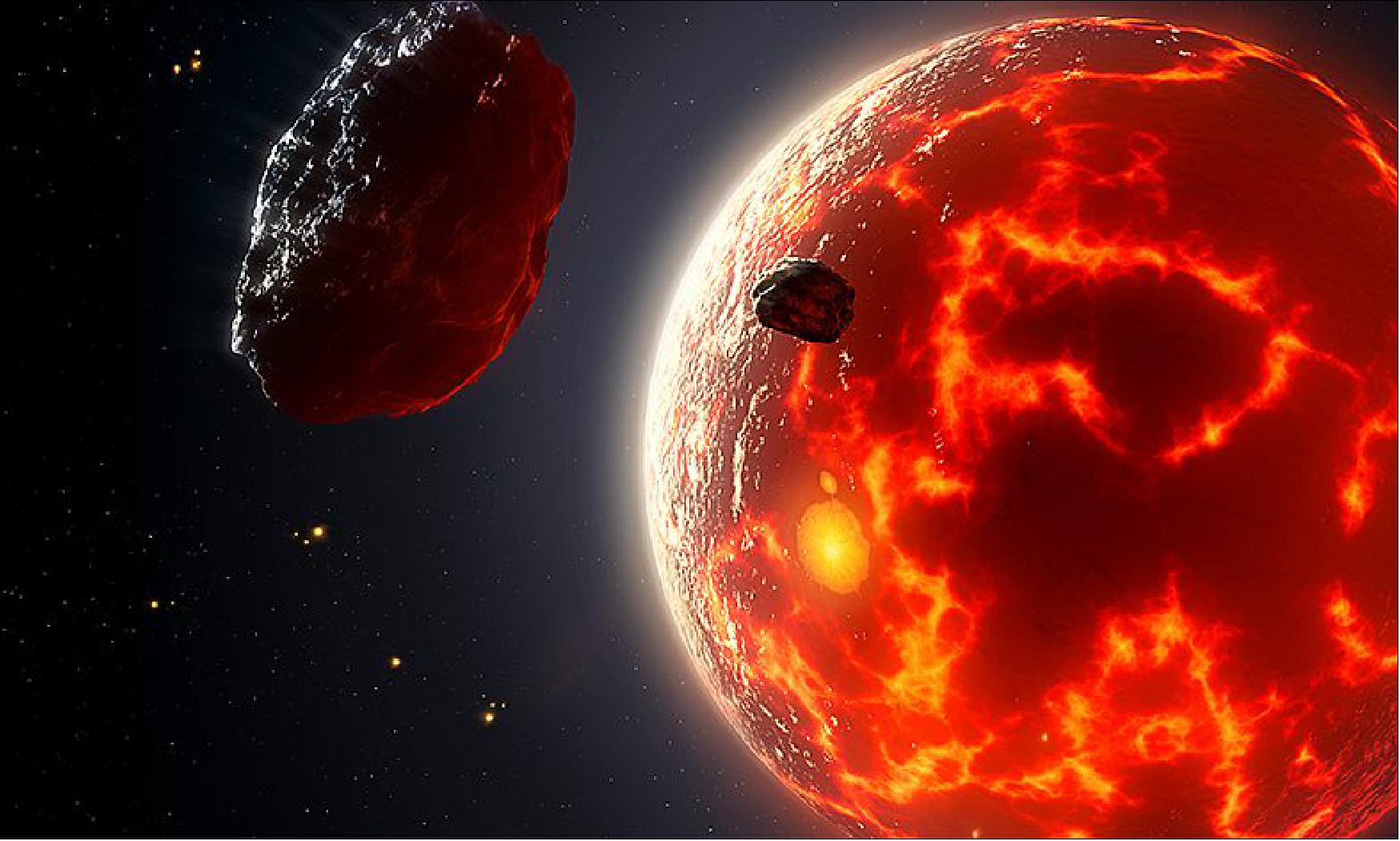
• June 4, 2020: An artificial intelligence system analysing data from the Gaia space telescope has identified more than 2,000 large protostars - and they could hold clues to the origins of the stars in the Milky Way. 66) Protostars are young stars that are still forming. Scientists had previously catalogued only 100 of this type of forming star. Investigation of these newly identified stars had the potential to change scientists' understanding of massive star formation and their approach to studying the galaxy. The researchers took the vast quantity of data being collected by the Gaia spaceborne telescope as it maps the galaxy.
- The researchers cleaned that data and reduced it to a subset of 4.1 million stars which were likely to contain the target protostars. The artificial intelligence (AI) system sifted the data and generated a list of 2,226 stars with around an 85 percent chance of being a Herbig Ae/Be protostar. One of the target stars is known as Gaia DR2 428909457258627200. It is 8,500 light years away and has a mass 2.3 times that of the sun. Its surface temperature is 9,400 degrees Celsius – the sun is about 5,500 degrees Celsius – and it has a radius that is twice that of the sun. It has existed for around six million years, which in astronomical terms makes it a young star that is still forming. The research was funded by the European Union's Horizon 2020 research and innovation program, under the STARRY project.
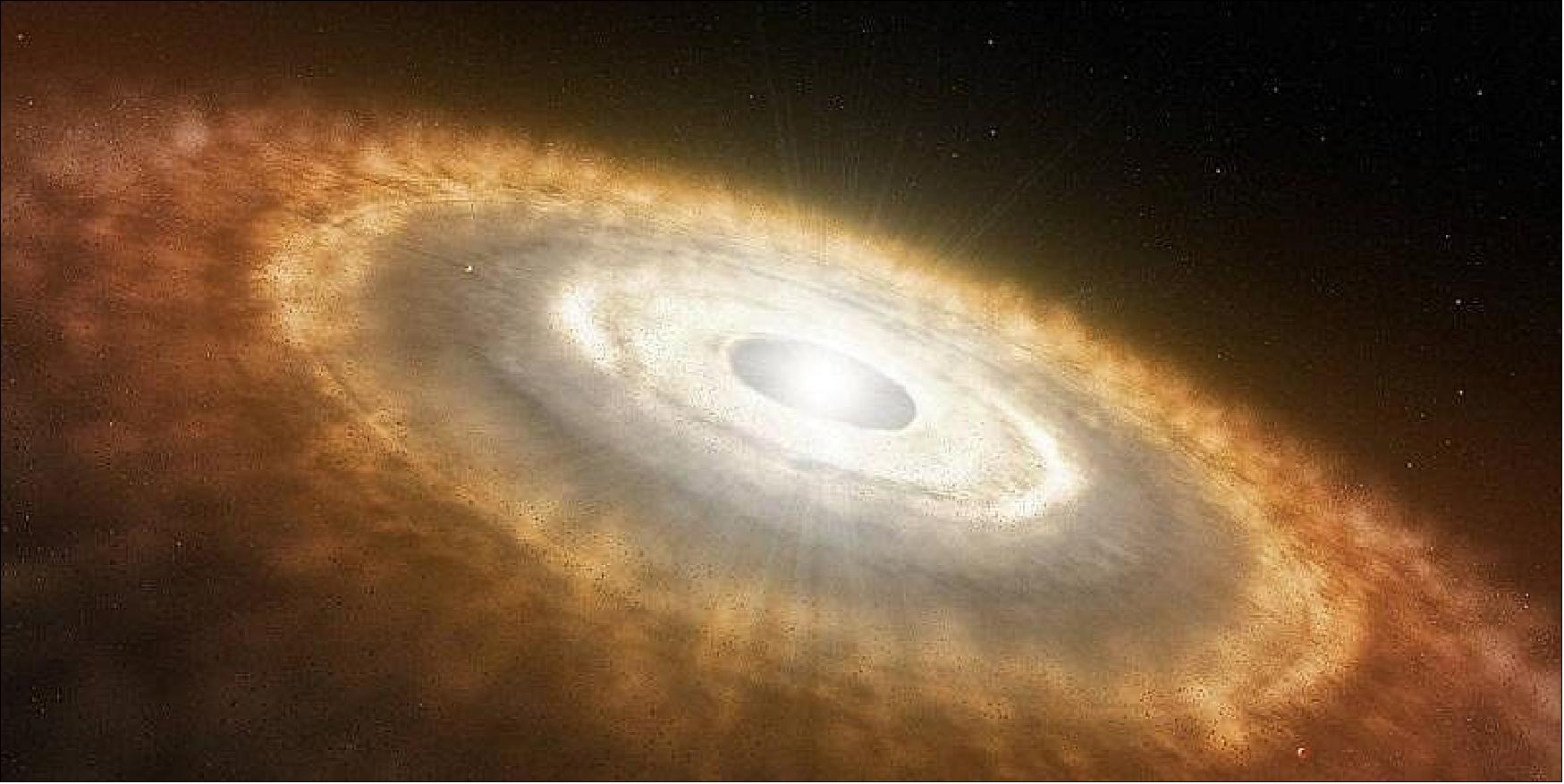
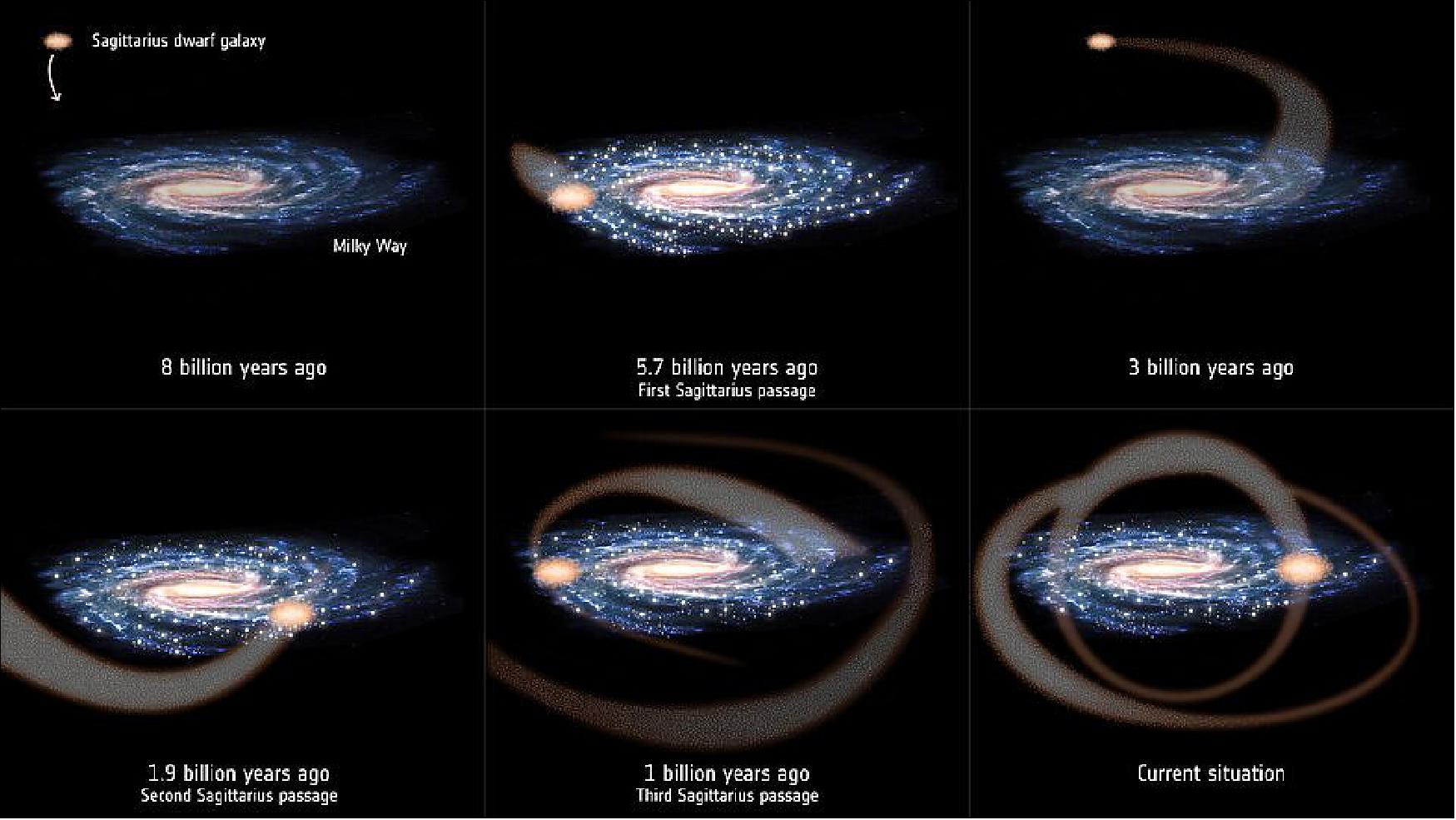
- The effects of Sagittarius on the structure and movement of stars in the Milky Way have been described previously, but the new findings for the first time show that the dwarf galaxy was likely directly responsible for the build-up of the stellar mass in the Milky Way. It, however, seems possible that without the dwarf galaxy crossing paths with the Milky Way, Earth and life on it may not have been born. In fact, it seems possible that even the Sun and its planets would not have existed if the Sagittarius dwarf had not gotten trapped by the gravitational pull of the Milky Way and eventually smashed through its disc. Every collision stripped Sagittarius of some of its gas and dust, leaving the galaxy smaller after each passage.
• April 25, 2020: The Gaia Mission celebrated the second anniversary of Gaia Data Release 2 (DR2). In the previous 2 years, almost 3000 refereed papers based on Gaia Data Release 2 had been published.
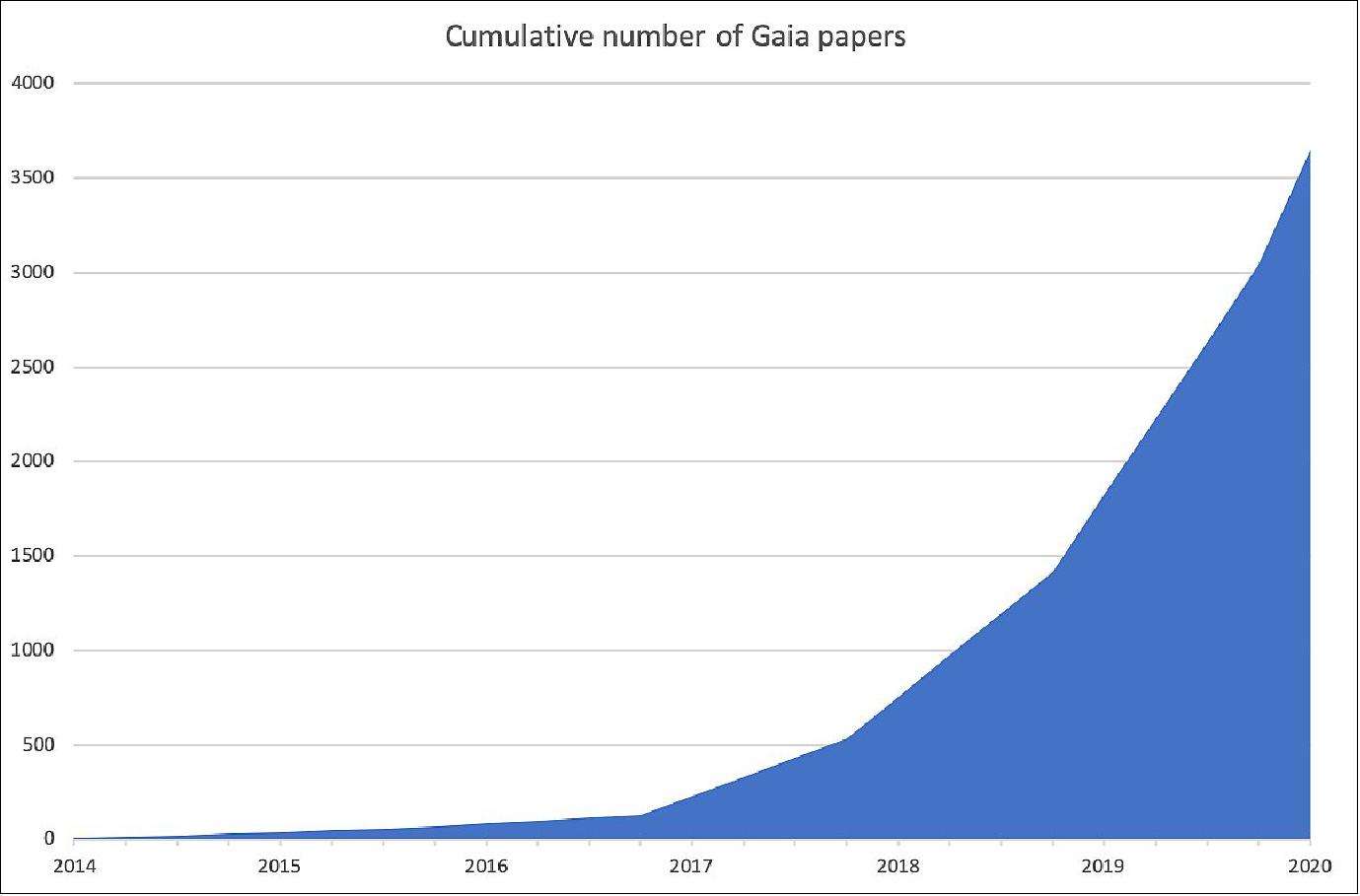
• March 2, 2020: Astronomers have pondered for years why the Milky Way, is warped. Data from ESA's star-mapping satellite Gaia suggest the distortion might be caused by an ongoing collision with another, smaller, galaxy, which sends ripples through the galactic disc like a rock thrown into water. 73)
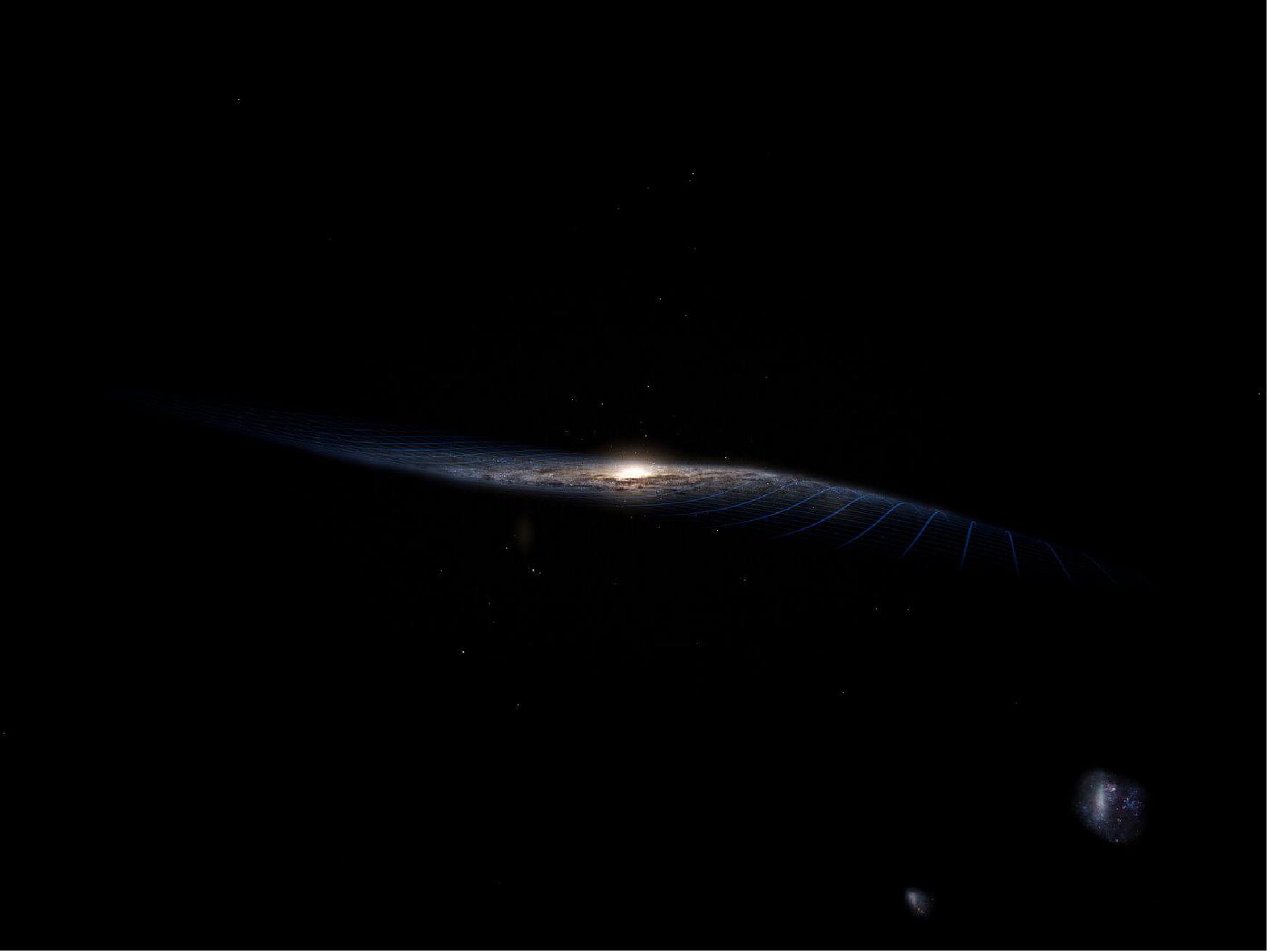
- Astronomers have known since the late 1950s that the Milky Way's disc – where most of its hundreds of billions of stars reside – is not flat but somewhat curved upwards on one side and downwards on the other. For years, they debated what was causing this warp. They proposed various theories including the influence of the intergalactic magnetic field or the effects of a dark matter halo, a large amount of unseen matter that is expected to surround galaxies. If such a halo had an irregular shape, its gravitational force could bend the galactic disc.
- A team of scientists using data from the second Gaia data release has now confirmed previous hints that this warp is not static but changes its orientation over time. Astronomers call this phenomenon precession and it could be compared to the wobble of a spinning top as its axis rotates. Moreover, the speed at which the warp processes is much faster than expected – faster than the intergalactic magnetic field or the dark matter halo would allow. The warp's speed is, however, slower than the speed at which the stars themselves orbit the galactic centre. Such insights were only possible thanks to the unprecedented ability of the Gaia mission to map the Milky Way, in 3D, by accurately determining the positions of more than one billion stars in the sky and estimating their distance from us. As impressive as the warp and its precession appear on the galactic scale, although it has no noticeable effects on life on Earth.
• February 13, 2020: A sizable international team published findings about the discovery of a new binary star in Astronomy & Astrophysics (Ref. 79). 75)
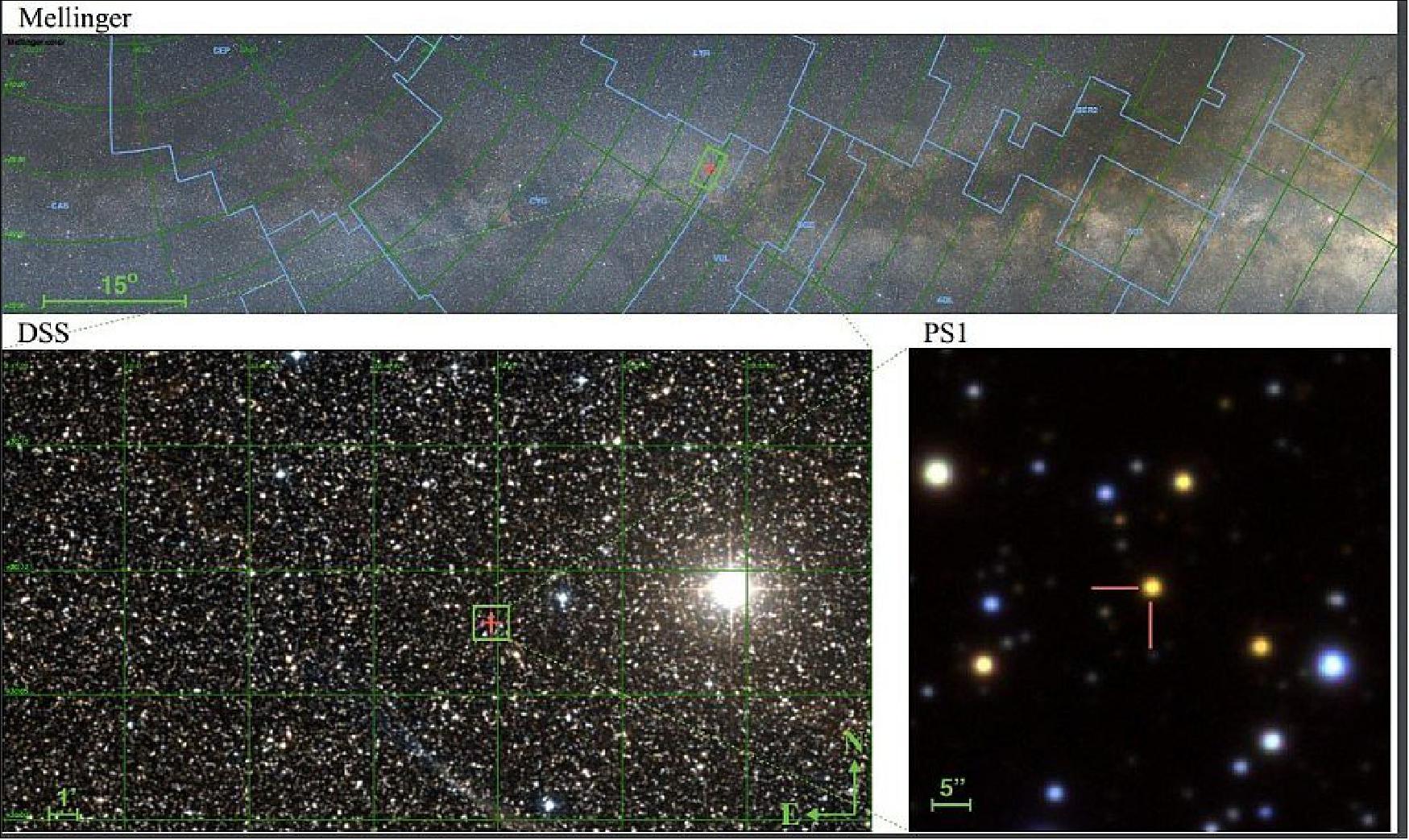
- Gravitational lensing is a powerful tool for space exploration. Photons deviate from their straight path when passing near a massive body due to its gravitational field, causing an increase in the brightness of the star, reflected on the light curve without changing the star's physical parameters. When a massive object crosses the line of sight between a star and an observer on Earth, it causes a brief brightening of the background star, known as a gravitational microlensing event. These events are rare and unpredictable. To detect microlensing events in the Milky Way, hundreds of millions of stars had to be tracked daily. The European Space Agency's GAIA mission reports significant brightness changes to Earth, after which international telescopes track these objects to identify their variability.
- Since 2016, Kazan Federal University and Turkish colleagues have participated in the GAIA classification program. Most variable objects are cataclysmic variables, supernovae, or active galactic nuclei, but some show temporary brightness changes. The data allowed simulation of the complex movement involving an observer on Earth and a binary system. The Gaia16aye event's light curve suggested a binary system due to the appearance of multiple peaks. Polish scientists created a geometric model of the Gaia16aye microlensing phenomenon through international collaboration and theoretical calculations.
• February 10, 2020: Scientists from Rochester Institute of Technology discovered a newborn massive planet closer to Earth than any other of similarly young age found to date. The baby giant planet, called 2MASS 1155-7919 b, is located in the Epsilon Chamaeleontis Association and lies only about 330 light years from the solar system. 76) The discovery, published in the Research Notes of the American Astronomical Society, provided researchers with an exciting new way to study how gas giants form. The scientists used data from the Gaia space observatory to make the discovery. The giant baby planet orbits a star that is only about 5 million years old, about one thousand times younger than the sun. The planet orbits its sun at 600 times the distance of the Earth to the sun. The authors hope that follow-up imaging and spectroscopy will help astronomers understand how massive planets can end up in such wide orbits.
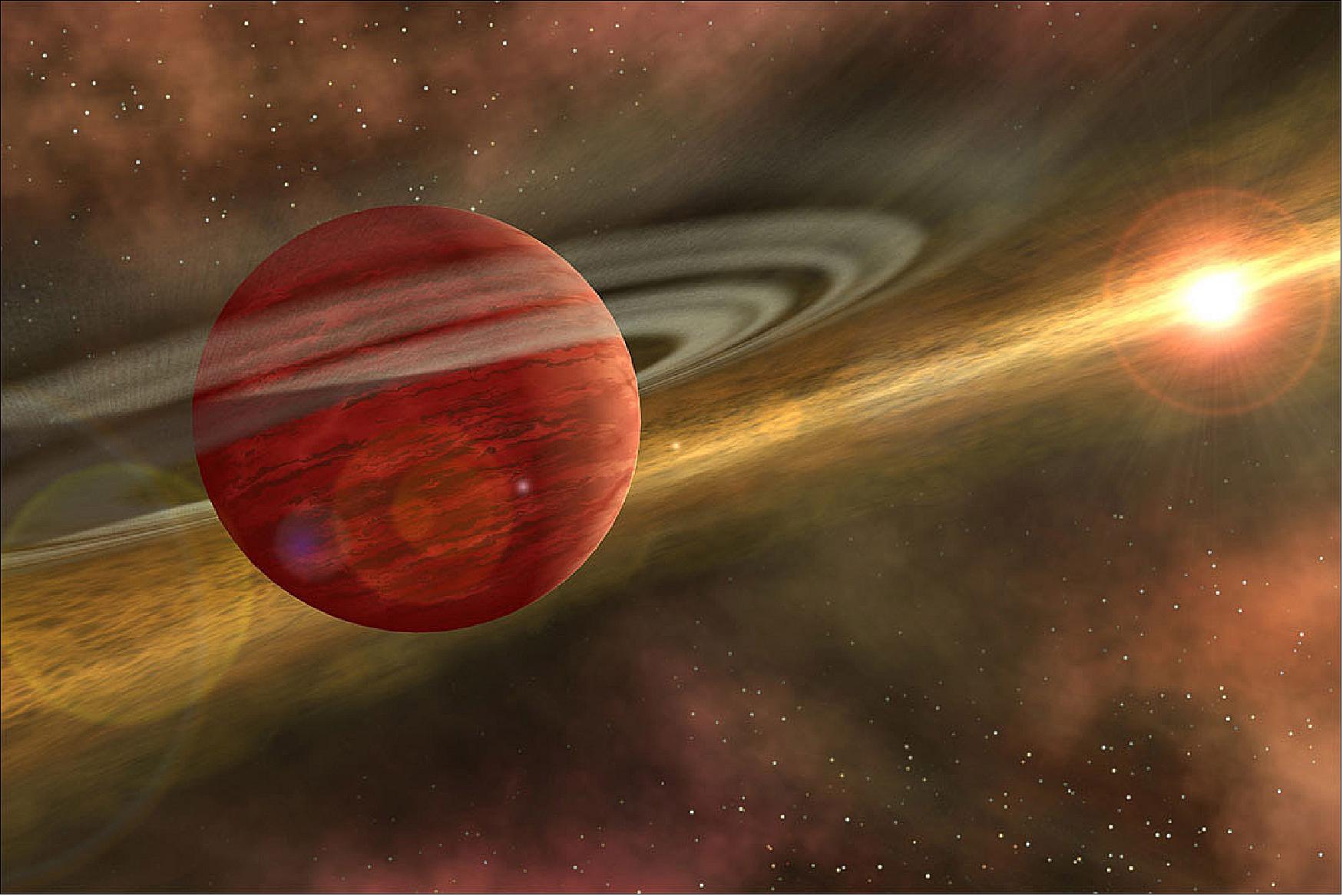
• January 21, 2020: A 500-day global observation campaign spearheaded more than three years ago by ESA's galaxy-mapping Gaia provided insights into the binary system of stars that caused an unusual brightening of an even more distant star. 77)
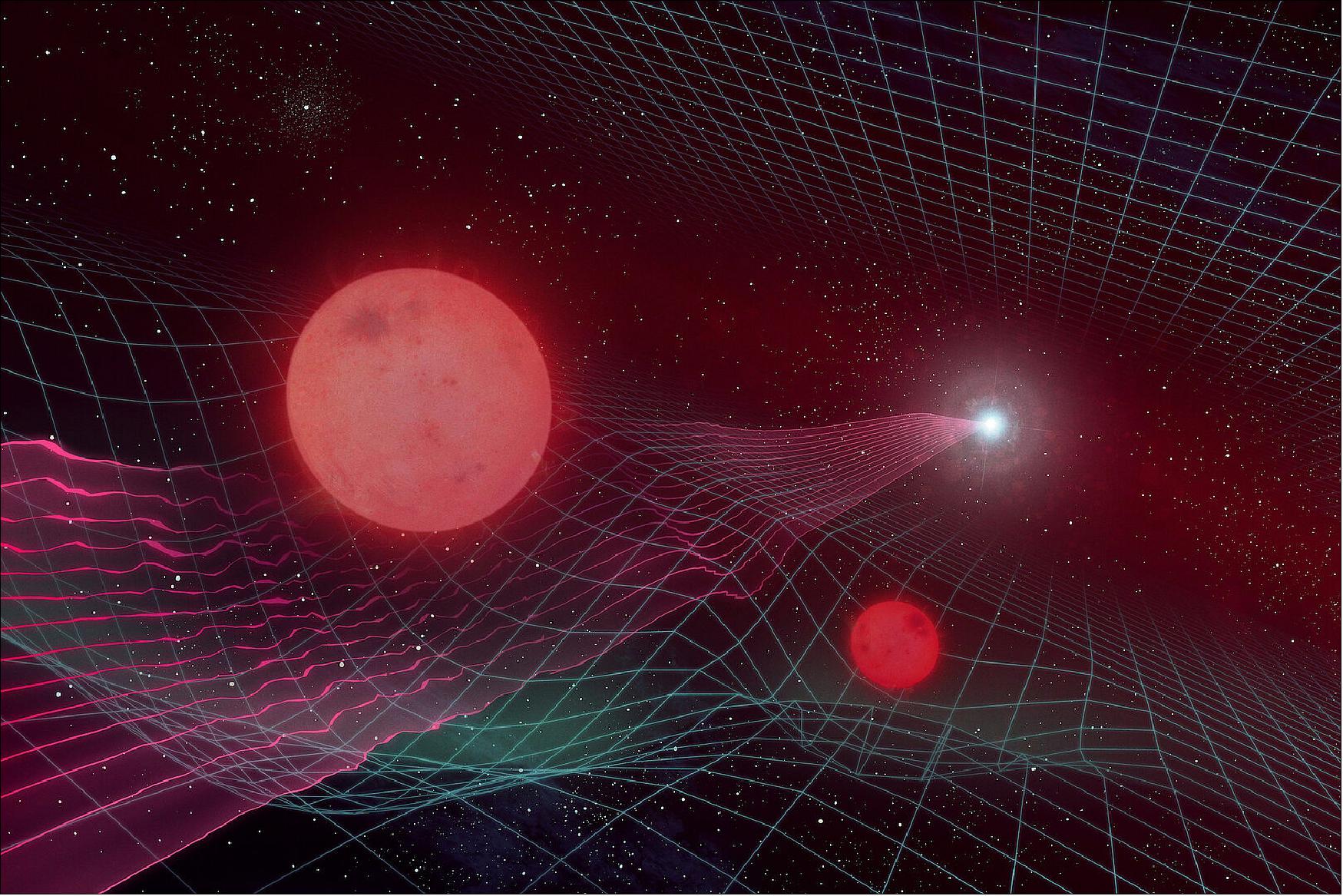
- The brightening of the star, located in the Cygnus constellation, was first spotted in August 2016 by the Gaia Photometric Science Alerts program. This system, maintained by the Institute of Astronomy at the University of Cambridge, UK, scans daily the huge amount of data coming from Gaia and alerts astronomers to the appearance of new sources or unusual brightness variations in known ones, so that they can quickly point other ground and space-based telescopes to study them in detail. In this particular instance, follow-up observations performed with more than 50 telescopes worldwide revealed that the source – since then named Gaia16aye after Ayers Rock, the famous landmark in Australia – was behaving in a rather strange way. This brightening was caused by gravitational microlensing – an effect predicted by Einstein's theory of general relativity, caused by the bending of spacetime in the vicinity of very massive objects, like stars or black holes.
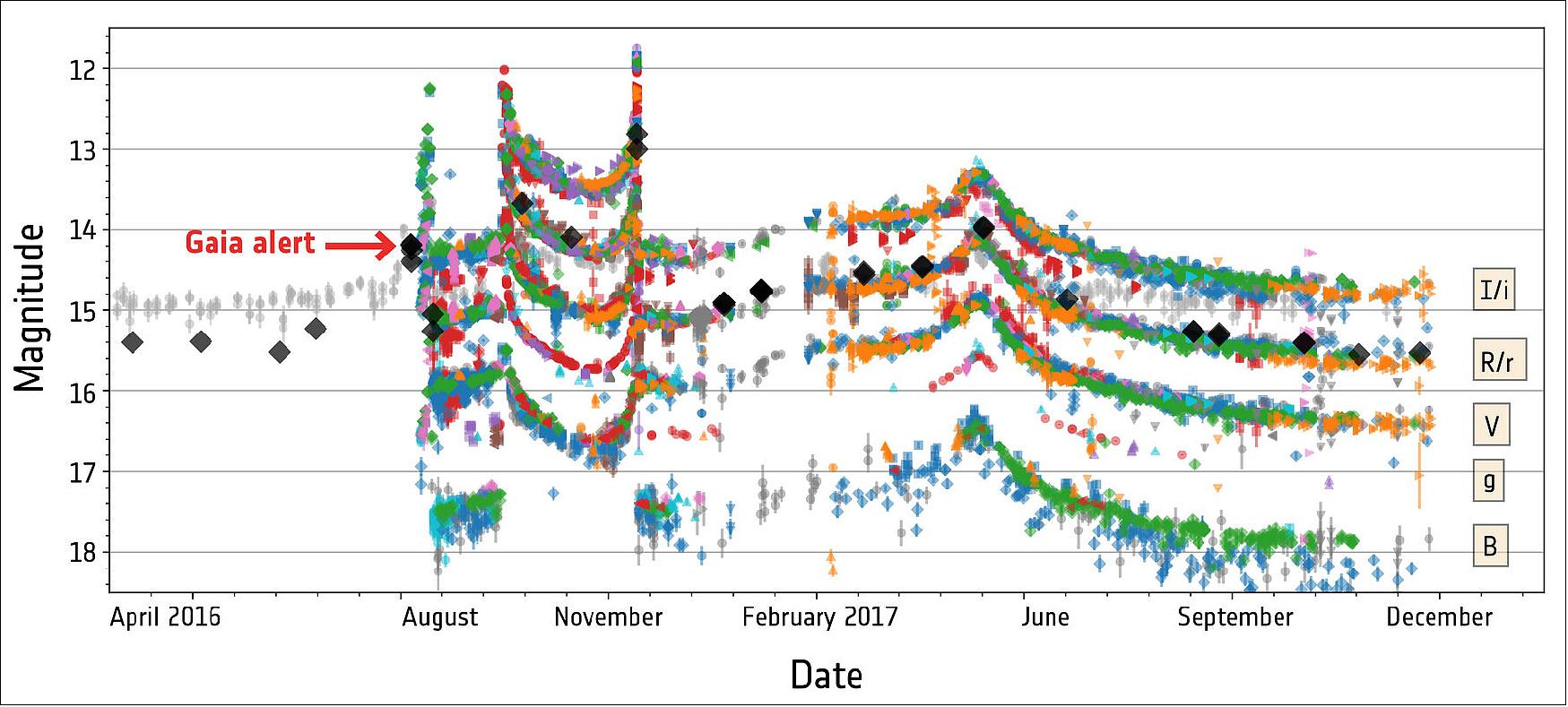
- This sudden and sharp drop in brightness suggested that the gravitational lens causing the brightening must consist of a binary system – a pair of stars, or other celestial objects, bound to one another by mutual gravity. The combined gravitational fields of the two objects produce a lens with a rather intricate network of high magnification regions. When a background source passes through such regions on the plane of the sky, it lights up, and then dims immediately upon exiting it. From the pattern of subsequent brightenings and dimmings, the astronomers were able to deduce that the binary system was rotating at a rather fast pace. The long period of observations, which lasted until the end of 2017, and the extensive participation of ground-based telescopes from around the globe enabled the astronomers to gather a large amount of data – almost 25,000 individual data points.
• January 7, 2020: Astronomers at Harvard University have discovered a monolithic, wave-shaped gaseous structure — the largest ever seen in this galaxy — made up of interconnected stellar nurseries. Dubbed the "Radcliffe Wave" in honor of the collaboration's home base, the Radcliffe Institute for Advanced Study, the discovery transforms a 150-year-old vision of nearby stellar nurseries as an expanding ring into one featuring an undulating, star-forming filament that reaches trillions of miles above and below the galactic disk. 80)
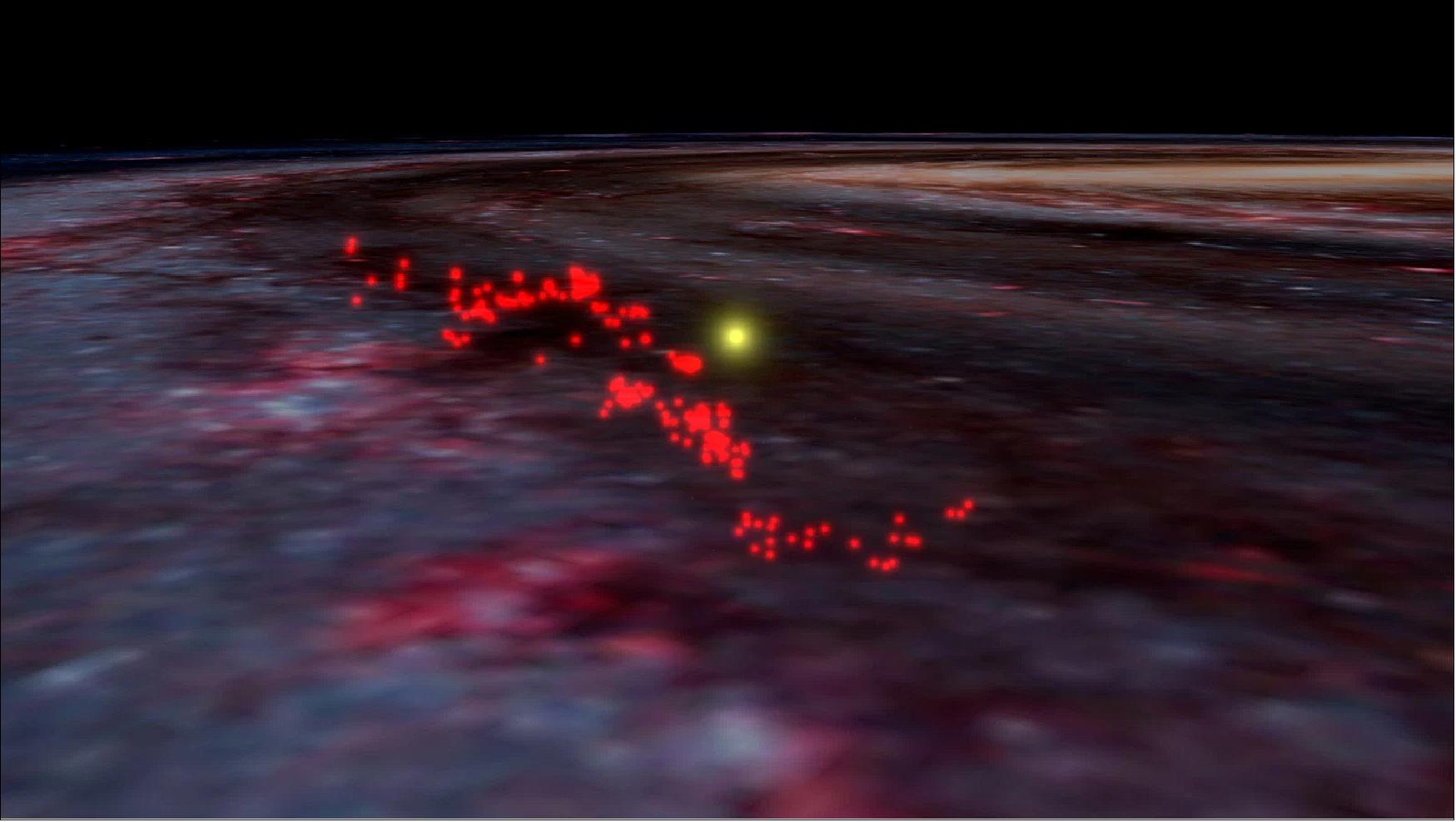
- The researchers discovered a long, thin structure, about 9,000 light-years long and 400 light-years wide, with a wave-like shape, cresting 500 light-years above and below the mid-plane of the Milky Way's disk. The Wave includes many of the stellar nurseries that were thought to form part of "Gould's Belt," a band of star-forming regions believed to be oriented in a ring around the sun. The new, 3D map showed the Milky Way in a new light, giving researchers a revised view of the Milky Way and opening the door to other major discoveries. In earlier studies, the research group at Harvard, pioneered advanced statistical techniques to map the 3D distribution of dust using vast surveys of stars' colours. Before Gaia, there was no data set expansive enough to reveal the galaxy's structure on large scales. Since its launch in 2013, the space observatory has enabled measurements of the distances to one billion stars in the Milky Way.
PLM (Payload Module)
The payload module is housed inside a geometrical, dome-like structure called the 'Thermal Tent' (Figures 14 and 15). The payload consists of a single integrated instrument (Figure 56) that comprises three major functions. In the earlier spacecraft designs, the three functions were distributed over three separate instruments. Now the three functions are built into a single instrument by using common telescopes and a shared focal plane: 82) 83) 84) 85) 86)
1) The Astrometric instrument (ASTRO) is devoted to star angular position measurements, providing the five astrometric parameters:
- Star position (2 angles)
- Proper motion (2 time derivatives of position)
- Parallax (distance)
ASTRO is functionally equivalent to the main Hipparcos instrument.
2) The Photometric instrument provides continuous star spectra for astrophysis in the band 320-1000 nm and the ASTRO chromaticity calibration
3) The RVS (Radial Velocity Spectrometer) provides radial velocity and high resolution spectral data in the narrow band 847-874 nm.
Each function is achieved within a dedicated area on the focal plane. Afocal elements are located close to the focal plane for the photometric and spectroscopic functions, providing dispersion of the star's spectrum along the scan. This allows both functions to take benefit from the two viewing directions and from the large ASTRO aperture, and to operate in densely populated sky areas. RVS is implemented as a grating plate, combined with four prismatic spherical lenses. This allows the necessary dispersion value to be met while correcting most of the telescope aberrations. 87)
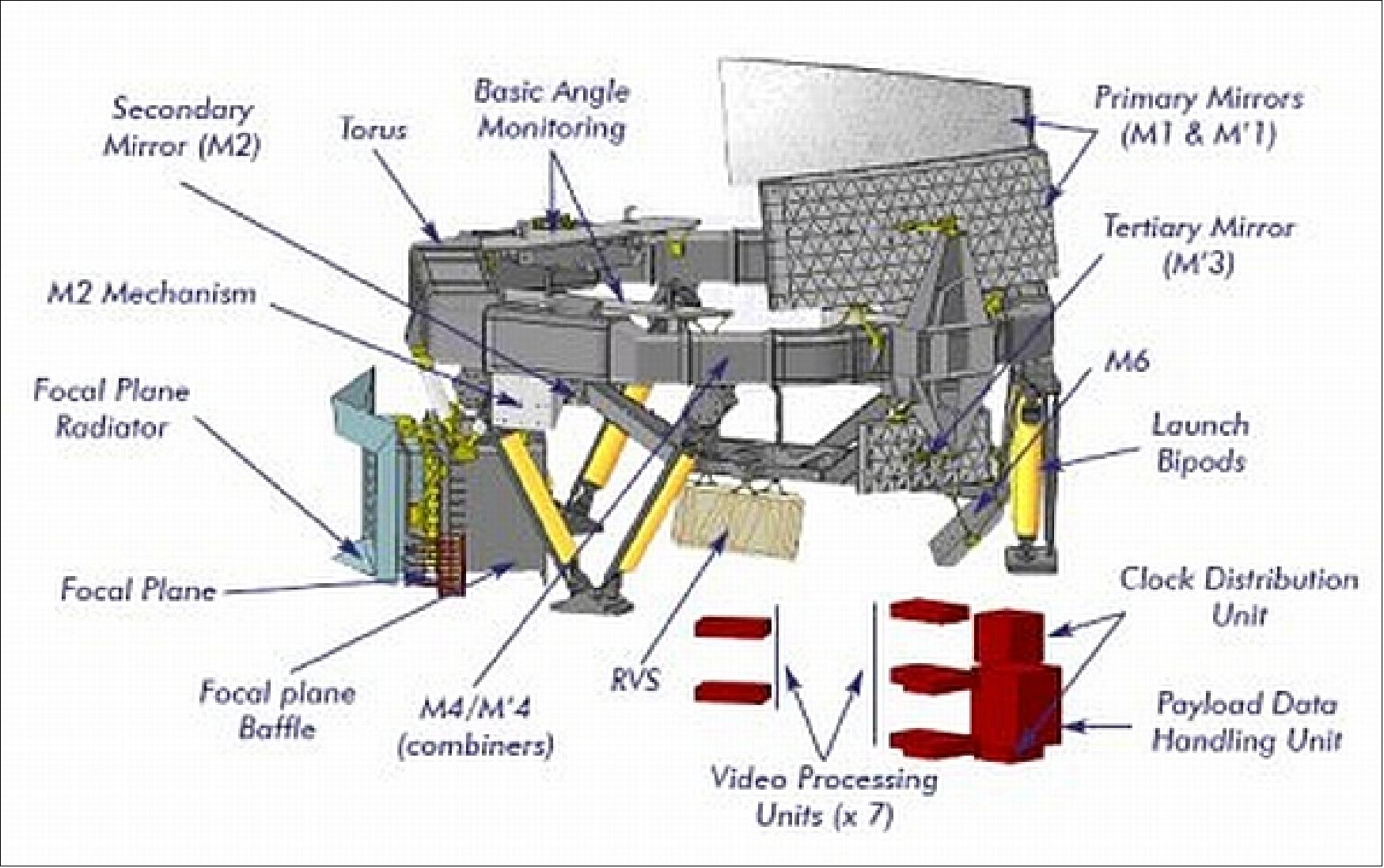
Legend to Figure 56: The focal plane is hanging on the ‘optical bench torus' made of silicon carbide. The optics consist of 10 mirrors and the refractive optical elements. Mirrors M1, M2 and M3 form one telescope and M1', M2', M3' the other telescope. The subsequent set of mirrors M4/M4', M5 and M6 combine the light from both telescopes and direct it to the focal plane assembly. The fields of view of the two telescopes are 106.5º apart (Astrium SAS).
Design:
The payload design is characterised by:
• A dual telescope concept, with a common structure and a common focal plane. Both telescopes are based on a TMA (Three Mirror Anastigmat) design. The beam combination is achieved in image space with a small beam combiner, rather than in object space as was done in the Hipparcos satellite. This saves the mass of the beam combiner, simplifies the accommodation and eliminates the directional ambiguity of the detected targets.
• The use of SiC (Silicon Carbide) ultra-stable material for mirrors and telescope structure provides low mass, isotropy, thermo-elastic stability and dimensional stability in a space environment. This allows to meet the stability requirements for the basic angle between the two telescopes with a passive thermal control instead of an active one.
• A highly robust BAM (Basic Angle Measurement) system.
• A large common focal plane shared by all instruments.
Optics:
Gaia contains two identical telescopes, pointing in two directions separated by a 106.5º basic angle and merged into a common path at the exit pupil. The optical path of both telescopes is composed of six reflectors (M1-M6), the last two of which are common (M5-M6). Both telescopes have an aperture of 1.45 m x 0.5 m and a focal length of 35 m. The telescope elements are built around the hexagonal optical bench with a ~3 m diameter, which provides the structural support.
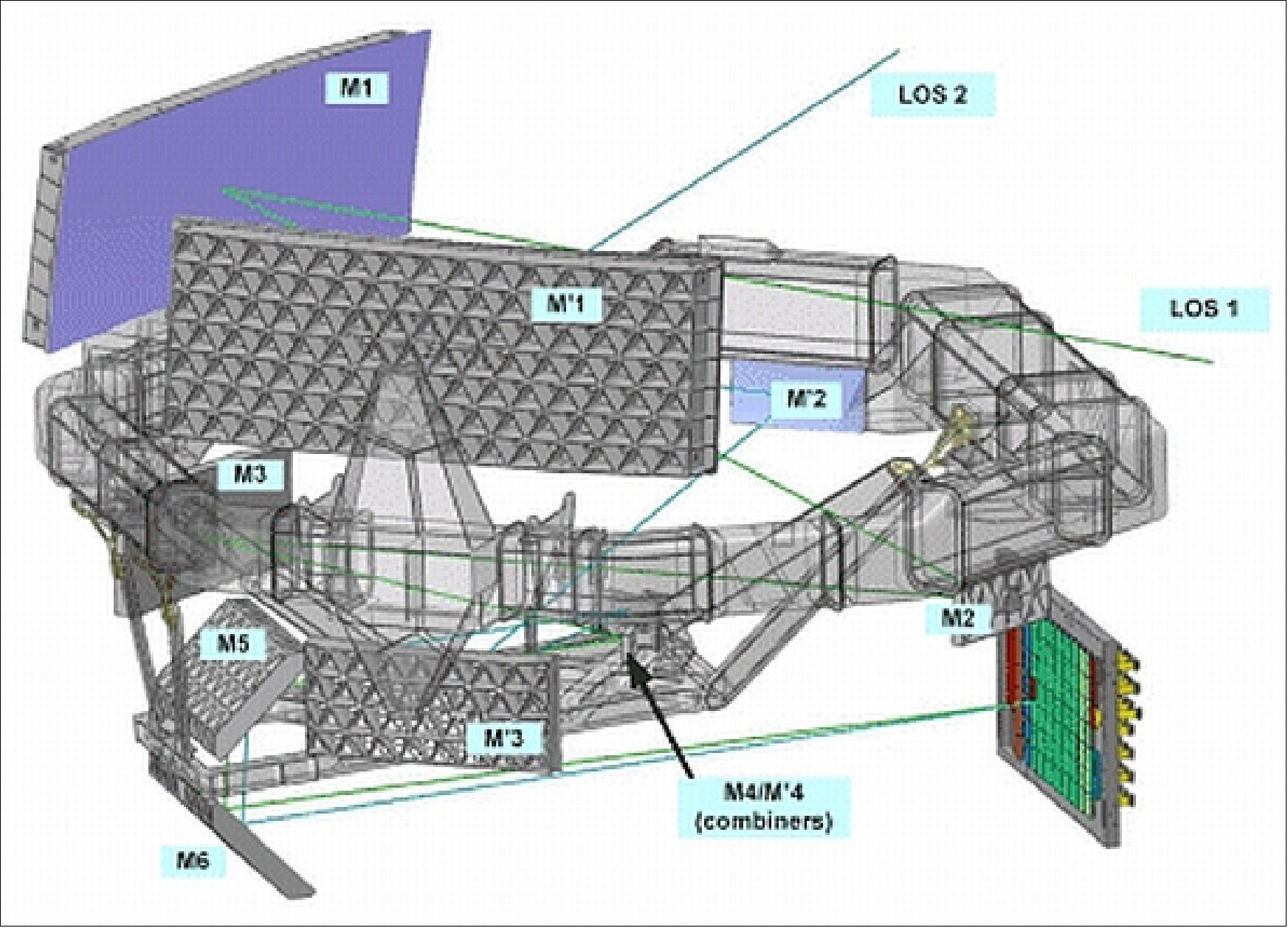
Although the optical design is fully reflective, based on mirrors only, diffraction effects with residual aberrations induce systematic chromatic shifts of the diffraction images and thus of the measured star positions. This effect, usually neglected in optical systems, is also critical for Gaia. These systematic chromatic displacements will be calibrated as part of the on-ground data analysis using the colour information provided by the photometry of each observed object.
Astrometry
The main objective of the astrometric instrument (ASTRO) is to obtain accurate measurements of the relative positions of all objects that cross the fields of view of Gaia's two telescopes. The two fields of view are combined onto the single focal plane.
During its five-year mission, Gaia will systematically scan the whole sky and will have obtained some 70 sets of relative position measurements for each star. These permit a complete determination of each star's five basic astrometric parameters: two specifying the angular position, two specifying the proper motion, and one - the parallax - specifying the star's distance. The five-year long mission also permits the determination of additional parameters, for example those relevant to orbital binaries, extra-solar planets, and solar-system objects.
By measuring the instantaneous image centroids from the data sent to ground, Gaia measures the relative separations of the thousands of stars simultaneously present in the combined two fields. The spacecraft operates in a continuously scanning motion, such that a constant stream of relative angular measurements is built up as the fields of view sweep across the sky. High angular resolution (and hence high positional precision) in the scanning direction is provided by the large primary mirror of each telescope. The wide-angle measurements provide high rigidity of the resulting reference system.
Design: The astrometric instrument (ASTRO) comprises the two telescopes and the dedicated area of 62 CCDs in the focal plane, where the two fields of view are combined onto the AF (Astrometic Field). Each CCD is read out in TDI (Time Delay Integration) mode, synchronised to the scanning motion of the satellite. In practice, stars entering the combined field of view first pass across the column of the SM (Sky Mapper) CCDs, where each object is detected. Information on an object's position and brightness is processed on board in real-time to define the windowed region around the object to be read out by the following CCDs.
On-ground Data Processing: The a posteriori on-ground data processing is a highly complex task, linking all relative measurements and transforming the location (centroiding) measurements in pixel coordinates to angular field coordinates through a geometrical calibration of the focal plane, and subsequently to coordinates on the sky through calibrations of the instrument attitude and basic angle.
Further necessary corrections to be performed include those for optics effects (systematic chromatic shifts and aberration) and general-relativistic effects (light bending due to the Sun, the major planets plus some of their moons, and the most massive asteroids).
Accuracy: The accuracy of the measurements depends on the stellar type and relies on the stability of the basic angle of 106.5° between the two telescopes. This angle is monitored by the BAM (Basic Angle Monitoring) system.
Photometry
The photometer will measure the SED (Spectral Energy Distribution) of all the detected objects. This will serve two goals:
• From the SED measurements, astrophysical quantities such as luminosity, effective temperature, mass, age, and chemical composition are derived
• In order to meet the astrometric performance requirements, the measured centroid positions must be corrected for systematic chromatic shifts induced by the optical system. This is only possible with the knowledge of the spectral energy distribution of each observed target in the wavelength range covered by the CCDs of the main astrometric field (~320-1000 nm).
Design: The photometer (like the spectrometer) is merged with the astrometric function, using the same large collecting apertures of the two telescopes. The photometry function is achieved by means of two low dispersion optics located in the common path of the two telescopes: one for the short wavelengths (BP) and one for the long wavelengths (RP).
- BP (Blue Photometer): Measurement in the 320-660 nm spectral range
- RP (Red Photometer): Measurement in the 650-1000 nm spectral range.
The baseline design uses only one prismatic element in fused silica for each photometer, to disperse the collected light along scan prior to detection.
The prisms are located at the nearest possible position from the focal plane, in order to facilitate the mechanical holding and moreover reduce the shadowed areas. Both prisms are attached to the box shaped CCD radiator directly in front of the detector array. Both photometers, BP and RP, have a dedicated CCD strip that covers the full astrometric field of view in the across-scan direction.
Accuracy: The spectral resolution is a function of wavelength as a result of the natural dispersion curve of fused silica; the dispersion is higher at short wavelengths.
The BP and RP dispersers will be designed in such a way that BP and RP spectra have similar sizes (on the order of 30 pixels along scan). BP and RP spectra will be binned on-chip in the across-scan direction; no along-scan binning is foreseen. For bright stars, single-pixel-resolution windows are foreseen to be used, in combination with TDI gates.
The end of mission sky averaged magnitude standard error will depend on the star type, magnitude and wavelength band and it will typically be in the range of 10-200 x 10-3 in magnitude.
Spectrometry
Objectives: The primary objective of Gaia's RVS (Radial Velocity Spectrometer) instrument is the acquisition of radial velocities. These LOS (Line-of-Sight) velocities complement the proper-motion measurements provided by the astrometric instrument. To this end, the instrument will obtain spectra in the narrow near infrared band (847-874 nm) with a spectral resolution λ/Δλ of ~ 11,500.
The RVS wavelength range, 847-874 nm, has been selected to coincide with the energy-distribution peaks of G- and K-type stars which are the most abundant RVS targets. For these late-type stars, the RVS wavelength interval displays, besides numerous weak lines mainly due to Fe, Si, and Mg, three strong ionised calcium lines (at around 849.8, 854.2, and 855.2 nm). The lines in this triplet allow radial velocities to be derived, even at modest SNRs (Signal-to-Noise Ratios). In early-type stars, the RVS spectra may contain weak lines such as Ca II, He I, He II, and N I, although they will generally be dominated by Hydrogen Paschen lines.
Design and operations: The RVS instrument is a near-infrared, medium-resolution, integral-field spectrograph dispersing all the light entering the field of view. It is integrated with the astrometric and photometric functions and uses the common two telescopes.
- Wavelength range: 847 - 874 nm
- Resolution (R=λ/Δλ): ~ 11,500.
The RVS uses the SM (Sky Mapper) function for object detection and confirmation. Objects will be selected for RVS observations, based on measurements made slightly earlier in the RP (Red Photometer). Light from objects coming from the two viewing directions of the two telescopes is superimposed on the RVS CCDs.
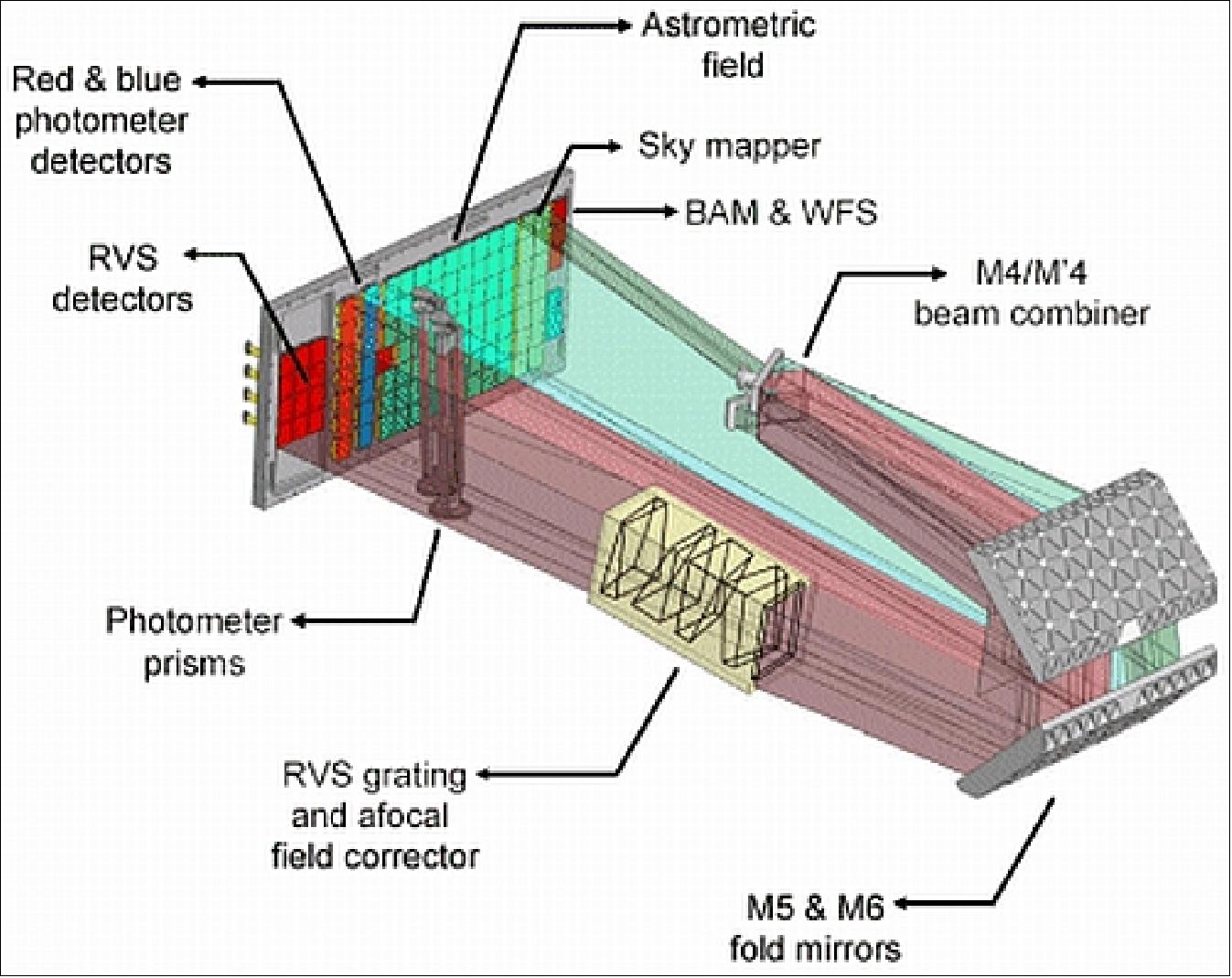
The spectral dispersion of objects in the field of view is achieved by means of an optical module physically located between the last telescope mirror (M6) and the focal plane. This module contains a grating plate and four dioptric, prismatic, spherical, fused-silica lenses which correct the main aberrations of the off-axis field of the telescope. The RVS module has unit magnification, which means that the effective focal length of the RVS equals 35 m.
Spectral dispersion is oriented in the along-scan direction. A dedicated passband filter restricts the throughput of the RVS to the desired wavelength range.
The RVS-part of the Gaia FPA (Focal Plane Assembly) contains 3 CCD strips and 4 CCD rows. Each source will typically be observed during ~40 FOV transits throughout the 5-year mission. On the sky, the RVS CCD rows are aligned with the astrometric and photometric CCD rows; the resulting semi-simultaneity of the astrometric, photometric, and spectroscopic transit data will be advantageous for variability analyses, scientific alerts, spectroscopic binaries, etc. All RVS CCDs are operated in TDI (Time Delay Integration) mode.
The RVS spectra will be binned on-chip in the across-scan direction. All single-CCD spectra are foreseen to be transmitted to the ground without any further on-board (pre-)processing. For bright stars, single-pixel-resolution windows are foreseen to be used, possibly in combination with TDI gates. It is currently foreseen that the RVS will be able to reach object densities on the sky of up to 40,000 objects/ degree2.
On-ground Data Processing: Radial velocities will be obtained by cross-correlating observed spectra with either a template or a mask. An initial estimate of the source atmospheric parameters derived from the astrometric and photometric data will be used to select the most appropriate template or mask. Iterative improvements of this procedure are foreseen. For stars brighter than ~15th magnitude, it will be possible to derive radial velocities from spectra obtained during a single field-of-view transit. For fainter stars, down to ~17th magnitude, accurate summation of the ~40 transit spectra collected during the mission will allow the determination of mean radial velocities.
Atmospheric parameters will be extracted from observed spectra by comparison of the latter to a library of reference-star spectra using, for example, minimum-distance methods, principal-component analyses, or neural-network approaches. The determination of the source parameters will also rely on the information collected by the other two instruments: astrometric data will constrain surface gravities, while photometric observations will provide information on many astrophysical parameters.
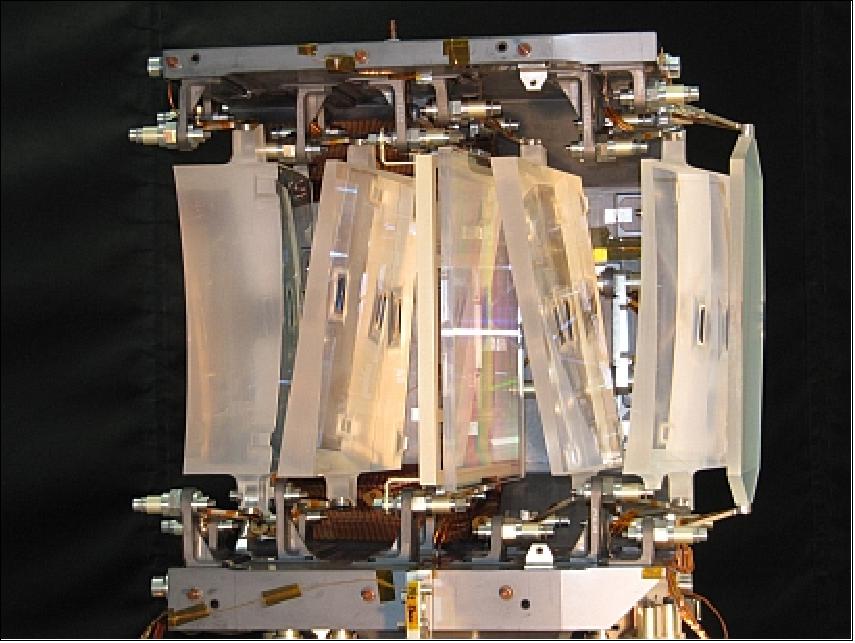
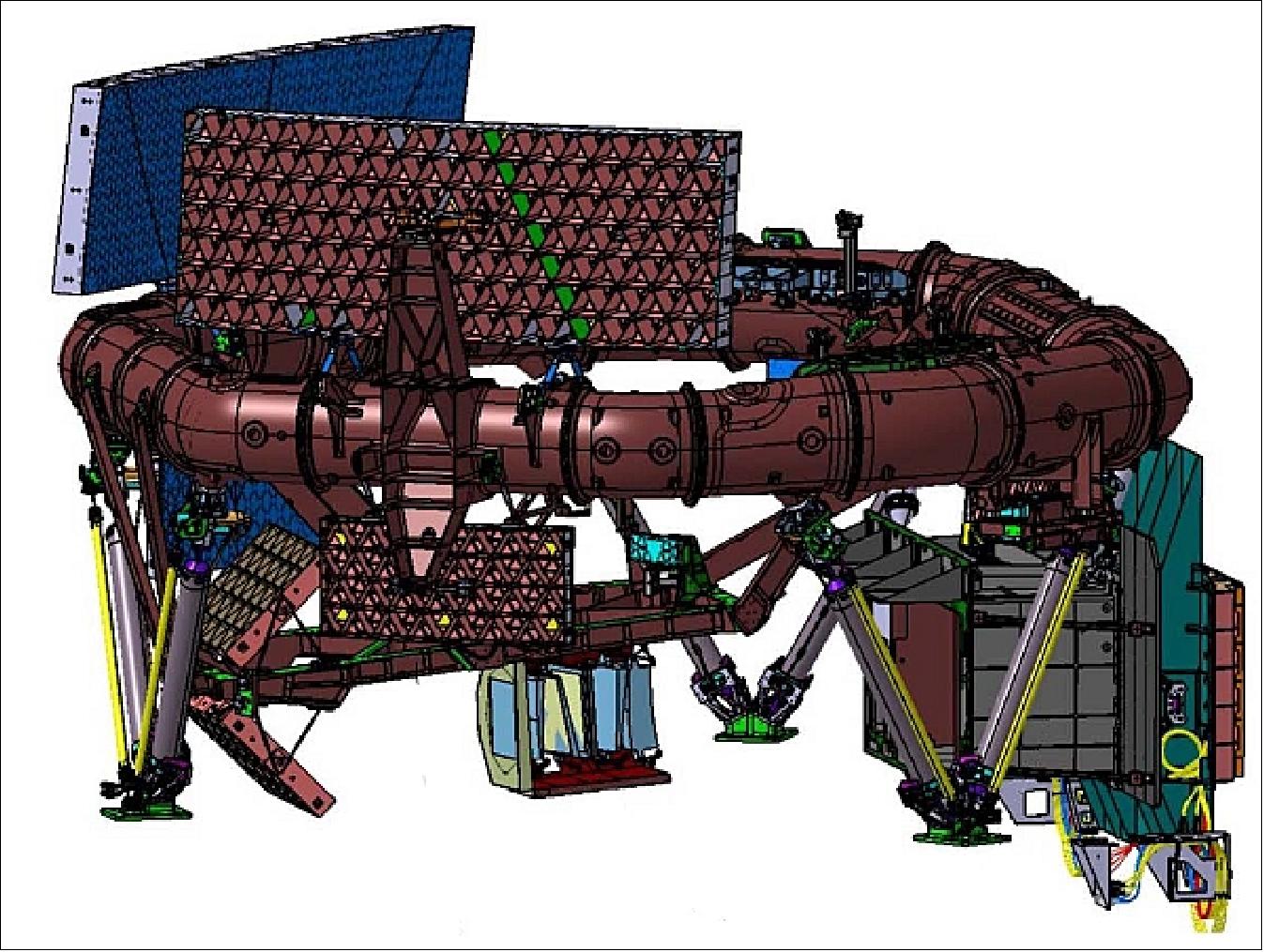
As the spacecraft slowly rotates, the light from the celestial object (that is, the image of the object) passes across the focal plane. In this way, Gaia steadily scans the whole sky as the satellite spins and gradually precesses, with each part being observed around 70 times in the course of the operational lifetime.
FPA (Focal Plane Assembly) 88) 89)
The Gaia focal-plane assembly is the largest ever developed for a space application, with 106 CCDs, a total of 937 Mpixels (almost 1 Gpixel) , which are around 90% light efficient (c.f. 20% typical terrestrial camera efficiency). The FPA has a physical dimension of 1.0 m x 0.4 m (Figure 61). The focal-plane assembly is common to both telescopes and serves five main functions:
1) The WFS (Wave-Front Sensor) and basic-angle monitor, covering 2+2 CCDs: a five-degrees-of-freedom mechanism is implemented behind the M2/M2' secondary mirrors of the two telescopes for re-aligning the telescopes in orbit to cancel errors due to mirror micro-settings and gravity release. These devices are activated following the output of two Shack–Hartmann-type wave-front sensors at different positions in the focal plane. The BAM (Basic Angle Monitor) system (2 CCDs in cold redundancy) consists of a Youngs-type interferometer continuously measuring fluctuations in the basic angle between the two telescopes with a resolution of 0.5 µarcsec per 15 minutes.
2) The SM (Sky Mapper), containing 14 CCDs (seven per telescope), which autonomously detects objects down to 20th magnitude entering the fields of view and communicates details of the star transits to the subsequent CCDs.
3) The main AF (Astrometric Field), covering 62 CCDs, devoted to angular-position measurements, providing the five astrometric parameters: star position (two angles), proper motion (two time derivatives of position), and parallax (distance) of all objects down to 20th magnitude. The first strip of seven detectors (AF1) also serves the purpose of object confirmation.
4) The blue and red photometers (BP and RP), providing low-resolution, spectro-photometric measurements for each object down to 20th magnitude over the wavelength ranges 330–680 nm and 640–1050 nm, respectively. The data serves general astrophysics and enables the on-ground calibration of telescope-induced chromatic image shifts in the astrometry. The photometers contain seven CCDs each.
5) The RVS (Radial Velocity Spectrometer), covering 12 CCDs in a 3 x 4 arrangement, collecting high-resolution spectra of all objects brighter than 17th magnitude, allowing derivation of radial velocities and stellar atmospheric parameters.
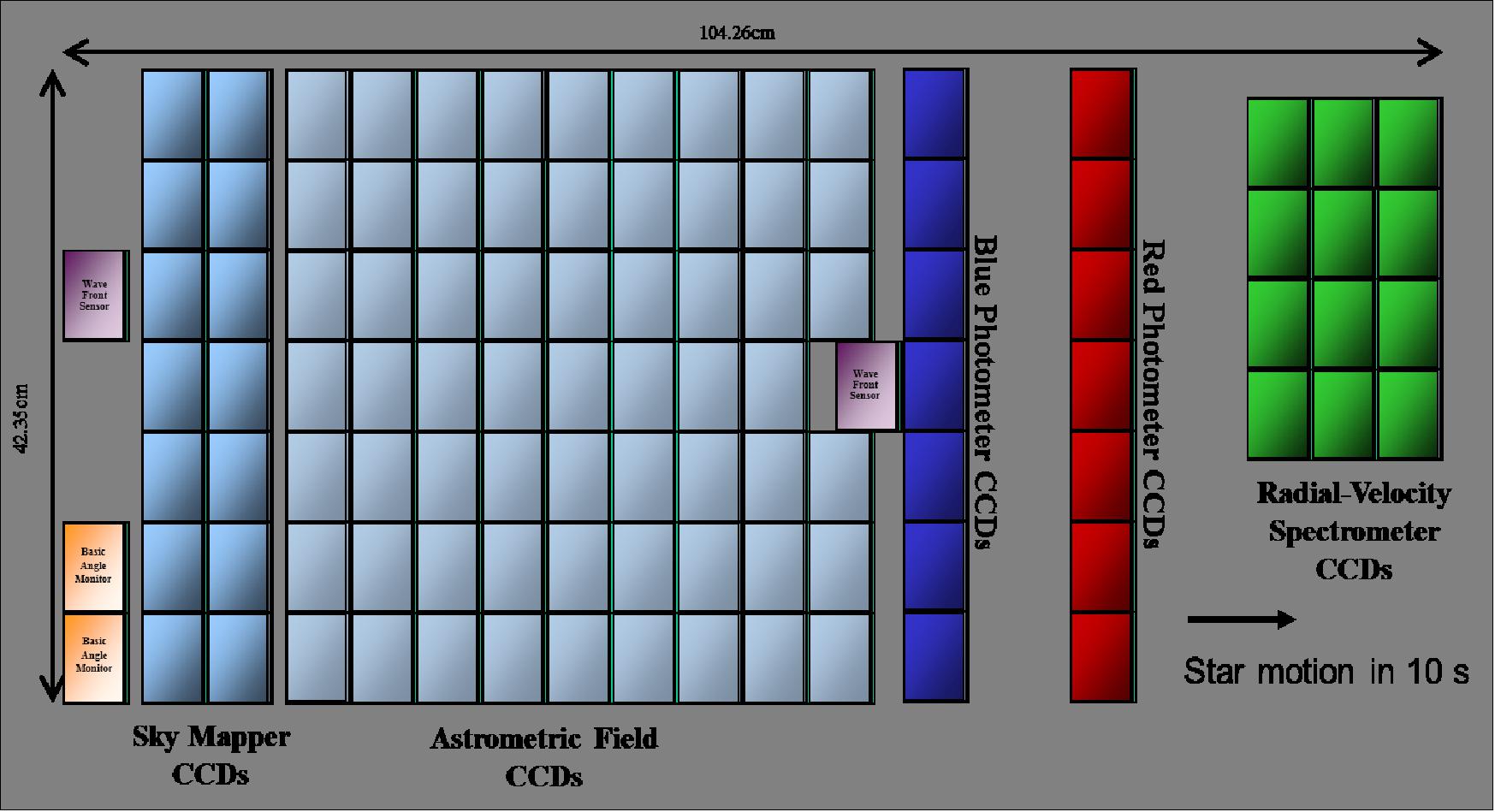
Function | No of CCDs | Details |
Metrology and alignment | 4 | 2 WFS (Wave Front Sensors), |
Star detection | 14 | 2 x 7 SM (Sky Mapper) CCDs, 7 per telescope |
Astrometry, AF (Astrometric Field) | 62 | 8 x 7, 1 x 6 |
Photometry (BP, RP) | 14 | 7 blue and 7 red |
Spectrometry (RVS) | 12 | 3 x 4 |
Observation Sequence in the Focal Plane: All CCDs, except those in the SM (Sky Mapper), are operated in windowing mode: only those parts of the CCD data stream, which contain objects of interest, are read out; remaining pixel data is flushed at high speed. The use of windowing mode reduces the readout noise to a handful of electrons while still allowing reading up to 20 objects simultaneously.
- Every object, crossing the focal plane, is first detected either by SM1 or SM2. These CCDs record, respectively, the objects only from telescope 1 or from telescope 2. This is achieved by a physical mask that is placed in each telescope's intermediate image, at M4/M41 beam-combiner level.
- Next,a surrounding window is allocated to the object, which is propagated through the following CCDs of the CCD row as the imaged object crosses the focal plane; the actual propagation uses input from the spacecraft's attitude control system, which provides the predicted position of each object in the focal plane versus time. After detection in SM, each object is confirmed by the CCD detectors in the first strip of the AF1 (Astrometric Field); this step eliminates false detections such as cosmic rays.
- The object then progressively crosses the eight next CCD strips in AF, followed by the BP, RP, and RVS detectors (the latter ones are present only for four of the seven CCD rows).
- The nominal integration time per CCD is 4.42 seconds, corresponding to 4500 pixels along scan. For bright saturating objects, the integration time in AF1-AF9, BP and RP is reduced by activating electronic TDI gates in the detector over a short period corresponding to the bright star window. The purpose of the TDI gates is to lower the effective number of pixels along scan. Twelve gates are available in the detector and allow optimising the signal collection for bright stars at the minimum expense for faint stars.
CCD characteristics: All CCDs have the same format and are derived from e2V Technologies (UK) design and are large-area, back-illuminated, full-frame devices. They are operated in TDI (Time Delay Integration) mode with a TDI period of 982.8 µs. The focal plane is passively cooled to 170 K for reducing its sensitivity to radiation. The box shaped CCD radiator provides the radiative surface with the colder internal payload cavity (120 K) as well as CCD shielding against radiation and support for the photometer prisms.
The Gaia CCDs are fabricated in three variants, AF-, BP-, and RP-type, to optimise quantum efficiency corresponding to the different wavelength ranges of the scientific functions. The AF-type variant is built on standard silicon with broadband anti-reflection coating. It is the most abundant type in the focal plane, used for all but the photometric and spectroscopic functions. The BP-type only differs from the AF-type through the blue-enhanced backside treatment and anti-reflection coating, and it is exclusively used in BP. The RP-type is built on high-resistivity silicon with red-optimised anti-reflection coating to improve near-infrared response. It is used in RP as well as in RVS.
Pixel size along scan | 10 µm |
Pixel size across scan | 30 µm |
No of pixels along scan | 4500 |
No of pixels across scan | 1966 |
Total number of pixels/CCD | 8.847 Mpixels |
Total number of pixels in FPA with 106 CCDs | 937 Mpixels (or ~ 1 Gpixel), covering an area of about 0.38 m2 |
Operational temperature | -115ºC |
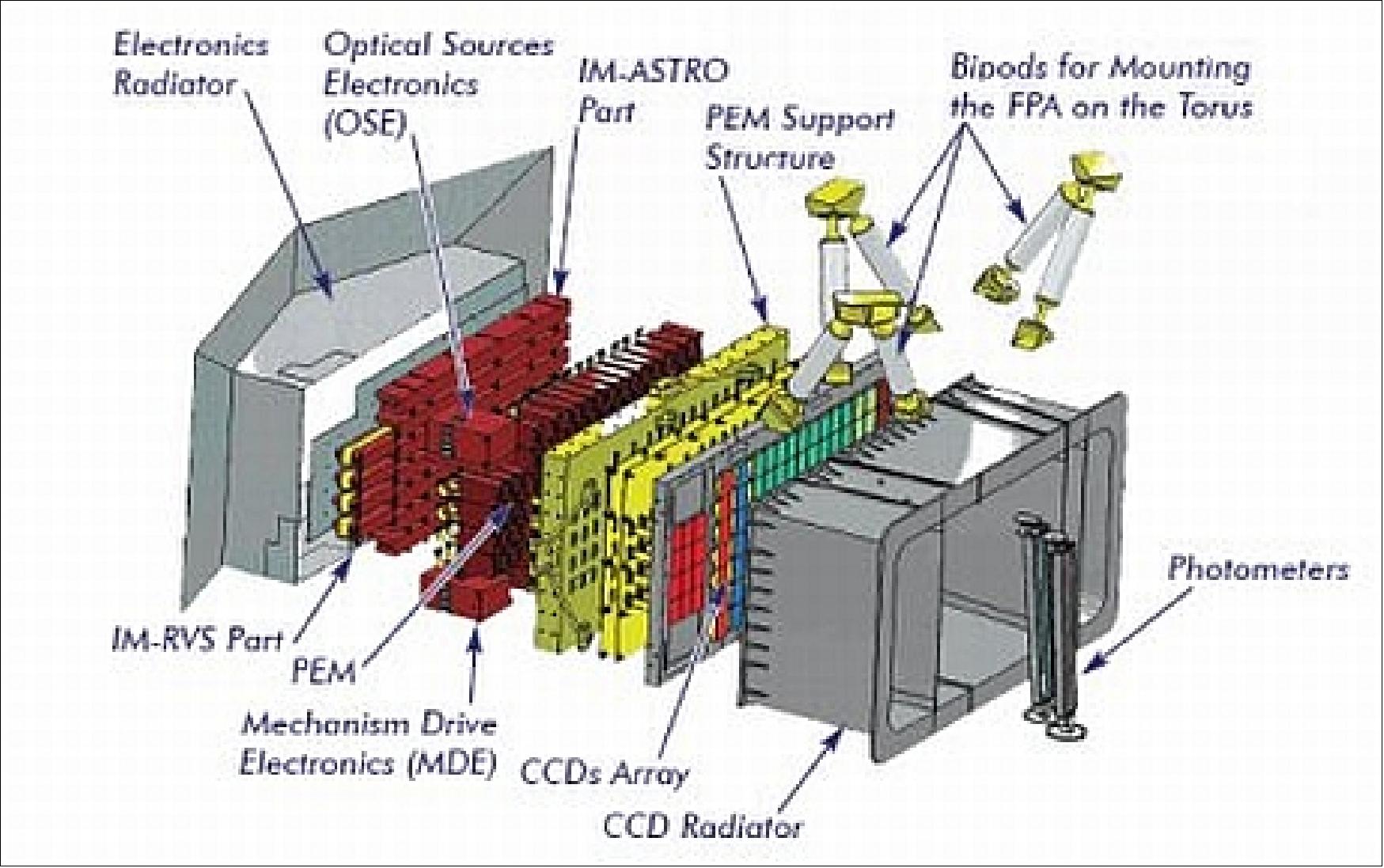
Payload module data handling 90)
Time reference: The star localisation measurement is performed by transit detection and time measurement, which calls for a very accurate datation of object transits. For this purpose, a CDU (Clock Distribution Unit) provides all necessary timing signals and clock functions for video sample time tagging and ground based time scale correlation. All signals are generated on the basis of the highly stable central master 10 MHz Rubidium atomic clock.
Time correlation: In addition to the classical corrected one-way path technique, it is proposed that on-board-to-UTC time correlation be performed by a specific two way process. This technique allows to cancel symmetrical delays of ionospheric or tropospheric origin, or delays of relativistic origin. This correlation performance is furthermore independent of the orbit.
On-board Payload Processing: The PDHS (Payload Data Handling System) is implemented as a set of 7 VPUs (Video Processing Units), one for each detector row of the focal plane, feeding a common 960 GB solid state mass memory at PDHU. The processing part of the PDHS has a modular architecture which follows the FPA architecture and eases the accommodation. In the case of failure of one channel, this would have little impact on the science performance. The file-organised mass memory is a standard stand-alone unit.
Although Gaia has the biggest camera that has ever flown in space, Gaia does not actually take pictures in the conventional sense. Instead, it rather tracks the stars across its sensors as the telescopes rotate and the field of view moves across the star-filled sky. In order to do so, a constant readout of the onboard CCDs is done, and this takes a lot of computing power. For this, the seven high performance VPUs (Video Processing Units) are used which interface with the 'camera'. A VPU incorporates a dedicated Astrium-developed pre-processing board, and for the bulk of the processing, a SCS750 PowerPC board from Maxwell Technologies, Inc., of San Diego, USA. Each of the VPUs exhibits a processing power of more than 1000 MIPS (>1 GIPS). A VPU has a mass of 3.2 kg and a size of 195 x 120 x 253 mm. 91) 92) 93)
On-board data processing algorithms allow computations to be made in real time, without data buffering. The hardware-software share offers full flexibility and algorithms may be modified in-flight following first in-orbit results.
A precise centroiding of bright stars is made with the measurements performed in the first 2 columns of detectors in order to determine the star velocities for monitoring the spacecraft attitude control.

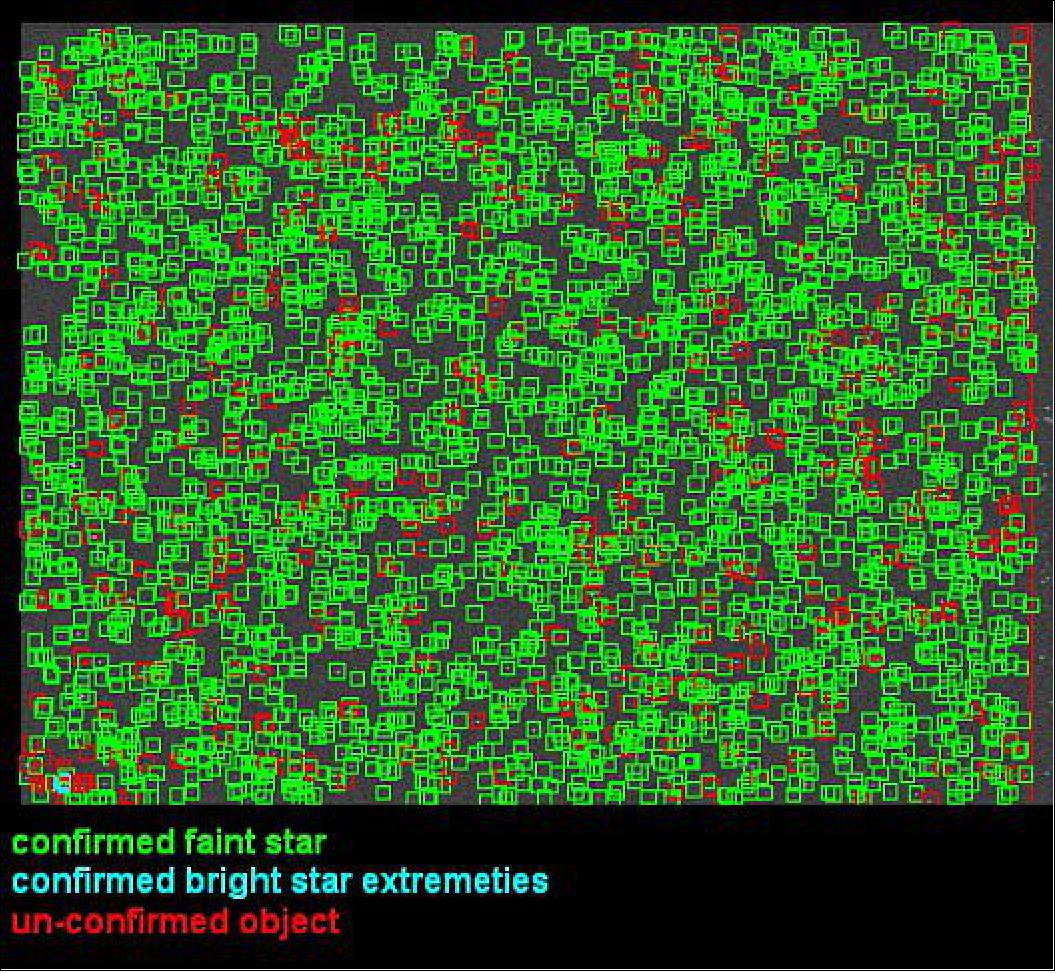
Metrology and alignment: Gaia embarks two specific devices, for recovery of the optical quality after launch and for continuous monitoring of the angle between the two telescope lines of sight. All these devices are operated at 130 K.
1) A five-degree-of-freedom static mechanism is implemented behind the secondary mirrors of the two telescopes , based on the TMA (Three Mirror Anastigmat) design, for securing the optical performance in orbit and cancelling static residual errors due to mirror micro-settings and gravity release. The BAM (Basic Angle Monitoring) system consists of a Fizeau interferometer, measuring fluctuations in the basic angle between the two telescopes. The image quality is measured by two Shark-Hartmann Wave Front Sensors using two dedicated CCDs in the focal plane. The signal is coming from bright stars.
2) During science operations, a Fizeau laser interferometer measures the in orbit fluctuation of the basic angle between the two input telescopes with an accuracy better than 0.5 µas. The fringe motion with respect to the detector frame provides the line-of-sight of the telescopes along scan, and therefore the basic angle variations.
Ground Segment
ESA's most powerful ground stations, the 35 m deep-space stations in New Norcia, Australia (DSA 1), Cebreros, Spain (DSA 2), and Malargüe, Argentina (DSA 3), will be used to send commands to Gaia and receive the high volume of science data that must be returned to Earth to create Gaia's Galactic Map. During the critical LEOP phase, additional ground station support will be provided by ESA's 15 m diameter Kourou, Maspalomas and Perth stations. 94) 95)
Communications and Orbit Tracking
• The end-to-end timing of the measurements must be highly precise. To this end, Gaia carries an atomic clock to time stamp the science data, which has to be matched by ultra-precise time stamping on ground at data reception. In fact, the CCSDS ground time-stamping standard that the space community uses was extended to a picosecond (10-12 s) resolution to meet the Gaia requirements, and this capability was added to ESA's Estrack Deep Space Antennas.
• The orbit of Gaia must also be determined to very high accuracy (to within 150 m at 1.5 million km). The traditional radiometric methods are supplemented by optical observations from ground-based telescopes, which take pictures of Gaia against the background stars, and ΔDOR (delta-Differential One-way Ranging) measurements in the commissioning phase (a method where multiple DSA stations are used to precisely determine the spacecraft position with respect to a Quasar).
• GBOT (Ground Based Orbit Tracking) campaign: GBOT utilises a network of small-to-medium telescopes aiming to track the Gaia observatory. GBOT is committed to deliver one set of data per day, which allows the determination of Gaia's position good to 20 m arcsec. The GBOT data on Gaia will be included in the orbit reconstruction performed at ESOC in order to increase the accuracy of this undertaking to a level of 150 m in position and 2.5 mm/s in motion. These tight constraints are needed, to ensure that Gaia's measurements of the stars and Solar System objects are as accurate as possible. 96)
Astronomers within the DPAC community – first set up the GBOT project in early 2008 and trialled it on missions already in the same orbital location that Gaia will operate from – L2 – including NASA's WMAP and ESA's Planck satellites. This allowed the project to test their methods, and also get some clues about the probable magnitude that Gaia will have once in orbit. It is assumed that it will be around magnitude 18, but that it is still a big unknown.
Since then, a whole infrastructure was set up, developing observing techniques, a dedicated software pipeline, a database, and observatories were recruited to deliver the GBOT project data. The backbone of the data will be supplied by the 2 m Liverpool telescope, located on La Palma, Canary Islands, Spain, and the Las Cumbres Optical Global Telescope Network (LCOGT.net), which operates 1 m telescopes in Chile, South Africa, Australia and Texas. The project will also have some support from ESO's VST (2.6 m telescope at Paranal, Chile) and additional facilities will also provide data when needed.
In 2012, the project started a new fork of GBOT, radio-GBOT, which involves VLBI observations of Gaia. These are much more precise than the optical observations, but because they use more resources, the project will use this technique less often and therefore the radio data will be used only to complement the optical measurements.
The coordination of the GBOT activities is done from Heidelberg. The data reduction, analysis and storage, will be done at the Observatoire de Paris (with a mirror of the database in Heidelberg). The pipeline software, which has been developed by the GBOT group in Paris, imports and harmonises the data obtained from the partner observatories, processes the data and finally outputs the position of Gaia. The data is then delivered to ESA's MOC (Mission Operations Center) in Darmstadt via the SOC (Science Operations Center) in Villafranca near Madrid. Likewise, the reconstructed orbit files from ESOC are retrieved by GBOT, converted into data on Gaia's position, with finder charts, and then supplied to the partner observatories.
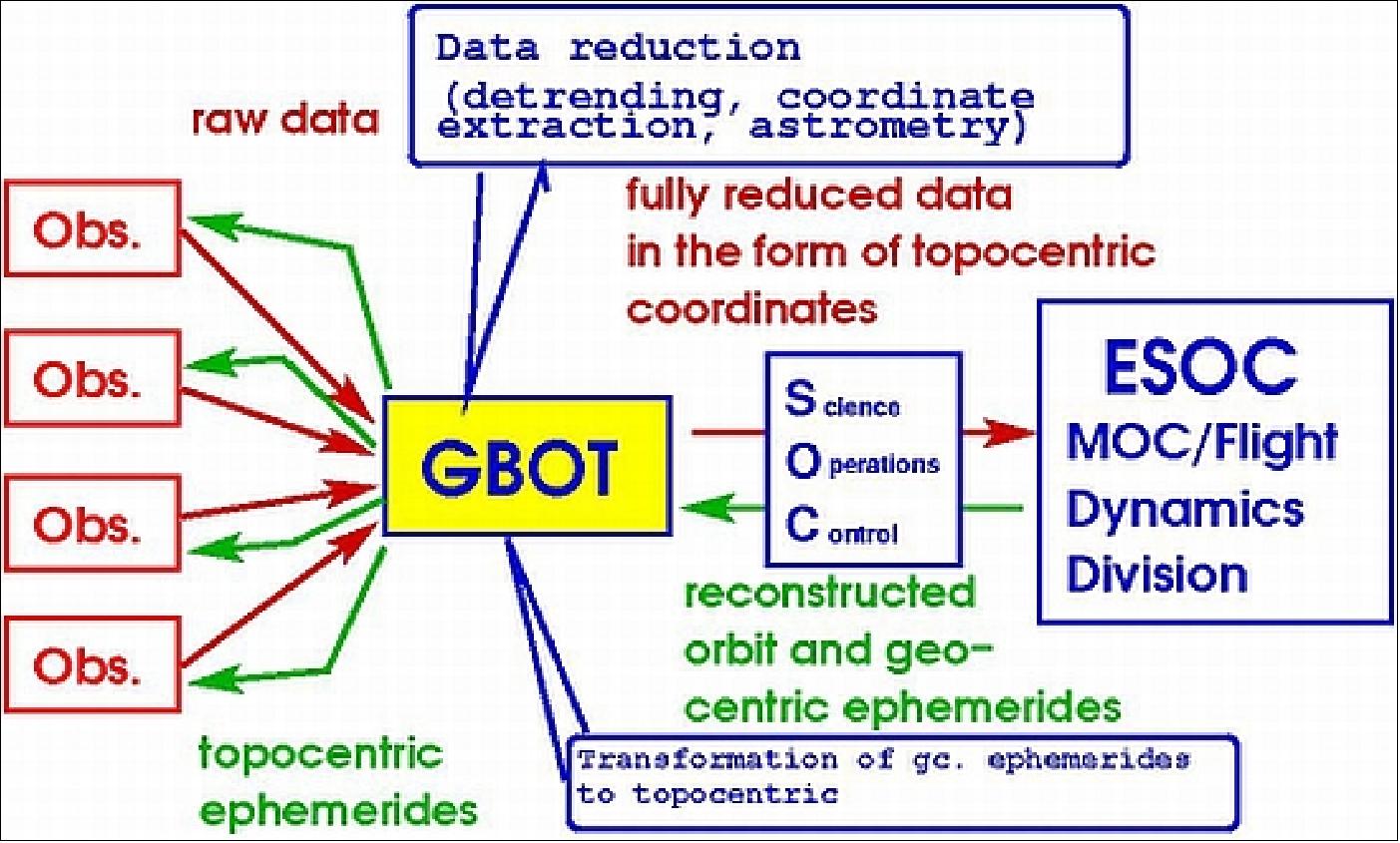
Now, shortly before the launch of Gaia, GBOT is ready for action. GBOT's observations commence about 10 days after launch; any earlier and Gaia is too bright for the instruments of the partner institutes. The project hopes to obtain motion clips of the spacecraft moving in front of star fields as the satellite journeys towards L2. It will be a challenging task for the small team, but we will do our very best to deliver!
MSC (Mission Control System)
Mission operations will be conducted by the Flight Control Team at ESOC (European Space Operations Center) in Darmstadt Germany, comprising spacecraft operations (mission planning, spacecraft monitoring and control, and all orbit and attitude determination and control) as well as scientific instrument operations (quality control and collection of the science telemetry). The ground segment at ESOC will comprise all facilities, hardware, software and documentation required to conduct mission operations.
The ground operations facilities consist of:
• Ground stations and the communications network
• Mission control center
• FCS (Flight Control System)
• Software-based spacecraft simulator
All mission and flight control facilities, except the ground stations, are located at ESOC, including the interfaces for the provision of science telemetry to the SOC (Science Operations Center) at ESA/ESAC (European Space Astronomy Center), ESA facility in Villafranca, Spain, located about 30 km west of Madrid. 97)
The science data will be distributed to ESAC after being stored in dedicated Science Data Servers at ESOC, via high-speed communication lines.
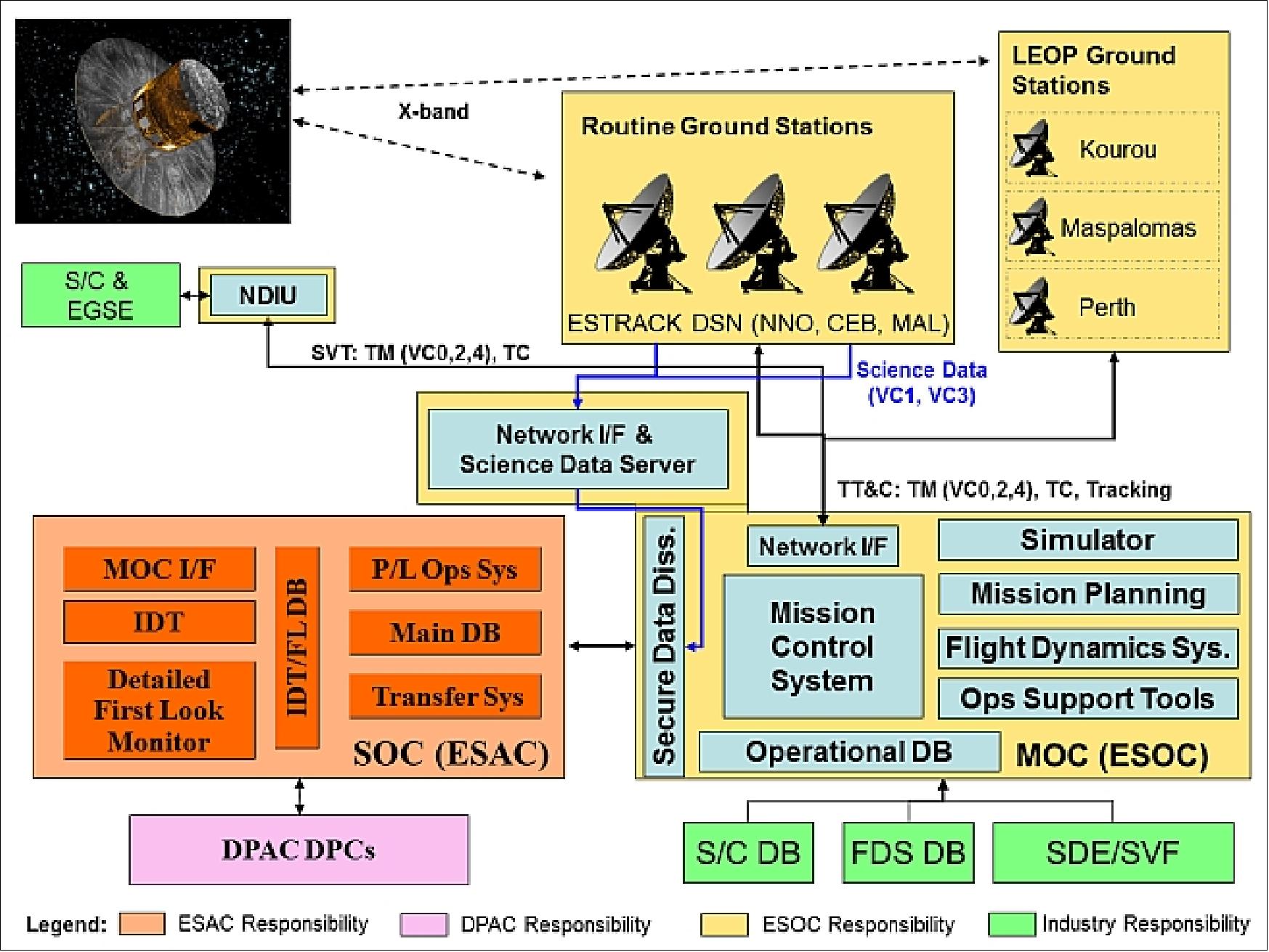
The science data processing requirements for Gaia are among the most challenging of any scientific endeavor to date. Due to the immense volume of data that will be collected, for 1 billion stars, it will be a major challenge, even by the standards of computational power in the next decade, to process, manage and extract the scientific results necessary to build a 3-dimensional view of our Galaxy, the Milky Way.
A total of some 100 TB of science data will be collected during Gaia's lifetime. The estimated total data archive will surpass 1 PB (Petabyte or 1015 bytes), roughly equivalent to 1000 1 TB hard drives from a top-end home PC.
DPAC (Data Processing & Analysis Consortium)
Unlike a mission such as the Hubble Space Telescope, Gaia does not produce data that is immediately scientifically useful. The raw telemetry must first be processed before the sought after distances can be obtained, motions, and properties of the stars observed by Gaia. This immense task will be undertaken by a pan-European collaboration, the Gaia DPAC (Data Processing and Analysis Consortium). DPAC is responsible for the processing of Gaia‘s data with the final objective of producing the Gaia Catalogue. Drawing its membership from over 20 countries (Figure 68), the consortium brings together skills and expertise from across the continent, reflecting the international nature and cooperative spirit of ESA itself.
The DPAC consists of about 450 persons, spread over academic institutes and space agencies throughout Europe and beyond, who are actively contributing to writing the millions of lines of code needed for the data processing and to subsequently operate the software systems and validate the resulting output. Each DPAC is responsible for a different aspect of the Gaia data processing. 98) 99) 100) 101)
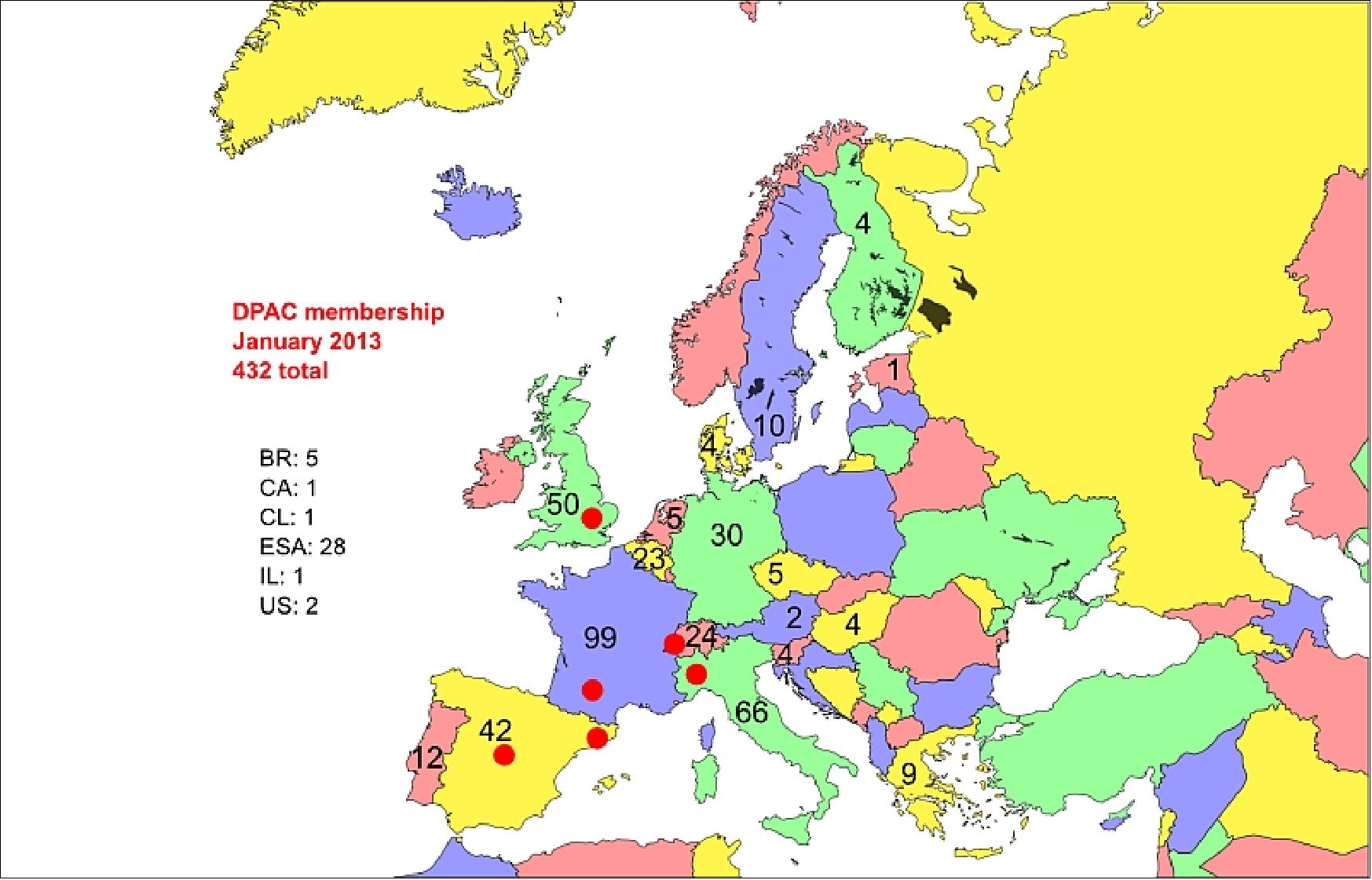
Legend to Figure 68: Next to the European country DPACs, there are also members in Brazil, Canada, Chile, Israel, and the USA.
To organise the large amount of tasks to be carried out, the DPAC has been subdivided into nine specialist units known as CUs (Coordination Units). Each CU takes the responsibility for the development of a specific part of the Gaia data processing: system architecture, simulations, astrometry, photometry, spectroscopy, object processing, variability processing, astrophysical parameters, and catalog publication. The CUs draw their membership from multiple countries.
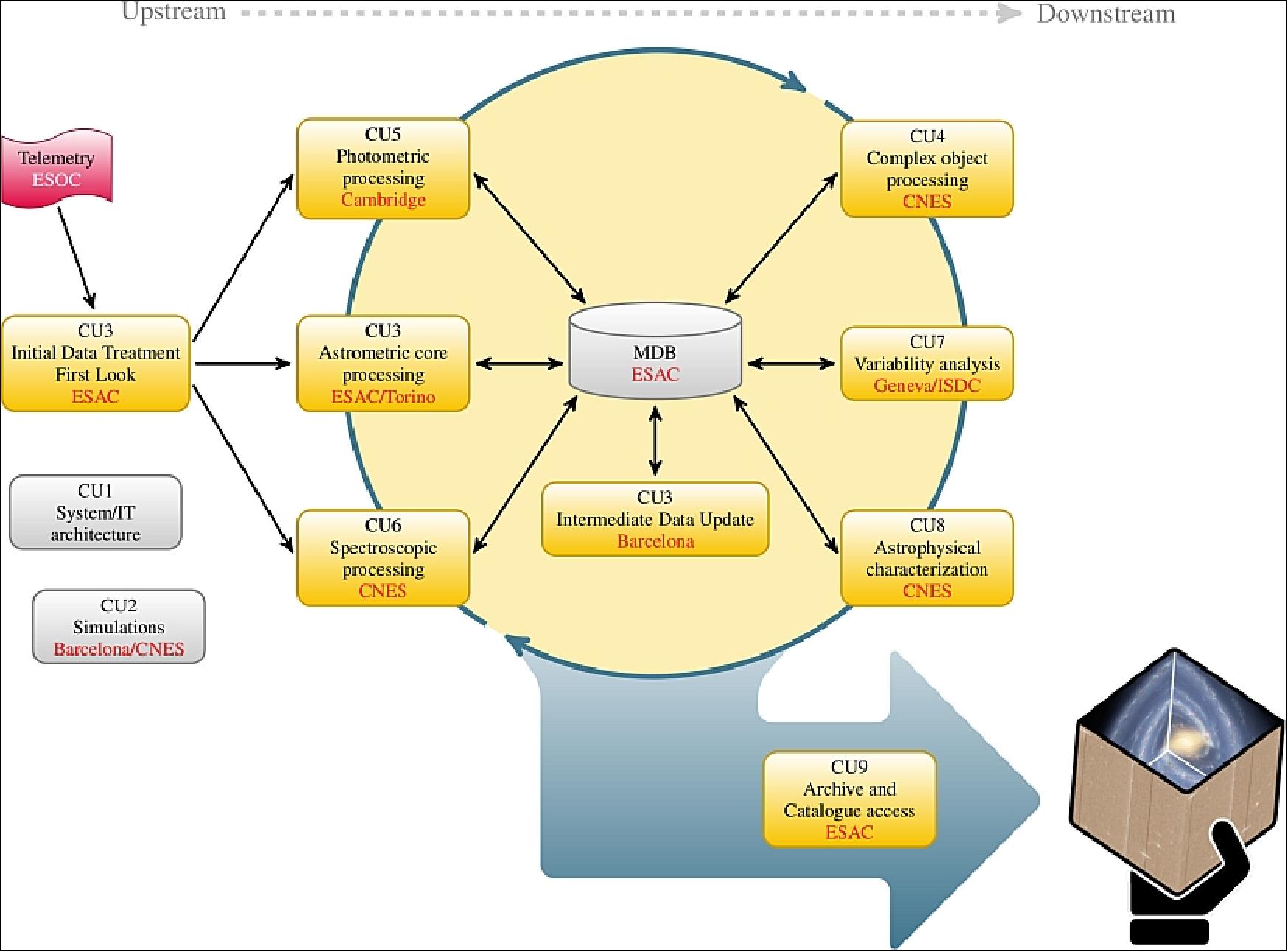
The astronomers in the CUs conceive the scientific algorithms for the data processing and also carry out a large fraction of the software development. The software is then run at one of the six DPCs (Data Processing Centers). The personnel at the data processing centers also provide the much needed software engineering expertise. Such a large software system cannot be developed and operated by astronomers alone!
The schematic of Figure 69 shows how each CU is supported by a specific DPC (indicated in red). The data exchange within DPAC will take place through the so-called MBD (Main Data Base), housed at ESAC. After the completion of a processing cycle, data is then extracted from the MDB and prepared for release.
Note that the Gaia project is unique in that the scientific data produced by DPAC are not subject to a proprietary period. On completion of a processing cycle the results are immediately available to the scientific community and also to the general public. The nine CUs and six DPCs are coordinated by an executive committee, the DPACE (DPAC Executive) as shown in Figure 70. 102)
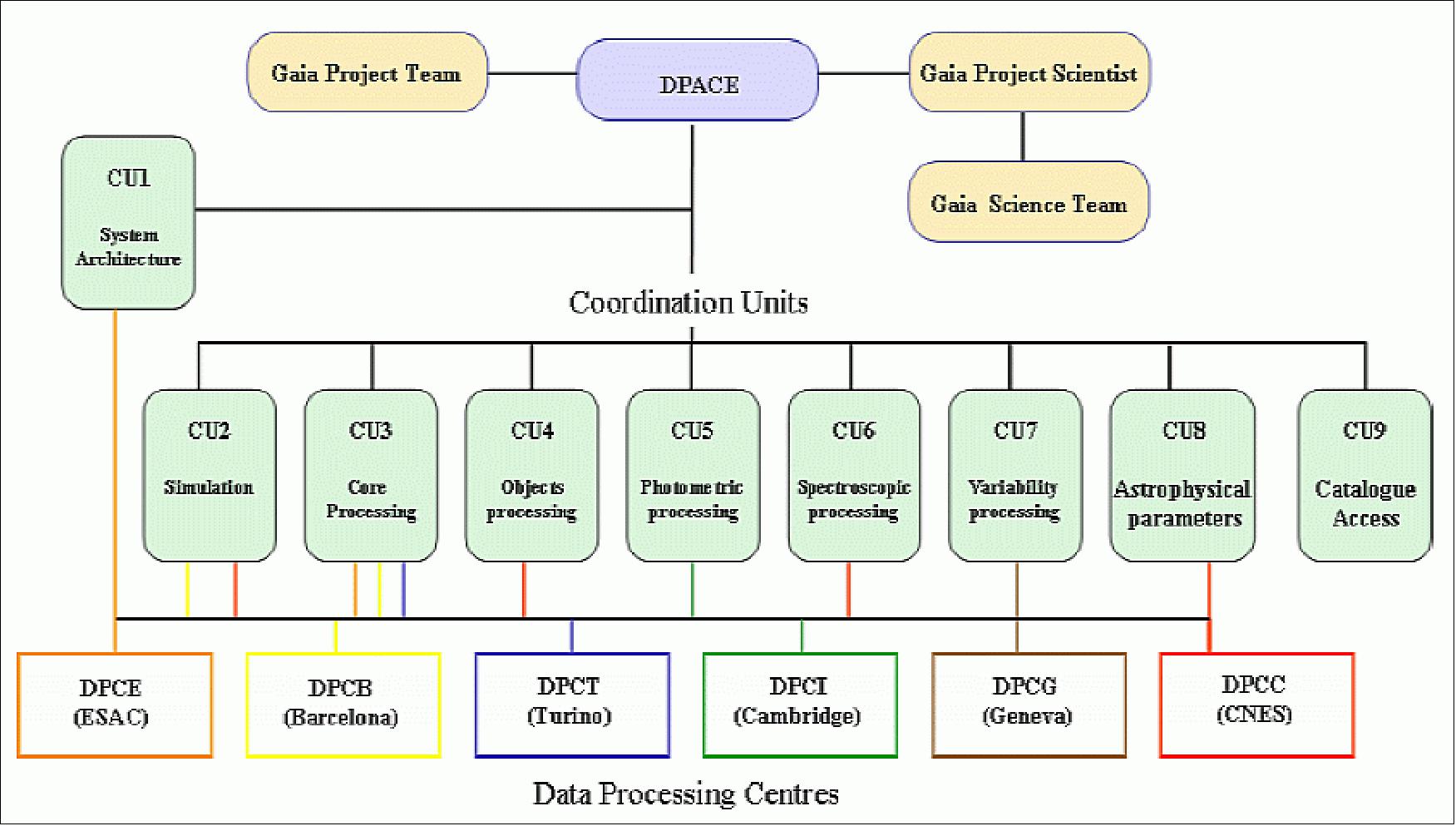
Gaia's VO (Virtual Observatory) Big Data Archive
ESA's Gaia mission will survey the sky for at least 5 years providing high accuracy astrometry, radial velocities and multi-colour photometry. The DPAC (Data Analysis and Processing Consortium) efforts will result in an astronomical catalog with unprecedented accuracy and completeness of at least 1 billion (109) sources, and over 1PB of associated data products. 103)
This brings big data challenges in storing, querying and distributing all the associated data and meta data, comparing them with other astronomical catalogues, enabling analysis, visualisation, data mining and then sharing these results with other scientists. The amount of data involved forces a change of paradigm in dealing with astronomy archives. The usual usage of downloading the data to the users for her/him to work further on it needs towards evolve to a new way of working where the users' can send her/his code to the data, run it there on computing and storage services provided directly by the archive, where the data reside. The Gaia archive will provide an infrastructure to run added value interfaces and software on top of the Gaia data.
Nominal mission data up to January 2016 — with associated products up to 1 PB pf Gaia data by mission end | ||
Type of data | Amount (Byte) | Description |
Science telemetry | 28 TB |
|
Astronomy transits | 35.2 x 109 | 352.3 x 109 measurements |
Photometry transits | 35.2 x 109 | 73.6 x 109 low resolution spectra |
Spectroscopy transits | 2.3 x 109 | 6.9 x 109 high resolution spectra |
Main database | 90 TB | 700 TB expected after 5 years |
The first Gaia catalog will be publicly released to the scientific community around summer 2016, but the development of the Gaia archive has long started and an internal version is already available for the Gaia Consortium.
The term Big Data can be used and understood differently by people, but today industry widely refers to the five "Vs" (Volume, Velocity, Variety, Veracity and Value) when speaking about Big Data. From the Volume perspective, with "only" 1 PB of data produced by the end of its lifetime, Gaia could hardly be considered as a big data mission, as many other astronomy projects (in particular ground based telescope) will produce way more data volume in a shorter timescale.
The final delivery will also include all the single epoch CCD transit data that was used in the catalog computation, reaching an estimate of around 1PB at the end of the mission in 2022 (Table 5).
Nonetheless, the billions of CCD transits, measurements and spectra (Table 5) that will result into massive sources catalogs (Figure 71) for sure makes Gaia a big data challenge, from the data Velocity and Variety points of view.
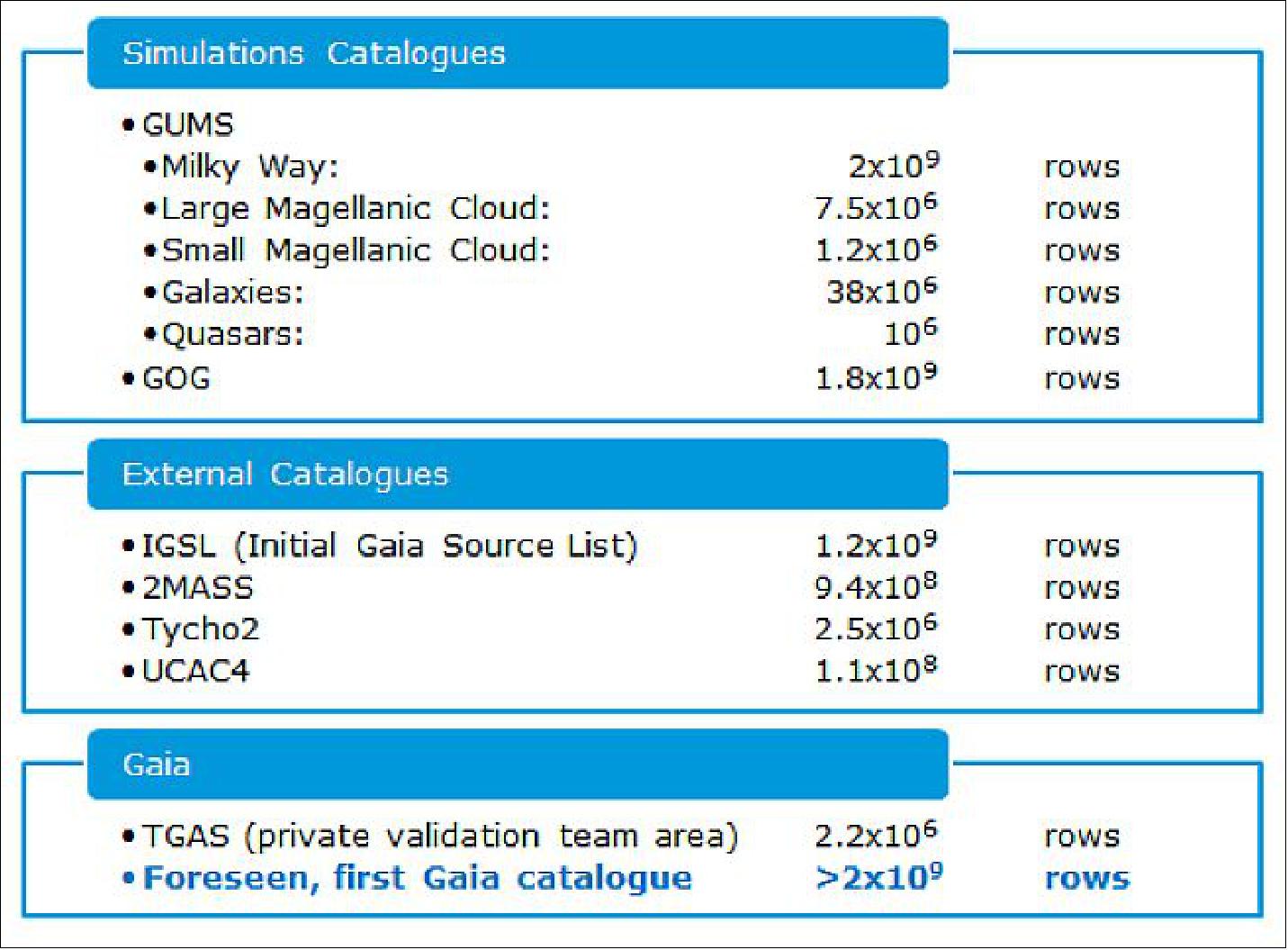
Ensuring the Veracity of the Gaia data represents one of the main big data challenge of the Gaia data processing. And to finish, by performing astrometry, photometry and spectroscopy of about one billion objects in our Milky Way galaxy and beyond, the extent and content of the Gaia Catalogs will enable major progress to be made in many fields of galactic and stellar astronomy, hence its Value definitely places Gaia as a major Big Data project in astronomy.
Standard Archive Architecture
Standard ESA space science archive architecture (Figure 3) is based on the OAIS (Open Archival Information System) architecture. Users and scientists are used to interact with data or catalogues, either through a browser user interface or scriptable command line interface. They download the data and the full catalogue, usually via FTP, to their local disk and perform their science analysis on their local computer.
This working model works fine for small amount of data, but becomes difficult as data volume grows. To reduce the data transfer burden, the users try to select region of the sky and download only part of the catalogue, and then combine it with their own datasets or catalogues already stored on their disk. This can be described as "move the data to the computing facility".
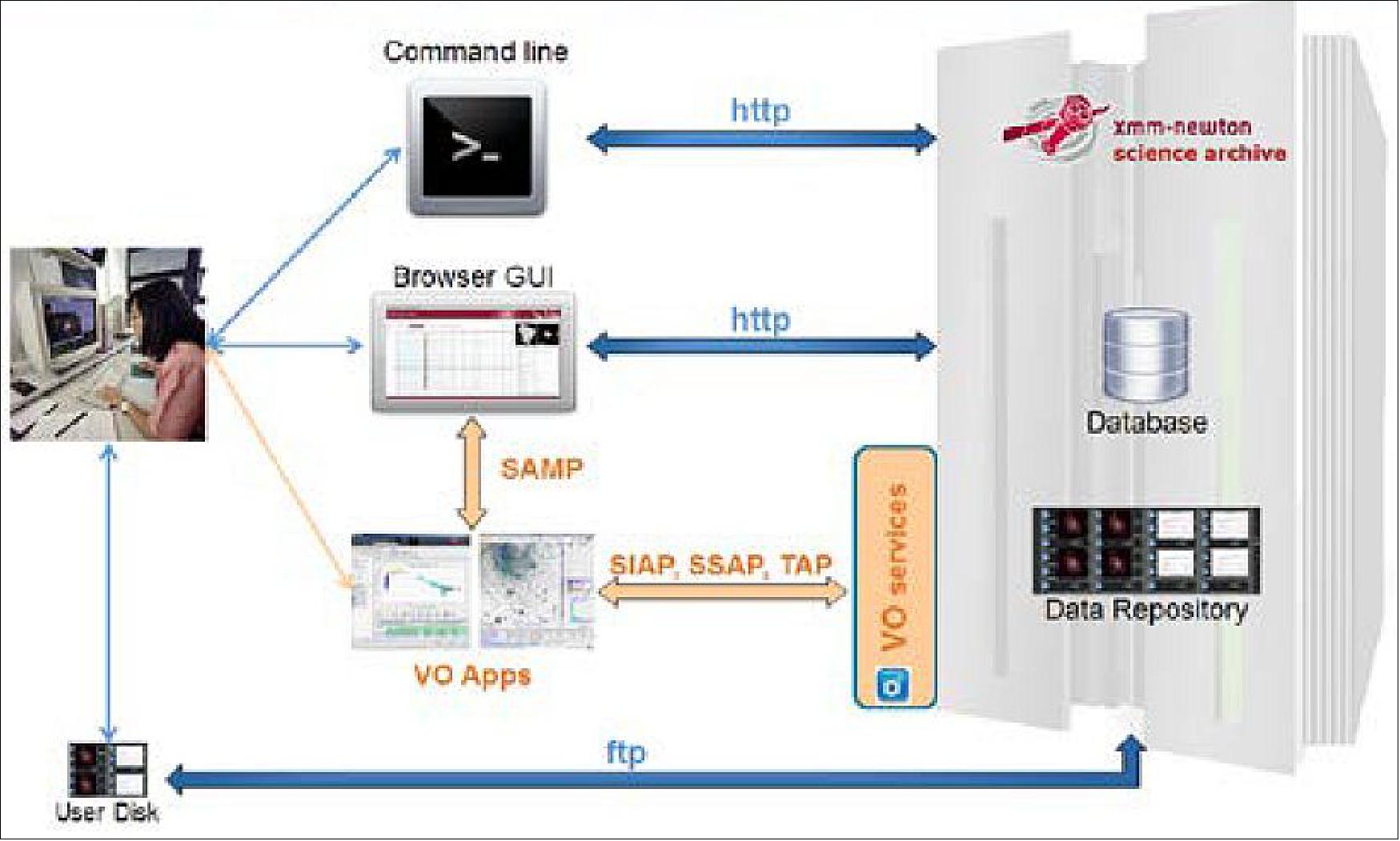
The VO (Virtual Observatory) provides an unified framework which enables transparent access to astronomical science data holdings coming from various different archives. The very same command can be sent to archives located in different locations (and using their own internal storage and database systems) and present results in a consistent way to the end user or applications. Early developed interoperability VO protocols (e.g., ConeSearch, Simple Image and Simple Spectra Access) greatly facilitates access to multiple datasets, but still assumes that data are finally being downloaded to the user's computer.
Usually, science archives implements a "VO layer" on top of the existing archive infrastructure, so all the data holdings can be accessible through these VO protocols. This ensures the interoperability of the archives with other VO compliant archives and applications.
New Archive Paradigm for Gaia
With the avalanche of data in astronomy, the archive model previously described reaches its limit and a new paradigm needs to be established, the so called "move the code to the data". For Gaia, the amount of data and meta data is so big that special computing infrastructure is required to efficiently handle Gaia data. For example, a query of a cone search on the ~1 billion Gaia catalog might return 10 million sources. Another typical use case is to upload a table with sources and to cross match these with the Gaia catalog. This operation is made possible with the VO TAP (Table Access Protocol), coupled with ADQL (Astronomical Data Query Language, SQL with specialised astronomical searches). TAP also supports asynchronous query, as such a cross match can require too much time to be perform interactively. UWS (Universal Worker Service) enters in action to manage these asynchronous jobs. This back-end infrastructure serves all the front-end interfaces available at the Gaia archive.
Special emphasis has been put on the database design (based on PostgreSQL and pgSphere add-on which provides spherical data types, functions, and operators for PostgreSQL) and associated indexing. Furthermore, the Gaia archive is hosted on a powerful server and the most popular catalogs are stored on PCIe SSDs disks to ensure good performance of these crossmatch functions. Some examples of time required for some of the complex crossmatches are given in Table 6.
Note: PCIe (Peripheral Component Interconnect Express); SSD (Solid State Drive).
Catalog 1 | Catalog 2 | Radius (arcsec) | # results | Time |
Tycho2 | 2 MASS PSC | 1" | 2,495,304 | 49 s |
Tycho2 | 2 MASS PSC | 5" | 2,614,163 | 116 s |
Tycho2 | IGSL | 1" | 2,600,542 | 46 s |
Tycho2 | IGSL | 5" | 2,829,401 | 55 s |
Legend to Table 6: Tycho2 vs. IGSL (Initial Gaia Source List) crossmatches are even faster than the ones with 2MASS as IGSL is located in the fastest local storage (PCIe), even when IGSL (similar to the final Gaia catalog) is around 3 times bigger than 2MASS.
End user can then interact with the Gaia through a standard GUI (Graphical User Interface) from any standard web browser. This offers a full ADQL query interface, with example to help the user familiarise with the Gaia catalog content and structure.
In addition, it is expected that many of the users will interface with Gaia data directly through scriptable interface. All operations available from the Gaia archive GUI (ie TAP/ADQL queries) can also be included directly in user's scripts. Various examples of such scripts are provided in the most commonly used programming language in astronomy (Python, C, Java).
VO applications (e.g., Topcat, VOSpec) can access directly the Gaia data through the corresponding VO protocol, TAP for table, Simple Access Protocol for spectra, without the need to develop a "VO layer" as seen in the standard ESA archive architecture.
When the user retrieves big volume of Gaia data, she/he would be able to download it to her/his local disk via FTP, but it will probably be more efficient to leave it on the archive disk itself to avoid the burden of the network transfer. This can be done with VOSpace, virtual disk accessible by VO data access protocols. By keeping the data on her/his VOSpace, the user can continue to interact with it and as well share it with any other Gaia archive user, to facilitate scientific collaboration.
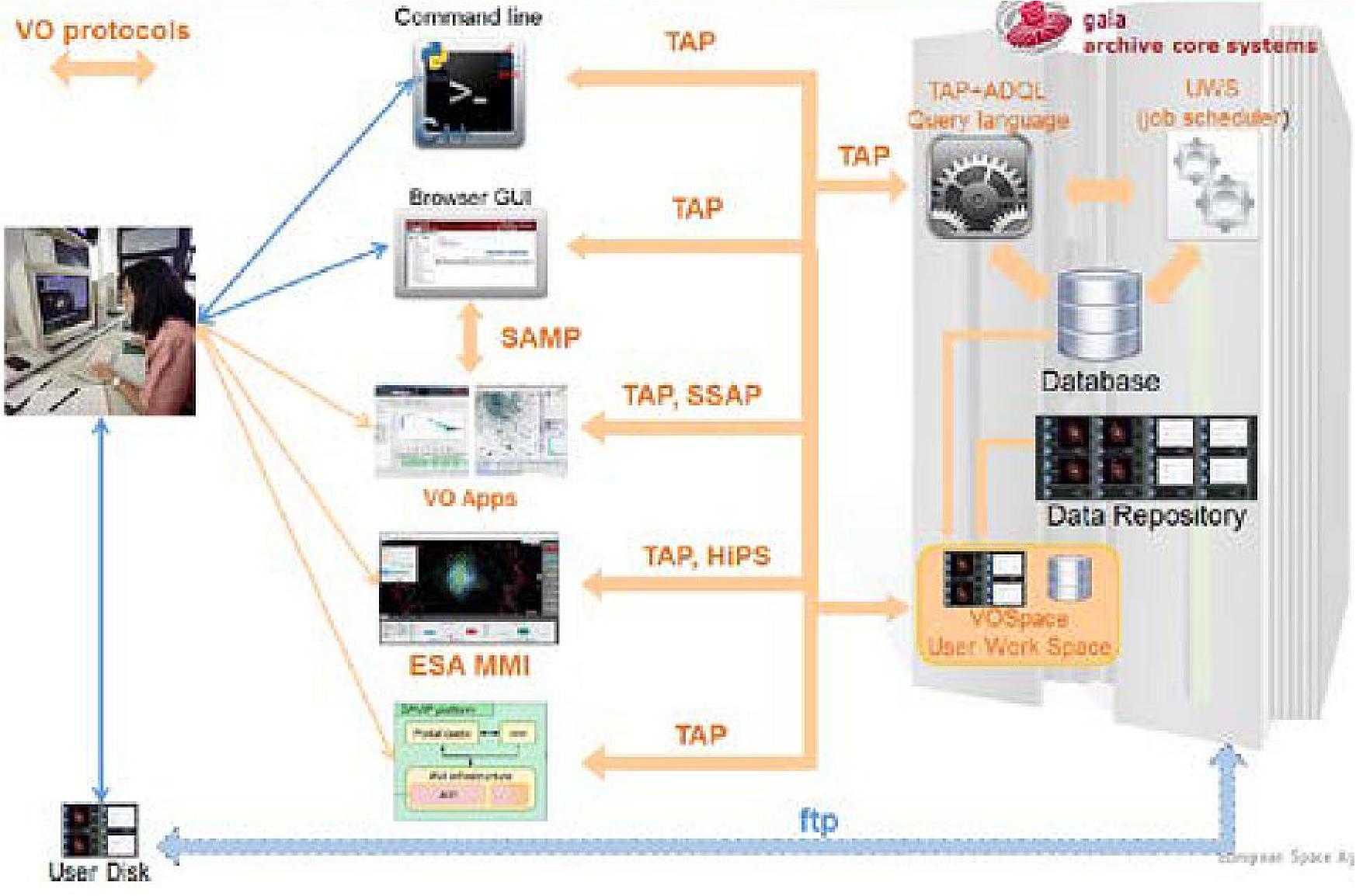
A similar mechanism is provided for meta data storage. If the user would download the results of a complex search (i.e., returning millions of entries) on her/his computer, she/he will probably need to ingest these into a local database to continue to work on them. It appears then more efficient to provide to the user some space directly within the Gaia archive database to store the results of her/his searches. As such, the user "database" becomes VO compliant and shareable as well with any other Gaia archive user.
Overall, the Gaia archive architecture depicted in Figure 73 has been built around these VO protocols and has become the first "VO built-in" archive. By design, the Gaia archive also becomes immediately interoperable with any other VO compliant archive and application.
Gaia AVIs (Added Value Interfaces)
The user workspace can be brought one step further to enable the user to also run her/his own code directly on the Gaia archive through so called "Gaia Added Value Interfaces" (Gaia AVIs, Figure 74). Four AVI demonstrators are currently being developed for transient alerts, advanced visualisation, spectral classification and temporal analysis. These AVIs will run using containers (Docker) and will make use of the Gaia Archive VO built-in protocols (TAP, VOSpace). A Gaia AVI Portal will be created and users will be able deposit their own code and can run it on their data located into their user workspace (VOSpace and database). AVI templates will be provided to help the user to develop their own AVIs.
The Gaia AVI project is currently being developed as a proof of concept project to be delivered in 2017 and could become the new framework for collaborative "Archive 2.0".
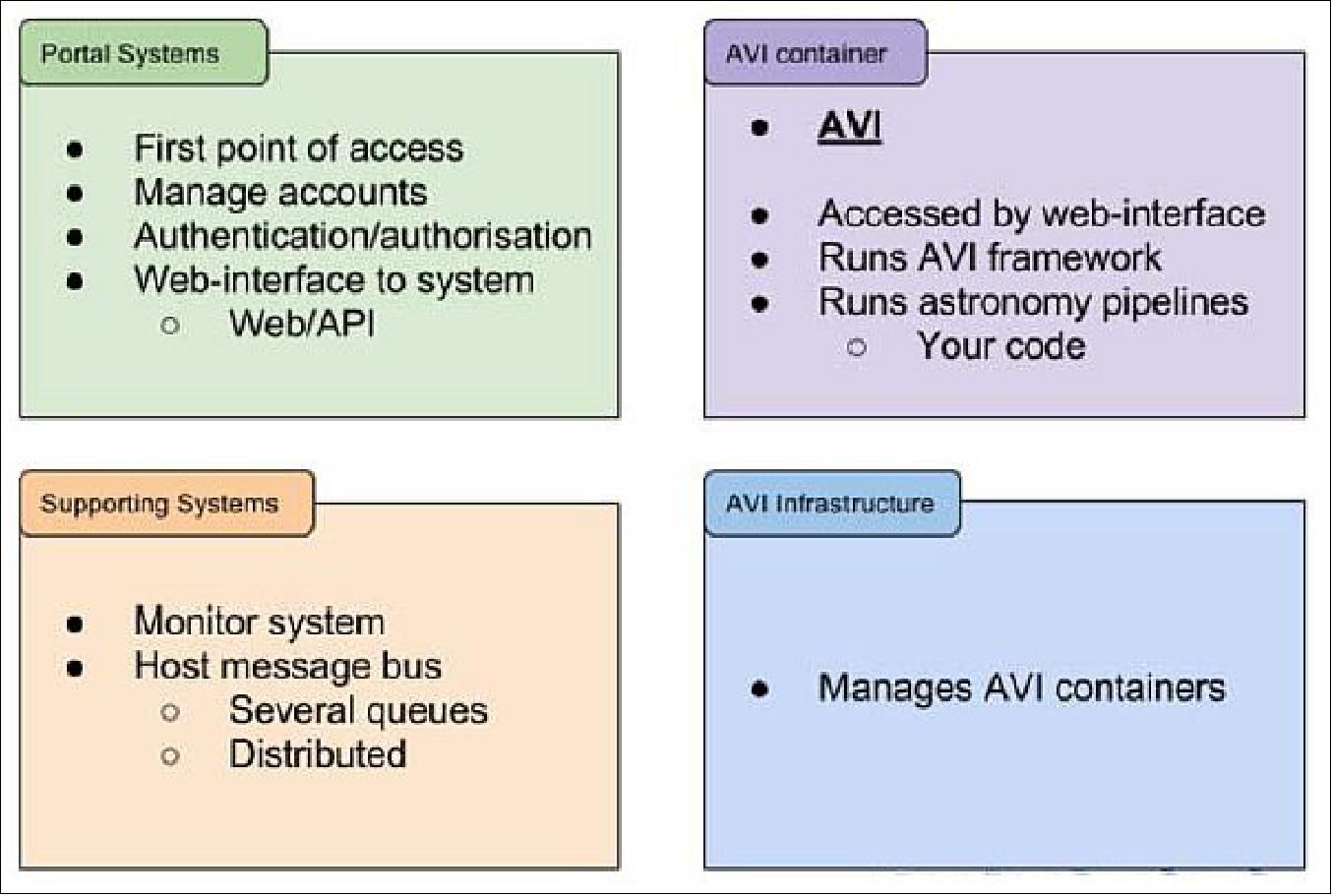
Big Data Visualisation
Before being able to search for Gaia data, it might be really helpful to provide visualisation of the Gaia data in various ways, such as density maps, 1D histograms (Figure 75) or again interactive visualisation through VO application (Aladin Lite), integrated into the archive GUI, through another VO protocol SAMP (Simple Application Messaging Protocol). The production of such graphs requires the use of big data reduction techniques, such as Map / Reduce. With 10 parallel threads on a powerful machine with big RAM (1TB), fast disks (PCIe SSDs with fast random IO) and efficient database (PostgreSQL), the production of the density maps for the GUMS simulated catalogue (2.14 billion rows) took less than 2 minutes and the ones for the IGSL (1.22 billion rows) as little as 65 seconds.
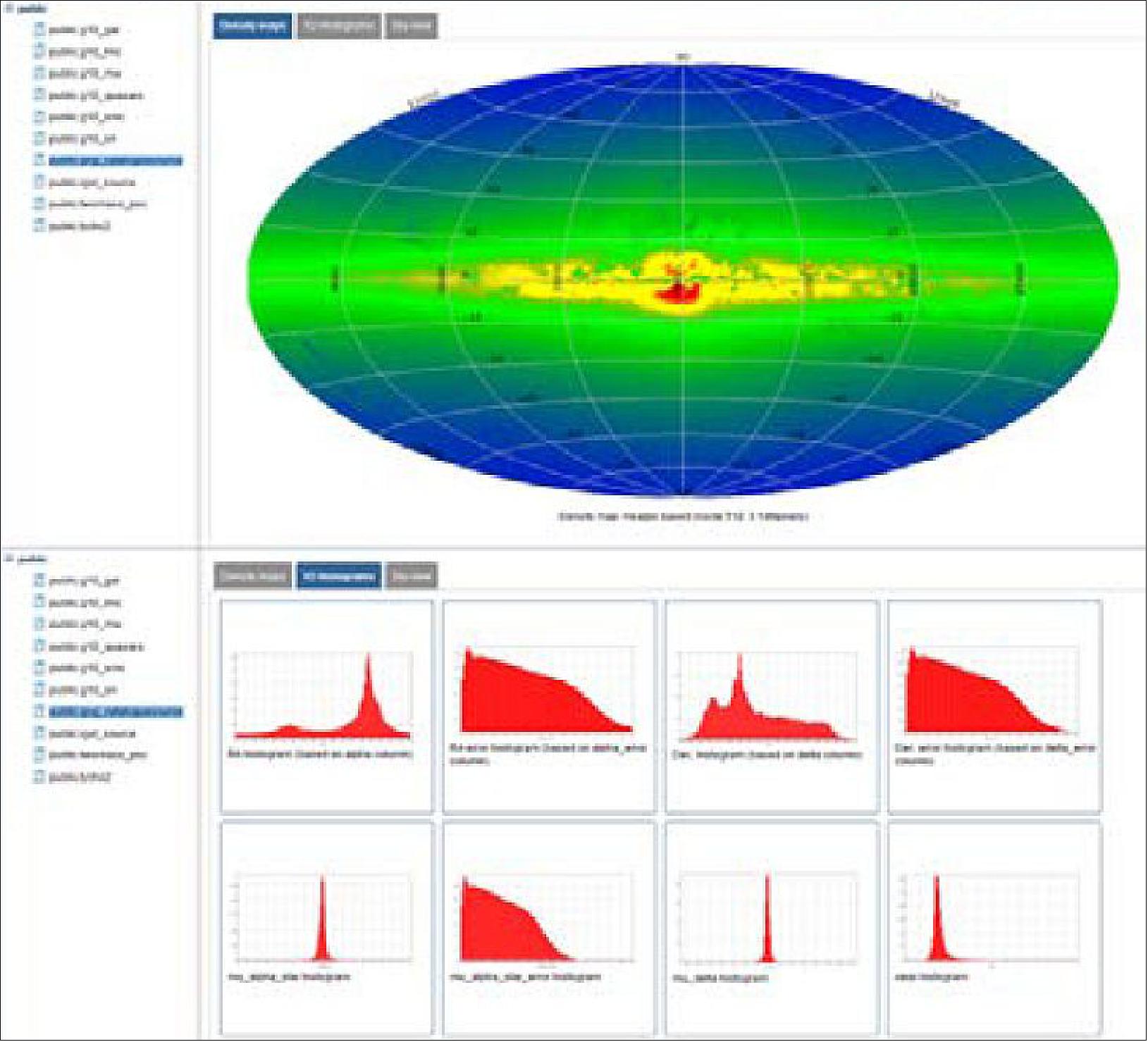
Another way to visualise Gaia data will be through the recently released science-driven discovery portal for all the ESA Astronomy Missions called "ESA Sky" that allow users to explore the multi-wavelength sky and to seamlessly retrieve science-ready data in all ESA Astronomy mission archives from a web application without prior-knowledge of any of the missions. Among other things, the system offers progressive multi-resolution all-sky projections of full mission datasets using a new generation of HiPS (Hierarchical Progressive Survey) files. HiPS is based on the HEALPix sky tessellation and is essentially a mapping of survey data at various spatial resolutions into a collection of HEALPix tiles. It is particular adapted to big data visualisation as it allows a dedicated client/browser tool to access and display a survey progressively, based on the principle that "the more you zoom in on a particular area the more details show up".
Summary: Gaia, ESA's cornerstone mission currently in operations, represents one of the major big data challenge in astronomy to date. A totally new archive architecture (both hardware and software) has been developed to tackle this challenge. It results into one of the first VO built-in science archive, paving the way towards flexible, open and interoperable archive services. The user will work directly with the data in the archive through dedicated user workspace, without the need to transfer it to her/his location, She/he will be able to become an actor of the archive with the possibility to bring her/his code to the data and share it with other archive users. This new "Archive 2.0" concept will be the mean to fully exploit the science legacy of the Gaia mission.
References
1) "Gaia Overview," ESA, June 19, 2013, URL: http://www.esa.int/Our_Activities/Space_Science/Gaia_overview
2) S. Clark, "Gaia - ESA's Galactic Census," ESA brochure, BR-296, June 2012, URL: http://sci.esa.int/gaia/50670-gaia-esa-s-galactic-census-esa-br-296/#
3) M.A.C. Perryman, O. Pace, "Gaia – Unravelling the Origin and Evolution of Our Galaxy," ESA Bulletin 103, August 2000, URL: http://www.esa.int/esapub/bulletin/bullet103/perryman103.pdf
4) Philippe Gare, Giuseppe Sarri, Rudolf Schmidt, "ESA's 'Billion-Pixel' Camera - The challenges of the Gaia mission," ESA Bulletin, No 137, February 2009, pp.50-59, URL: http://www.esa.int/esapub/bulletin/bulletin137/bul137g_sarri.pdf
5) "Gaia - Science with 1 billion objects in three dimensions," ESA, URL: http://www.cosmos.esa.int/web/gaia/home
6) Eric Maliet, Philippe Charvet, François Chassat, Giuseppe Sarri, Robert Furnell, Timo Prusti, "Gaia spacecraft in-orbit commissioning status," Proceedings of the 65th International Astronautical Congress (IAC 2014), Toronto, Canada, Sept. 29-Oct. 3, 2014, paper: IAC-14.A7.1.4
7) Note: The Hipparcos mission is named after the ancient Greek astronomer Hipparchus who, in 129 BC and using only naked eye observations and simple geometry, catalogued the relative positions of around one thousand stars.
8) M. McCaughrean (editor), "ESA's Report to the 39th COSPAR Meeting," (ESA SP-1323, June 2012), pp. 321-324, URL: http://sci.esa.int/home/50671-esa-report-to-the-39th-cospar-meeting-esa-sp-1323/#
9) "Guide to our Galaxy," ESA, Nov. 21, 2013, URL: http://spaceinvideos.esa.int/Videos/2013/11/Guide_to_our_Galaxy
10) L. Lindegren, M. A. C. Perryman, "GAIA Global Astrometric Interferometer for Astrophysics, A Concept for an ESA Cornerstone Mission," 1995, URL: http://gaia.obspm.fr/IMG/pdf/Lindegren_Perryman_1995.pdf
11) "Gaia launch postponement update," ESA, Oct. 23, 2013, URL: http://www.esa.int/Our_Activities/Space_Science/Gaia/Gaia_launch_postponement_update
12) Devin Powell, "Europe's Star Power," Nature, Vol. 502, October 3, 2013, URL: http://www.nature.com/polopoly_fs/1.13859!/menu/main/topColumns/topLeftColumn/pdf/502022a.pdf
13) "Gaia Fact Sheet," ESA, June 19, 2013, URL: http://www.esa.int/Our_Activities/Space_Science/Gaia/Gaia_factsheet
14) "Spacecraft development," EADS Astrium, Nov. 2007, URL: http://www.astro.lu.se/ELSA/pages/PublicDocuments/Moisson.pdf
15) S. Clark, K. Fletcher, "Gaia - ESA's Galactic Census," ESA brochure, Vol. BR-296, June 15, 2012, URL: http://sci.esa.int/gaia/50670-gaia-esa-s-galactic-census-esa-br-296/#
16) https://web.archive.org/web/20150116183538/http://www.space-airbusds.com/media/document/gaia-data-sheet.pdf
17) "Industrial involvement in the Gaia spacecraft," ESA, URL: http://sci.esa.int/gaia/49708-industrial-team/
18) " .....In the world of Gaia," URL: http://hvossgaia.wordpress.com/
19) Patrick Blau, "Gaia Spacecraft Overview," Spaceflight 101, URL: http://www.spaceflight101.com/gaia-spacecraft-overview.html
20) "The Gaia Spacecraft and Instruments," ESA, URL: http://www.rssd.esa.int/SA/GAIA/docs/posters/InstrumentsNoAuthor.pdf
21) Giuseppe Sarri, Timo Prusti, Ared Schnorhk, "ESA's Billion-Star Surveyor: Gaia Ready for Launch Campaign," ESA Bulletin 155, August 2013, pp. 2-11, URL: http://esamultimedia.esa.int/multimedia/publications/ESA-Bulletin-155/
22) "Service Module," ESA, June 14, 2013, URL: http://www.esa.int/Our_Activities/Space_Science/Gaia/Service_module
23) "Service Module Summary," ESA, URL: http://sci.esa.int/gaia/40130-service-module/?fbodylongid=1910
24) "Gaia mission summary," ESA, URL: http://sci.esa.int/gaia/28820-summary/
25) "Gaia Mission - General Overview," ESA, April 13, 2015, URL: http://www.sscspace.com/gaia-mission-general-overview
26) "Gaia Flight Model Payload Data Handling Unit Delivered and Integrated," ESA, May 23, 2013, URL: http://sci.esa.int/gaia/51777-09-gaia-flight-model-payload-data-handling-unit-delivered-and-integrated/
27) Christophe Delay, Stephane Humbert, "1 Tbit of data serviced by SpW," Proceedings of the 5thInternational SpaceWire Conference 2013, Gothenburg, Sweden, June 10 - 14, 2013, pp: 167-170, URL: http://2013.spacewire-conference.org/downloads/SpW2013ProceedingsFinal.pdf
28) A. Polli, G. Noci, L. Ceruti, L. Fallerini, A. Atzei, "European Cold Gas Micro Propulsion System reached TRL-9 on board Gaia S/C. Discussion on in flight performance and system flexibly and capabilities, for being implemented in other missions requiring ultra-fine satellite positioning and attitude control," Proceedings of the 65th International Astronautical Congress (IAC 2014), Toronto, Canada, Sept. 29-Oct. 3, 2014, paper: IAC-14,C4,3.3
29) Raffaele Vitulli, Enrico Magli, Sean Blair, "Putting the squeeze on : How data compression can stop space missions drowning in data," ESA Bulletin, No 158, May 2014, pp: 48-59, URL: http://www.esa.int/About_Us/ESA_Publications/ESA_Bulletin_158_May_2014
30) "GTD's successful delivery of the product named GOCA to ESA/ESTEC," Feb. 26, 2008, URL: http://www.gtd.eu/fr/news-and-events/gtds-successful-delivery-product-named-goca-esaestec
31) Information provided by Jordi Portell i de Mora - Gaia Team at IEEC-UB Dept. Física Quàntica i Astrofísica, Universitat de Barcelona, Spain
32) "IEEC post on GOCA," URL: http://www.ieec.cat/project/gaia/
33) "Gaia Data Release 1 (DR1)," ESA and Gaia Data Processing and Analysis Consortium, Sept. 20, 2016, URL: http://gaia.esac.esa.int/documentation/GDR1/pdf/GaiaDR1_documentation_D.0.pdf ( see Video Processing Unit and Algorithms on p. 23)
34) "Gaia secured inside fairing," ESA, Dec. 13, 2013, URL: http://www.esa.int/Our_Activities/Space_Science/Gaia/Gaia_secured_inside_fairing
35) "Liftoff for ESA's billion-star surveyor," ESA PR 44-2013, December 19, 2013, URL: http://sci.esa.int/gaia/53536-esa-pr-44-2013-liftoff-for-esas-billion-star-surveyor/
36) "Next stop ..... the stars! Arianespace successfully lofts Gaia on Soyuz," Arianespace, Decmber 19, 2013, Soyuz Flight VS06, URL: http://www.arianespace.com/news-mission-update/2013/1120.asp
37) Giuseppe Sarri, Timo Prusti and Ared Schnorhk, "ESA's Billion-Star Surveyor, Gaia ready for launch campaign," ESA Bulletin, No 155, August 2013, pp. 2-11
38) "Gaia data release 3: exploring our multi-dimensional Milky Way," ESA Science & Exploration, 13 June 2022, URL: https://www.esa.int/ESA_Multimedia/Videos/2022/06/Gaia_data_release_3_exploring_our_multi-dimensional_Milky_Way
39) "Gaia sees strange stars in most detailed Milky Way survey to date," ESA Science & Exploration, 13 June 2022, URL: https://www.esa.int/Science_Exploration/Space_Science/Gaia/Gaia_sees_strange_stars_in_most_detailed_Milky_Way_survey_to_date
40) "Gaia – ESA's billion star surveyer," ESA Science & Exploration, 13 May 2022, URL: https://www.esa.int/ESA_Multimedia/Videos/2022/05/Gaia_ESA_s_billion_star_surveyer
41) "Gaia finds parts of the Milky Way much older than expected," ESA Science & Exploration, 23 March 2022, URL: https://www.esa.int/Science_Exploration/Space_Science/Gaia/Gaia_finds_parts_of_the_Milky_Way_much_older_than_expected
42) Maosheng Xiang & Hans-Walter Rix, "A time-resolved picture of our Milky Way's early formation history," Nature, Volume 603, pp: 599-603, Published: 23 March 2022, https://doi.org/10.1038/s41586-022-04496-5, URL: https://www.nature.com/articles/s41586-022-04496-5.pdf
43) "Gaia snaps photo of Webb at L2," ESA Science & Exploration, 16 March 2022, URL: https://www.esa.int/Science_Exploration/Space_Science/Gaia/Gaia_snaps_photo_of_Webb_at_L2
44) "Gaia reveals a new member of the Milky Way family," ESA Science & Exploration, 17 February 2022, URL: https://www.esa.int/ESA_Multimedia/Images/2022/02/Gaia_reveals_a_new_member_of_the_Milky_Way_family
45) Khyati Malhan, Rodrigo A. Ibata, Sanjib Sharma, Benoit Famaey, Michele Bellazzini, Raymond G. Carlberg, Richard D'Souza, Zhen Yuan, Nicolas F. Martin, and Guillaume F. Thomas, "The Global Dynamical Atlas of the Milky Way Mergers: Constraints from Gaia EDR3–based Orbits of Globular Clusters, Stellar Streams, and Satellite Galaxies," The Astrophysical Journal, Volume 926, Number 2, Published: 17 February 2022, https://doi.org/10.3847/1538-4357/ac4d2a, URL: https://iopscience.iop.org/article/10.3847/1538-4357/ac4d2a/pdf
46) "Colliding star clusters," Physics Today, 3 January 2022, URL: https://physicstoday.scitation.org/do/10.1063/PT.6.1.20220103a/full/
47) Andrés E Piatti, Khyati Malhan, "First evidence of a collision between two unrelated open clusters in the Milky Way," Monthly Notices of the Royal Astronomical Society: Letters, slab130, Published: 13 December 2021, https://doi.org/10.1093/mnrasl/slab130
48) "Texas Astronomers Discover Strangely Massive Black Hole in Milky Way Satellite Galaxy," UT News, 1 December 2021, URL: https://news.utexas.edu/2021/12/01/texas-astronomers-discover-strangely-massive-black-hole-in-milky-way-satellite-galaxy/
49) M. J. Bustamante-Rosell, Eva Noyola, Karl Gebhardt, Maximilian H. Fabricius, Ximena Mazzalay, Jens Thomas, and Greg Zeimann, "Dynamical Analysis of the Dark Matter and Central Black Hole Mass in the Dwarf Spheroidal Leo I," The Astrophysical Journal, Volume 921, Number 2, Published: 5 November 2021, https://doi.org/10.3847/1538-4357/ac0c79
50) "Gaia reveals that most Milky Way companion galaxies are newcomers to our corner of space," ESA Science & Exploration, 24 November 2021, URL: https://www.esa.int/Science_Exploration/Space_Science/Gaia/Gaia_reveals_that_most_Milky_Way_companion_galaxies_are_newcomers_to_our_corner_of_space
51) Francois Hammer, Jianling Wang, Marcel S. Pawlowski, Yanbin Yang, Piercarlo Bonifacio, Hefan Li, Carine Babusiaux and Frederic Arenou,"Gaia EDR3 Proper Motions of Milky Way Dwarfs. II Velocities, Total Energy, and Angular Momentum," The Astrophysical Journal, Volume 922, Number 2, Published: 24 November 2021, https://doi.org/10.3847/1538-4357/ac27a8
52) "Stream of stars extends thousands of light-years across the Milky Way," Space Daily, 8 June 2021, URL: https://www.spacedaily.com/reports/Stream_of_stars_extends_thousands_of_light_years_across_the_Milky_Way_999.html
53) L. G. Bouma, J. L. Curtis, J. D. Hartman, J. N. Winn, & G. Á. Bakos, "Rotation and Lithium Confirmation of a 500 Parsec Halo for the Open Cluster NGC 2516," the paper has been submitted to the journals of the American Astronomical Society (AAS) and will be shared with the media at the 238th AAS meeting on Monday, June 7, 2021.
54) "Astronomers Release New All-Sky Map of Milky Way's Outer Reaches," NASA/JPL News, 21 April 2021, URL: https://www.jpl.nasa.gov/news/astronomers-release-new-all-sky-map-of-milky-ways-outer-reaches?utm_source=iContact&utm_medium=email&utm_campaign=nasajpl&utm_content=daily20210421-3
55) Charlie Conroy, Rohan P. Naidu, Nicolás Garavito-Camargo, Gurtina Besla, Dennis Zaritsky, Ana Bonaca & Benjamin D. Johnson, "All-sky dynamical response of the Galactic halo to the Large Magellanic Cloud," Nature, Volume 592, pp: 534-536, Published: 21 April 2021, https://doi.org/10.1038/s41586-021-03385-7
56) "Is the nearest star cluster to the Sun being destroyed?," ESA Science & Exploration, 24 March 2021, URL: https://www.esa.int/Science_Exploration/Space_Science/Gaia/Is_the_nearest_star_cluster_to_the_Sun_being_destroyed
57) Tereza Jerabkova, Henri M. J. Boffin, Giacomo Beccari, Guido de Marchi, Jos H. J. de Bruijne and Timo Prusti, "The 800 pc long tidal tails of the Hyades star cluster - Possible discovery of candidate epicyclic overdensities from an open star cluster," Astronomy & Astrophysics, Volume 647, Article No A137, Published online: 24 March 2021, https://doi.org/10.1051/0004-6361/202039949
58) "Gaia's new data takes us to the Milky Way's anticenter and beyond," ESA / Science & Exploration / Space Science / Gaia, 03 December 2020, URL: https://www.esa.int/Science_Exploration/Space_Science/Gaia/Gaia_s_new_data_takes_us_to_the_Milky_Way_s_anticentre_and_beyond
59) "Gaia Data Processing and Analysis Consortium," ESA Science & Exploration, 3 December 2020, URL: https://www.esa.int/ESA_Multimedia/Images/2020/12/Gaia_Data_Processing_and_Analysis_Consortium
60) "Star Clusters are only the tip of the iceberg," University of Vienna Press Release, 15 October 2020, URL: https://medienportal.univie.ac.at/presse/aktuelle-pressemeldungen/detailansicht/artikel/star-clusters-are-only-the-tip-of-the-iceberg/
61) Stefan Meingast, João Alves, and Alena Rottensteiner, "Extended stellar systems in the solar neighborhood, Discovery of coronae of nearby star clusters," Accepted for Publication in Astronomy & Astrophysics, manuscript as of October 2, 2020, URL: https://www.aanda.org/articles/aa/pdf/forth/aa38610-20.pdf
62) "Preliminary info on Gaia EDR3 contents," ESA, 14 July 2020, URL: https://www.cosmos.esa.int/web/gaia/news
63) "Gaia revolutionizes asteroid tracking," ESA Safety & Security, 1 July 2020, URL: https://www.esa.int/Safety_Security/Gaia_revolutionises_asteroid_tracking
64) "Chance of finding young Earth-like planets higher than previously thought, say Sheffield scientists," The University of Sheffield News, 5 June 2020, URL: https://www.sheffield.ac.uk/news/nr/finding-earth-like-planets-physics-astronomy-sheffield-1.890298
65) Amy L. Bottrill, Molly E. Haigh, Madeleine R. A. Hole, Sarah C. M. Theakston, Rosa B. Allen, Liam P. Grimmett, and Richard J. Parker, "Exoplanet Detection and Its Dependence on Stochastic Sampling of the Stellar Initial Mass Function," The Astrophysical Journal, Volume 895, Number 2, Published: 5 June 2020, https://doi.org/10.3847/1538-4357/ab8e39
66) "Unlocking clues to the origins of the stars," University of Leeds, Science News, 4 June 2020, URL: http://www.leeds.ac.uk/news/article/4602/unlocking_clues_to_the_origins_of_the_stars
67) M. Vioque, R. D. Oudmaijer, M. Schreiner, I. Mendigutía, D. Baines, N. Mowlavi and R. Pérez-Martínez, "Catalogue of new Herbig Ae/Be and classical Be stars," Astronomy & Astrophysics, Volume 638, 4 June 2020, https://doi.org/10.1051/0004-6361/202037731
68) "Galactic crash may have triggered Solar System formation," ESA / Science & Exploration / Space Science / Gaia, 25 May 2020, URL: http://www.esa.int/Science_Exploration/Space_Science/Gaia/Galactic_crash_may_have_triggered_Solar_System_formation
69) Chris W. Purcell, James S. Bullock, Erik J. Tollerud, Miguel Rocha & Sukanya Chakrabarti, "The Sagittarius impact as an architect of spirality and outer rings in the Milky Way," Nature, Volume 477, pp: 301-303, 14 September 2011, https://doi.org/10.1038/nature10417
70) Tomás Ruiz-Lara, Carme Gallart, Edouard J. Bernard & Santi Cassisi, "The recurrent impact of the Sagittarius dwarf on the star formation history of the Milky Way," Nature Astronomy, 25 May 2020, https://doi.org/10.1038/s41550-020-1097-0
71) "Gaia DR2 - second anniversary," Cosmos ESA, 25 April 2020, URL: https://www.cosmos.esa.int/web/gaia
72) "Gaia newsletter #10," Cosmos ESA, 20 March 2020, URL: https://www.cosmos.esa.int/web/gaia/newsletter/contents#GaiaNewsletter10
73) "Milky Way's warp caused by galactic collision, Gaia suggests," ESA / Science & Exploration / Space Science / Gaia, 2 March 2020, URL: http://www.esa.int/Science_Exploration/Space_Science/Gaia/Milky_Way_s_warp_caused_by_galactic_collision_Gaia_suggests
74) E. Poggio, R. Drimmel, R. Andrae, C. A. L. Bailer-Jones, M. Fouesneau, M. G. Lattanzi, R. L. Smart & A. Spagna, "Evidence of a dynamically evolving Galactic warp," Nature Astronomy Letter, Published 02 March 2020, https://doi.org/10.1038/s41550-020-1017-3
75) "Kazan University's telescope assists in discovering invisible stars," Kazan University, 13 February 2020, URL: https://kpfu.ru/eng/news-eng/microlensing-event-telescope.html
76) "RIT scientists discover the nearest-known ‘baby giant planet'," RIT (Rochester Institute of Technology), 10 February 2020, URL: https://www.rit.edu/science/news/rit-scientists-discover-nearest-known-baby-giant-planet
77) Global Gaia campaign reveals secrets of stellar pair," ESA / Science & Exploration / Space Science / Gaia, 21.January 2020, URL: http://www.esa.int/Science_Exploration/Space_Science/Gaia/Global_Gaia_campaign_reveals_secrets_of_stellar_pair
78) "Stellar pair discovered in Gaia16aye microlensing event," ESA Science & Exploration, 21 January 2020, URL: http://www.esa.int/Science_Exploration/Space_Science/Gaia/Global_Gaia_campaign_reveals_secrets_of_stellar_pair
79) Ł. Wyrzykowski, P. Mróz, K. A. Rybicki, M. Gromadzki, Z. Kołaczkowski, M. Zieliński, P. Zieliński, N. Britavskiy, A. Gomboc, K. Sokolovsky, S. T. Hodgkin, L. Abe, G. F. Aldi, A. AlMannaei, G. Altavilla, A. Al Qasim, G. C. Anupama, S. Awiphan, E. Bachelet, V. Bakış, S. Baker, S. Bartlett, P. Bendjoya, K. Benson, I. F. Bikmaev, G. Birenbaum, N. Blagorodnova, S. Blanco-Cuaresma, S. Boeva, A. Z. Bonanos, V. Bozza, D. M. Bramich, I. Bruni, R. A. Burenin, U. Burgaz, T. Butterley, H. E. Caines, D. B. Caton, S. Calchi Novati, J. M. Carrasco, A. Cassan, V. Čepas, M. Cropper, M. Chruślińska, G. Clementini, A. Clerici, D. Conti, M. Conti, S. Cross, F. Cusano, G. Damljanovic, A. Dapergolas, G. D'Ago, J. H. J. de Bruijne, M. Dennefeld, V. S. Dhillon, M. Dominik, J. Dziedzic, O. Erece, M. V. Eselevich, H. Esenoglu, L. Eyer, R. Figuera Jaimes, S. J. Fossey, A. I. Galeev, S. A. Grebenev, A. C. Gupta, A. G. Gutaev, N. Hallakoun, A. Hamanowicz, C. Han, B. Handzlik, J. B. Haislip, et al., "Full orbital solution for the binary system in the northern Galactic disc microlensing event Gaia16aye," Astronomy & Astrophysics, Volume 633, January 2020,Article Nr. A98, Published online: 21 January 2020, https://doi.org/10.1051/0004-6361/201935097
80) Mary Todd Bergman, "Interconnected stellar nurseries form the largest gaseous structure ever observed in the Milky Way galaxy," The Harvard Gazette, 7 January 2020, URL: https://enervated/gazette/story/2020/01/largest-gaseous-structure-ever-seen-in-our-galaxy-is-discovered/
81) João Alves, Catherine Zucker, Alyssa A. Goodman, Joshua S. Speagle, Stefan Meingast, Thomas Robitaille, Douglas P. Finkbeiner, Edward F. Schlafly & Gregory M. Green, "A Galactic-scale gas wave in the solar neighborhood," Nature, Published: 07 January 2020, https://doi.org/10.1038/s41586-019-1874-z
82) "Payload Module Summary," ESA, Oct. 12, 2013, URL: http://sci.esa.int/gaia/40129-payload-module/
83) "Spacecraft & Instruments," ESA, URL: http://www.cosmos.esa.int/web/gaia/spacecraft-instruments
84) "Payload module," ESA, URL: http://www.cosmos.esa.int/web/gaia/payload-module
85) Philippe Gare, Giuseppe Sarri, Rudolf Schmidt, "ESA's 'Billion-Pixel' Camera," ESA Bulletin 137, February 2009, URL: http://www.esa.int/esapub/bulletin/bulletin137/bul137g_sarri.pdf
86) Patrick Blau, "Gaia Instrument Information," Spaceflight 101, URL: http://www.spaceflight101.com/gaia-science-instruments.html
87) "Gaia Mission - General Overview," SSC, April 13, 2015, URL: http://www.sscspace.com/gaia-mission-general-overview
88) http://www.cosmos.esa.int/web/gaia/focal-plane
89) http://sci.esa.int/gaia/40129-payload-module/?fbodylongid=1907
90) http://sci.esa.int/gaia/40129-payload-module/?fobjectid=40129&fbodylongid=1909
91) "On the edge of the possible," Gaia blog, ESA, URL: http://blogs.esa.int/gaia/tag/ccd/
92) "Gaia video processing unit test model delivered," ESA, Feb. 13, 2009, URL: http://sci.esa.int/gaia/44228-gaia-video-processing-unit-test-model-delivered/
93) http://www.astrium.eads.net/en/equipment/gdpu-%E2%80%93-general-data-processing-unit.html
94) http://www.esa.int/Our_Activities/Operations/Gaia/%28print%29
95) David Milligan, Andreas Rudolph, Gary Whitehead, Tiago Loureiro, "Gaia Ground Segment Development and Operations Concept," AIAA SpaceOps 2010 Conference, Huntsville, AL, USA, April 25-30, 2010, Vol. 3, ISBN: 978-1-63266-002-2, URL: http://arc.aiaa.org/doi/pdf/10.2514/6.2010-2162
96) http://blogs.esa.int/gaia/
97) Rocio Guerra, "ESAC and the Gaia Catalogue," 2009, URL: http://www.ieec.cat/mediterrania2009/sites/default/files/proceedings/poster_Guerra.pdf
98) "Data Processing," ESA, URL: http://www.cosmos.esa.int/web/gaia/data-processing
99) Anthony G. A. Brown, "Gaia data processing," ESA, Sept. 23, 2013, URL: http://blogs.esa.int/gaia/2013/09/23/gaia-data-processing/
100) Veronique Valette, Kader Amsif, "CNES Gaia Data Processing Centre, a complex operation plan," Proceedings of SpaceOps 2012, The 12th International Conference on Space Operations, Stockholm, Sweden, June 11-15, 2012, URL: http://www.spaceops2012.org/proceedings/documents/id1291264-Paper-001.pdf
101) "List of Institutes involved in DPAC," ESA, URL: http://www.cosmos.esa.int/web/gaia/dpac/institutes
102) Veronique Valette, Benoit Frezouls, "Processing a billiom of star, an organizational challenge," SpaceOps 2014, 13th International Conference on Space Operations, Pasadena, CA, USA, May 5-9, 2014, paper: AIAA 2014-1701, URL: http://arc.aiaa.org/doi/pdf/10.2514/6.2014-1701
103) Christophe Arviset, Javier Durán, Juan González, Raúl Gutiérrez, José Hernández, Uwe Lammers, Bruno Merin, Sara Nieto, William OMullane, Jesús Salgado, Juan Carlos Segovia, "Big Data, Big Challenges and new Paradigm for the Gaia Archive," Proceedings of the 2016 Conference on Big Data from Space - BiDS'16, Santa Cruz de Tenerife, Spain, March 15-17, 2016, pp: 9-12, URL: http://publications.jrc.ec.europa.eu/repository/bitstream/JRC100655/LBNA27775ENN.pdf
Spacecraft Launch Mission Status Payload Module Ground Segment Big Data Archive References Back to top